
What’s new in tractors
90hp+… FEATURE

EQUIPMENT Biggest Quadtrac yet roars into town

EQUIPMENT
Claas Disco 9700 handles slopes, odd-shaped paddocks



What’s new in tractors
90hp+… FEATURE

EQUIPMENT Biggest Quadtrac yet roars into town

Claas Disco 9700 handles slopes, odd-shaped paddocks



Get fully automatic, ‘hands-free’ turning with the new TurnPath™ unlock on Ag Leader SteerCommand® Z2 automated and SteadySteer® assisted steering systems. TurnPath provides precise and repeatable turns from straight or curved guidance lines, even skipped passes. Combined with all the other benefits of a SteerCommand or SteadySteer steering system, including rapid convergence, sub-inch accuracy and terrain compensation, TurnPath puts you on the path to effortless driving. Contact your Ag Leader dealer and find out how TurnPath and SteerCommand can make farming easier.
Ag (Waikato, BOP & East)
Machinery (Nth & Mid Canterbury)
Agriculture (Southland & Sth Otago)
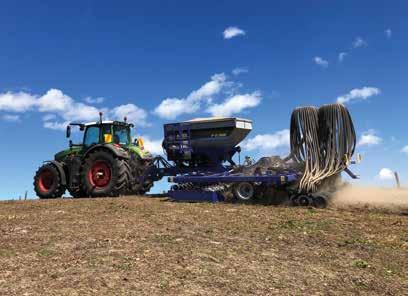

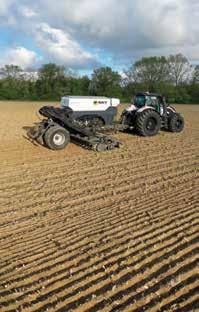
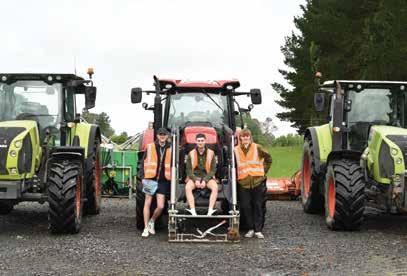

JUNE/JULY 2024
02 From The Editor: Let it be?
INDUSTRY NEWS
3 Waikato woman’s farming career a labour of love
6 New Landpower complex a vote of confidence in NZ agriculture
7 Fendt gets behind young Kiwi for sprint challenge
8 Be prepared this harvest season with Ag Work NZ
10 CEAT agricultural tyres gaining ground in NZ
12 Farmer governance vital to Fertmark’s success
13 Deutz-Fahr guaranteed resale reduces risk in uncertain times
14 Public-private effort to cut farming’s greenhouse gases gains momentum
16 Next generation Fendt 700s getting rave reviews
18 Applause for spray contractor’s health and safety systems
20 Dairy farmers join efforts to protect Wairarapa ecosystems
21 Flagship Power Farming branch showcases JCB construction gear
22 Alternative proteins cast a shadow on NZ agriculture
23 John Deere gives nod to Vapormatic parts
24 Waringa jumps the ditch to offer Kiwis top machinery options
25 Cochranes takes the podium in CNH dealer of year awards
TECHNOLOGY
27 Robots and AI making inroads in ag
28 Battery swapping the route to electric tractors?
29 More capacity for Krone-Lemken autonomous tractor
30 CNH developing farm and fleet data management tool
31 Kiwi-Aussie joint venture develops robotic sprayer for horticulture
32 Another big step toward easy data management for Kiwi farmers
PROFILES
34 Family’s side hustle becomes full-service contracting business
40 Leap of faith gets drone contractor flying
44 Contractor helps Waikato farmers make the most of effluent
50 Across The Ditch: Gillian fennell: The sequin loving bush badass from Outbackistan
FEATURES
54 Special Feature: National Fieldays at Mystery Creek
70 What’s new in tractors 90hp+
EQUIPMENT
86 Claas Disco 9700 handles slopes, odd-shaped paddocks
88 Kubota compact diggers get bouquets from flower grower
90 Deere lubricants deliver peace of mind
92 Biggest Quadtrac yet roars into town
93 T175 the best of farming family’s long line of Valtras
94 New Holland T7245s and BigBaler deliver the goods in hill country
96 Contractor in his comfort zone buying five Deutz-Fahrs at once 95 08 62 30 16

KIA ORA. TWO RECENT ARTICLES IN THE PRESS CAUGHT MY ATTENTION BECAUSE OF THEIR CLASHING MESSAGES.
The first reported on the new government’s moves to repeal some of the previous government’s environmental legislation that applies to agriculture. This includes intensive winter grazing regulations and stock exclusion from watercourses.
The second was on the rising levels of nitrates in groundwater on farms and rural Canterbury towns. There are suspected links between high nitrate levels and both bowel cancer and birth defects. Some families in Selwyn and Waimakariri are drinking bottled water to avoid their well water with high nitrate readings.
The reaction from farmers to the relaxing of environmental restrictions is naturally positive. Comments are along the lines of: ‘end the war on farmers’ and ‘let farmers be farmers’.
But this overlooks the fact that the 2017 Labour-NZ First government came to power in part because it promised to clean up our waterways. Things can’t go back to the way they were.
Farmers’ spokespeople say they want more ‘practical’ ways to deal with environmental regulations. Let’s hope this does not simply mean a lax approach that allows problems to get worse.
A way forward is signalled by Spreadmark accreditor Peter Wood in his article in this issue. Spreadmark is the programme that confirms the accuracy of fertiliser spreaders, which has both economic and environmental benefits. Peter says Spreadmark is successful because farmers have a lot of input and governance on the programme.
There are already efforts to get farmers involved in better environmental management, through catchment boards, for example.
If government and regional councils
can provide the support, perhaps this approach can come up with practical, progressive practices.
Farmers and contractors have access to lots of new technology that can help them farm smarter, cheaper and more accurately. National Fieldays is a great place to check out the latest machines and other gizmos on offer. So check out the Fieldays Preview feature in this issue as well.
On that note, here are your Dad jokes for the month, courtesy of Logan Lisle on YouTube. Nga mihi.
Question: What do you call a magician who has lost his magic? Answer: Ian.
***
I got one of those annoying cold calls from a salesman at a funeral home. He tried to sell me a coffin. I told him that is the last thing I need.
***
It is a 15 minute walk from my house to the pub, but a 45 minute walk from the pub to my house. The difference is staggering.
***
I took my cat’s medicine last night. Don’t ask meow.
***
My geography teacher asked me if I could name a country with no ‘R’ in its name. I told him, “No way.”
***
A man told his friend, “My obese parrot died last night.”
“I am sorry to hear that,” his friend said. “It’s sad but I have to admit it is a big weight off my shoulders,” he replied.
*** I lost my wife’s audio book yesterday. Now I am never going to hear the end of it.
*** I made a chicken salad yesterday. It turns out they prefer grain.
PO Box 36753
Merivale, Christchurch 8146 ph 03 329 6555
www.agrimedia.co.nz
Publishers of Rural Contractor & Large Scale Farmer, AgriBusiness, AgriVet, NZ Cropping, Australian AG Contractor & Large Scale Farmer, NZ Novachem Agrichemical Manual.
© RURAL CONTRACTOR AND LARGE SCALE FARMER - No part of this publication may be reproduced in any form without the prior written permission of the publisher. Opinions expressed in this publication are not necessarily that of the publisher and suggest independent advice be sought before acting on information or suggestions contained herein.
CONTRIBUTIONS - Editorial and photographic contributions are welcomed and should be sent directly to AgriMedia Ltd. Editing of submissions is at the sole discretion of the editor and will accept no responsibility for unsolicited material.
EDITOR
Paul Titus
87 Stanbury Avenue, Christchurch ph (03) 381 6912 mob 021 655 092
email titus@agrimedia.co.nz
ADVERTISING MANAGER
Michael Lightbourne mob 021 403 853
email michael@agrimedia.co.nz
CIRCULATION
email admin@agrimedia.co.nz
PRODUCTION, LAYOUT & DESIGN
Hannah Kincaid
email art@agrimedia.co.nz
CONTRIBUTORS
Joanna Ibell, David Hill, Kathy Davis, Peter Wood, Alastair Hayfield, Heather Chalmers, Rohan Howatson.
Printed by Blueprint Ltd
PAUL TITUS, EDITOREVERY FAMILY WORKS OUT THEIR DIVISION OF LABOUR – WHO DOES WHAT TO KEEP THE HOUSEHOLD RUNNING. FOR BERNADETTE AND PHIL WINTER AND THEIR SEVEN CHILDREN, THIS INCLUDES HIS AND HER FARMS.
The pathway that got them there started when Bernadette was a child and saw a cow being milked at Mystery Creek.
Bernadette’s parents had a market garden in nearby Karapiro. She knew she wanted to work outside and liked animals, and the cow being milked fascinated her.
Her Mum knew a dairy farmer and Bernadette worked for him free after school. Then she went doorknocking and found herself a paid job milking 300 cows. She joined the Farm Cadets and started an apprenticeship in 1990, which included going to polytech.
Bernadette was laser focused on farming, so she attended every class and got top marks. She was nominated for the top cadet award, which was judged on farm and classwork. A male student received the award, however.

ALTHOUGH BERNADETTE WINTER KNEW FROM A YOUNG AGE THAT SHE WANTED TO BE A FARMER, SHE FELT SHE HAD TO WORK TWICE AS HARD AS BLOKES TO BE RECOGNISED IN THE PROFESSION.
“When I started out, we weren’t recognised that well. The guy who won it had never been to class, and he said he had failed everything. I felt I had to work twice as hard to be recognised.”
Her next job was managing a herd of 140 cows in Rotorangi on her own. “That was hard because there was no one else to help get all the jobs done.”
Nevertheless, she completed her Farm Busi-
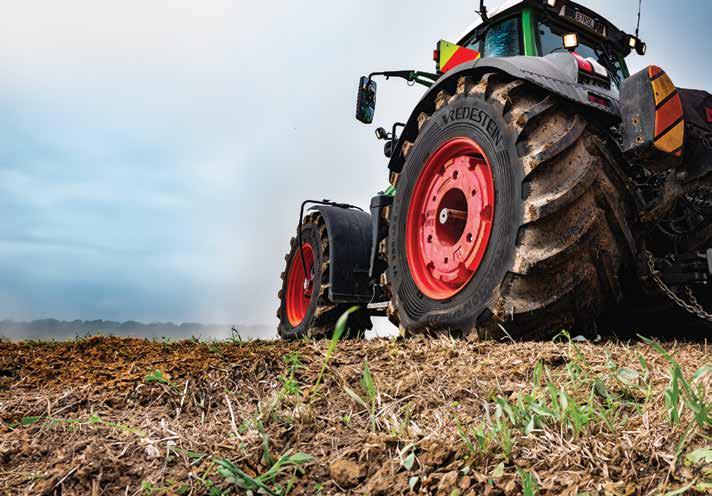
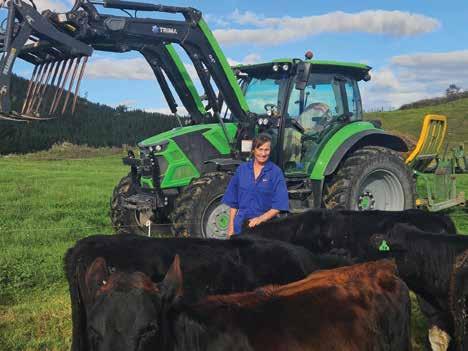
ness Management certificate during that year.
The next management job was 300 cows which was actually easier, because there was another worker on the farm.
Most of the time it was just business as usual, but there was the odd encounter that reminded her some men had to update their attitudes. One example was when the neighbour got his ute stuck and came over for help. He kept asking for the manager and struggled to grasp the concept that he was talking to her.
“He asked how I did everything on the farm. I said that for the heavy stuff I used a tractor just like everyone else. I didn’t see any man lifting 200 litres of bloat oil.”
Another incident was an electrician who kept trying to look past Bernadette to find the manager. You know, the man who really ran the farm.
Bernadette met Phil through Young Farmers. He was then share-milking 160 cows.
They got together and share-milked on a farm in Matamata, before purchasing a farm in Waotu (near Putāruru, South Waikato) in partnership with Phil’s parents. They also share-milked the neighbour’s farm to get ahead.
“We had kids so it was a mission. You have to be organised.”
The best division of labour for them was for Bernadette to be a stay-at-home mum.
“Not that I ever was, with kids needing to be all over the place. But it meant Phil came home to a semi-tidy house and a good meal.”
Bernadette would help on the farm when required, but mostly the farm work was covered by staff.
Nowadays, the kids are aged between 23 and 12 and the Winters have a home farm of 260 ha milking 680 crossbreed cows in Waotu.
In 2018 they bought Bernadette’s farm which is 45 ha, and only 6 km from home.
“The reason we got it was the heifers always came back a bit small. I kept saying we need a run-off.”
This block had been a milking platform with beautiful dairy pasture but needed work.
“I have done lots of fencing. I’m a pretty good fencer I reckon,” Bernadette says.
Phil raises 150 calves until weaning, when half of them go to Bernadette’s farm. About 150 rising two-year-olds are also grazing there.
“I have been rearing 100 kg bigger on average than what we got from the grazier, and one heifer was 200 kg heavier.”

In June the two-year-olds walk back to the main farm, and Bernadette gets the rest of the calves. “Winter is a holiday as there is only one mob of 150 calves.”
They have had fewer empties amongst the two-year-olds as they are bigger (averaging 425 kg) and more able to compete with the older cows.
Phil helps Bernadette with the drenching, but she does everything else, including pasture management, fencing, shifting, feeding, chain-sawing, and trough maintenance.
The joy of having the dry stock is Bernadette is free to arrange her days to fit in with family requirements. She could be on the farm all day, or alternatively shift them early in the morning and then head off to school sports day.
She feeds out with her favourite machine – a Deutz Fahr 6130 with a front-end loader. She uses forks, bucket and soft-hands as well as a mower and a bale feeder.
“We have a big four-wheeler, which is our day-to-day workhorse, but I love the Deutz. The big attractions are the radio and air-conditioning and it is just so comfortable.
“I have done some race work with it, put rock around troughs, and moved trees, but mostly I use it for feeding out.”
Overall, today there is less fuss or surprise about the fact that some farmers are women.
“I do what I do and don’t worry about anyone else. Physically, yes it may take me longer to put in a fencepost than Phil, and some jobs take some creative thinking in the absence of brute force, but I usually work it out.
“Women are far more represented and recognised in farming, including truck driving and contracting, now which is great.
“And why not? If you love it, and you can do it, then gender should not be an issue.”
Bernadette believes farming in general would be better if more people understood what was involved.
“Farming is an apprenticeship like any job. It takes three to four years to know enough to run a farm. People take it for granted.”
That is why it is relaxing being around other farmers who understand about grass growth and its significance, and appreciate all the myriad details and systems that have to be juggled to run a farm.
“The biggest part of farming is being observant. You have got to notice a sick animal, see the grass growth and figure out when you’re going to run short or have a surplus.”
All in all, it has been a good life decision.
“I don’t have issues getting out in the rain. I still love getting out every morning, patting my friendlies and watching the grass grow.
“I love being a woman in farming. I don’t want to do anything else.”
BERNADETTE WINTER DOES ALL OF THE WORK ON THE FAMILY DAIRY FARM’S SUPPORT BLOCK INCLUDING FEEDING OUT, FENCING, CHAINSAWING, AND TROUGH MAINTENANCE.
• 160-380 horsepower
• 4.2m-6.2m working widths
• Capable of reaching greater working depths
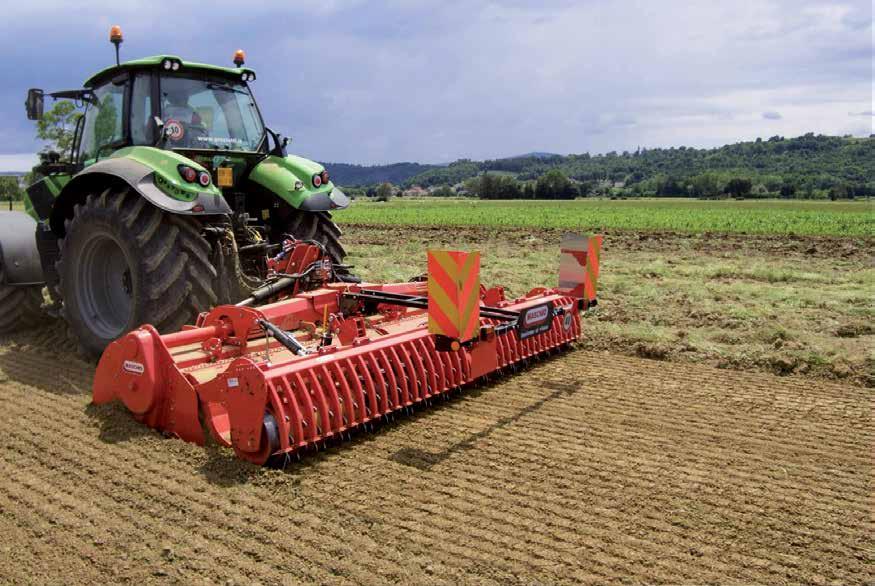
• 120-180 horsepower
• 3.2-4.7m working widths
• Excellent results on hard and dry soils

• 400 horsepower
• 5m-7m working widths
• Increased performance reliability and longevity.
ON A SUNNY AUTUMN DAY IN APRIL, LANDPOWER HELD THE PUBLIC OPENING OF ITS NEW STATE-OF-THE-ART AGRICULTURAL RETAIL HUB AND PARTS WAREHOUSE IN CHRISTCHURCH.
Landpower founder and director Herby Whyte told the guests at the opening that investing in the new building represents a vote of confidence in the future of the agricultural industry. It comes as the company heads into its 50th year in business in 2025.
“I have always had a long-term view and this building is our base for the future. It will allow us to bring more staff into the region for training and career progression, and it shows our commitment to Canterbury agriculture,” Herby said.
On hand to mark the occasion were Claas Group chairperson Cathrina Claas-Mühlhäuser and associate agriculture minister Nicola Grigg, who officially opened the complex.
It is located on West Coast Road in Yaldhurst. It brings together under one roof three former Landpower sites around Christchurch – its retail dealership in Templeton, its New Zealand national support office and parts distribution centre, and its training facility.
The complex also has an area for equipment demonstrations, where farmers and contractors can view and try out equipment first-hand.
LEADERS OF CLAAS AND LANDPOWER PLANTED A TREE TO MARK THE OPENING OF THE NEW RETAIL CENTRE AND NATIONAL PARTS WAREHOUSE IN CHRISTCHURCH.
In his address, Landpower
CEO Richard said the new complex creates efficiencies and will allow Landpower to deliver better products, customer experiences and services to farmers and contractors.
The advanced training facility will allow Landpower to teach more courses for the mechanics and technicians at its 16 New Zealand Claas Harvest Centres and one partner dealer.
These branches provide service and repairs to all of Landpower’s major brands, which include Claas, JCB, Amazone and Grimme.
During the opening, Landpower national parts manager Gavin Wellwood and warehouse manager Dave Cookson showed guests the new parts warehouse, which covers 3725 sqm of floor space. It holds 33,000 line items and has access to additional items from Landpower’s parts warehouse in Melbourne.
The dollar value of the parts in the new warehouse is $43 million. Another $26 million worth of parts is held in the NZ Claas Harvest Centres and the warehouse in Melbourne holds another $65 million worth.
Gavin said the parts team studied parts warehouses at a number of different types of businesses in New Zealand and Australia when designing the new facility. To increase efficiency, 76 percent of the most commonly ordered parts are concentrated in one area of the warehouse.
Landpower technical service manager Mike Parris introduced
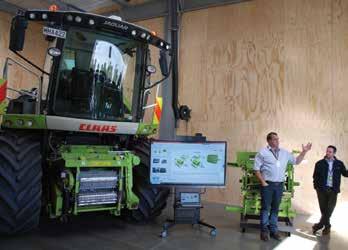
A NEW TRAINING FACILITY WITH TWO TRAINING BAYS WILL ALLOW LANDPOWER TO INCREASE THE NUMBER OF COURSES IT RUNS FOR SERVICE TECHNICIANS.

the guests to the new training facility. It has two training bays and two classrooms and the capacity to double the number of training courses held each year.
Speakers during the opening pointed to the fact that both Claas and Landpower are family-owned businesses.
Cathrina said Landpower has been the sole distributor of Claas machinery in New Zealand since 1987 and in Australia since 1996.
It is one of Claas’s main distribution partners worldwide and the relationship between the two businesses is based on trust.
“As family-owned businesses, we have less room for mistakes. We use our own private capital and we cannot just go to the mar-
HERBY WHYTE AND CATHRINA CLAAS. LANDPOWER HAS DISTRIBUTED CLAAS MACHINERY IN AOTEAROA SINCE 1987 AND IN AUSTRALIA SINCE 1996.
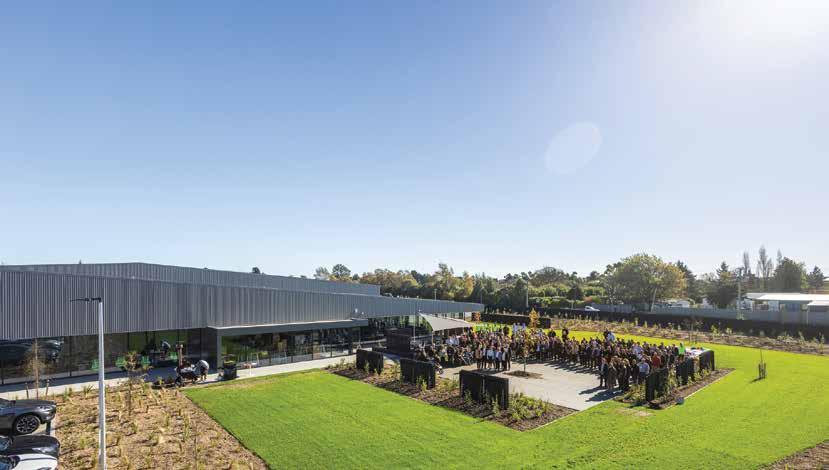
ket to get more.”
Cathrina said like Claas, Landpower has an entrepreneurial spirit. Both companies know that they have to take risks to succeed in business.
“We are not the biggest fish in the pond but we work hard to understand our customers’ business models. We listen to them so that we can be technological leaders.”
FENDT IS SPONSORING NEW ZEALAND RACE CAR DRIVER CLAY OSBORNE IN AUSTRALIA’S PORSCHE MICHELIN SPRINT CHALLENGE, WHICH BEGAN IN APRIL AND EXTENDS THROUGH OCTOBER.
Clay comes from a family that is heavily involved with farm machinery, and in particular with the Fendt brand, through their Waikato-based sales and leasing business, Power and Earth.
Fendt Australia-NZ marketing director Fergal Meehan says Fendt is thrilled to support Clay as he continues his efforts to climb the racing ranks.
“Fendt is a proud German brand that is synonymous with power, precision and advanced technology. Our aim is to deliver the best possible performance for our customers.
“We are proud to be associated with Clay while he’s behind the wheel of a Porsche, another prestigious German brand that is also renowned for outstanding power and performance in their field,” Fergal says.
Clay’s career in motorsport racing began when he was five years old and displayed

a natural ability for kart racing. Since then, he has amassed an impressive collection of championships and titles including winning four NZ Karting Championships and the impressive 2019 World Karting Championship in Italy.
He developed his prowess further in Formula Ford and he recently competed in the Toyota Racing New Zealand 86 Series and the
IS SPONSORING CLAY OSBORNE IN THE 2024 PORSCHE MICHELIN SPRINT CHALLENGE AUSTRALIA.
Porsche Open Class. His impressive results now see him competing in the 2024 Porsche Michelin Sprint Challenge in 2024. When not driving at high speeds around
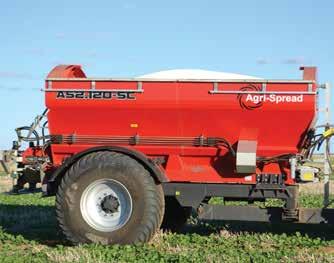
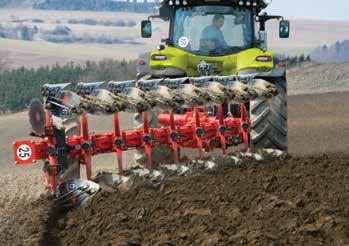

Besson and Highline, plus Broughan
Elmer’s chaser
FENDTFOR MANY CONTRACTORS, THE LOGIC OF BRINGING SKILLED OVERSEAS
WORKERS IN FOR THE BUSY SEASON IS A NO-BRAINER.
HAVING ACCESS TO SKILLED WORKERS IS AN ISSUE MANY AGRICULTURAL BUSINESSES FACE AND RECRUITMENT COMPANY AG WORK NZ IS TACKLING IT HEAD ON.
Providing experienced seasonal workers who can be on-farm at precisely the part of the year when they are really needed is Ag Work NZ’s mission. As a farmer owned and operated business they understand the need to hire workers who are skilled and ready to be part of a team.
Many farmers and contractors look to recruit themselves from overseas, but ensuring that person is suitable and skilled is the tough part. Recruiting from around the world, often through social media, can be testing for many employers.
Many don’t have the time and resources to thoroughly check candidates. Rather than hope for the best, farmers and contractors can work with a specialist recruitment company to make the process easy.
Cambridge-based Ag Work NZ takes a direct contact approach to recruiting. They connect New Zealand farmers and contractors with young people in the UK, Ireland and Europe, who are looking for their ultimate working holiday.
Ag Work NZ’s UK manager Abi Swaffield says the company works with ag contractors, dairy farmers and horticulture busi-
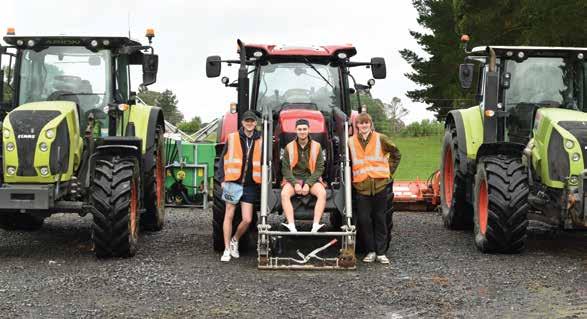
nesses looking for reliable and experienced seasonal employees.
“We offer hassle-free hiring and support to people looking to work in New Zealand. With full flight and visa support, we can guide them through the whole process as seamlessly as possible,” Abi says.
“We have an established office in the UK, so we can contact Northern Hemisphere workers swiftly. We work with trusted sources to find the right people and the reviews we have received from employers are a testament to the success of our approach.”
Ag Work NZ recruits young people in the 18-25 age group from their connections in Europe and the UK. They partner with agricultural colleges and universities and work closely with young farmers groups. They have a large social media presence, which allows candidates to get a taste of what is on offer.
racetracks, Clay has spent many hours in the tractor cab for the family’s machinery leasing business.
“I have grown up around farm machinery. I am humbled and very grateful for the support I have received in my racing career so far. I am very thankful for the team at Fendt for their support in pursuing my ambitions.
I have spent many hours in Fendt tractors
Abi says Ag Work NZ spends about 15 hours with each candidate, interviewing and checking their references. Their matchmaking approach ensures both employers and employees make the right connection for success.
All recruits come into New Zealand through Auckland, where they are met by Ag Work NZ operations manager Paula Syben. Paula helps deliver pastoral care to employees and acts as Ag Work NZ’s employer liaison officer to guide employers through the process.
Based in Cambridge, Paula meets incoming employees at the airport and gets them organised for life in New Zealand. This includes helping with paperwork, opening a bank account, getting an IRD number and SIM card.
“We can organise the onward travel of candidates around New Zealand. We work with North Island and South Island employers and are able to accommodate most needs,” Paula says.
over the years and I am very proud to be representing them on and off the racetrack,” says Clay.
The Porsche Michelin Sprint Challenge Australia was launched in 2008 by a group of passionate enthusiasts. Under the stewardship of Porsche Cars Australia, it has evolved into one of Australia’s premier racing series. This year there are six sessions – in Victo-
“Once a candidate has settled into their life in New Zealand, we are in the background to help with anything and we check in with our employers and candidates regularly.”
Many young people who will work for a contractor arrive in September or October and stay until the end of the season. Workers on dairy farms tend to arrive in the busy June-July period and stay 9-12 months, depending on the role.
Ag Work NZ operates using the Working Holiday Visa option. This allows British and Irish young people to a have year-long working holiday and, in the case of UK residents, it can be extended to as long as three years.
It is not too early to talk with the Ag Work team today about your staffing needs and how they can help find the experienced operators you need.
For further information call Ag Work on 0274 777 267 or email hello@agworknz.com.
ria, South Australia, Queensland, Tasmania and NSW. The series gives budding racers a platform to showcase their talent in the iconic 991.2 GT3 Cup cars. The series embodies a culture of competitiveness and camaraderie. You can keep up-to-date with Clay’s progress in the Australian Porsche Michelin Sprint Challenge through his Instagram page – Clay Osborne.

WE’RE GROWING.
We’ve extended our tractor line-up with all-new models handpicked for the conditions here in New Zealand. We’ve expanded our dealer network to offer you more purchase opportunities and aftersales care. And we’re only just beginning. Ask us how we can help you achieve your farming goals and let’s grow together. FIND
CEAT AGRICULTURAL TYRES ARE MAKING INROADS IN THE NEW ZEALAND MARKET THANKS TO THEIR HIGH PERFORMANCE, QUALITY, SUPPORT AND AFFORDABILITY.
Based in India, CEAT manufactures a growing range of agricultural tyres as well as off-road (OTR) tyres for sectors such as earthmoving, forestry and mining.
For Kiwi farmers and contractors, the CEAT range includes high-spec 60 Series very high flexion (VF) and increased flexion (IF) radial tyres through to specialised row crop and implement tyres.
YHI NZ Ltd is the proud distributor of CEAT agricultural and OTR tyres in New Zealand, and YHI NZ commercial tyres product manager Mark (Skippy) Mackaness says the brand is growing in popularity because of its quality.
“CEAT has been producing tyres for many years. In 2017 they began manufacturing radial agricultural tyres at their dedicated plant in Mumbai with the goal of being a global leader for this product.
“We have been supplying CEAT agricultural tyres into the New Zealand market since 2019. CEAT’s growth has been very exciting. A fair few contractors
now use CEAT tyres on their equipment and the feedback we are getting from them is fantastic,” Mark says.
Along with selling tyres through retail channels globally, CEAT Specialty now supplies original equipment (OE) tyres to such heavy agricultural equipment manufacturers as AGCO, CNH Industrial, John Deere and JCB.
The CEAT company was formed in 1924. It was originally an Italian business but it was acquired by the Indian corporation RPG Group in 1982.
Mark says the success of the company is due to its focus on excellence. He visited the CEAT factory last year and he says the dedication to quality and efficiency was impressive.
“In fact, in 2023 CEAT became the world’s first tyre company to win a Grand Deming Award, which is one of the world’s most prestigious quality awards.
“The Japanese Union of Scientists and Engineers presents the Deming Award to businesses that achieve excellence in apply-
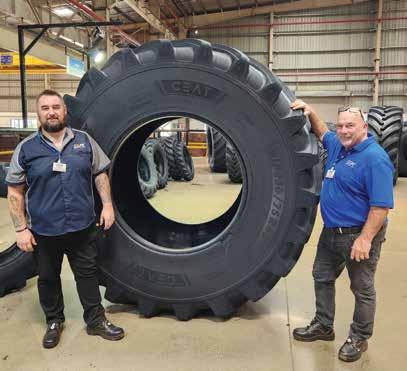
ing the principles of Total Quality Management.”
CEAT’s commitment to research, development and continuous improvement shows through in its product development to suit different terrains and applications.
For example, given the greater number of high speed tractors now at work around the world, CEAT has modified the design and construction to build a range to meet the specifications for 65 kph road travel for longer trips between properties.
They are adding cut-resistant compounds to their full range of tractor and OTR tyres so they are more durable in rocky, harsher terrain.
In short, CEAT agricultural tyres are built to deliver traction, safe road travel, less soil compaction
Established in 1995, YHI (New Zealand) Ltd is a subsidiary of YHI International Ltd. It has Singaporean and New Zealand ownership.
YHI NZ is a diversified business that began supplying alloy wheels and then added a growing number of tyre brands including Toyo, Pirelli, Nitto, Nankang, Accelera, Farroad and Longmarch. CEAT agricultural and industrial tyres are the latest addition to the line-up.
For 25 years YHI has also supplied energy products. Its comprehensive range in this area covers solar panels, batteries, electric vehicle charging systems as well as electrical components for the marine sector and vehicles of all sizes.
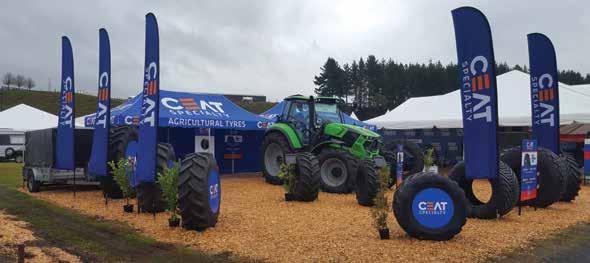
YHI’S MARK MACKANESS (RIGHT) AND DARYL SHUTTLEWORTH NEXT TO A CEAT 800/75R42 TYRE AT THE COMPANY’S MUMBAI FACTORY.
and a long working life.
Mark says CEAT’s 38-inch Farmax rear tractor tyre is the most popular in New Zealand, although the whole range has been well received.
“CEAT tyres are relatively new to the New Zealand market. They are less expensive than many competitor brands, but this does not mean the quality is any lower.
“One way I know that CEAT is a great product for New Zealand is the feedback we get at CEAT exhibits at field days around the country. Farmers and contractors openly give us positive feedback about key points such as road-ability and wear resistance.
“Our customers are nothing but positive about the tyres’ grip, ride and comfort. So, when you are ready to replace you existing tractor or implement tyres, ask your regular tyre supplier about getting a truly hard-working, affordable option from CEAT,” he says.
YHI has 13 warehouses around New Zealand to help support local communities and supply CEAT ag tyres via all major tyre dealers.
THE CEAT AGRICULTURAL RANGE INCLUDES HIGH FLEXION AND INCREASED FLEXION RADIAL TYRES AS WELL AS ROW CROP AND IMPLEMENT TYRES.
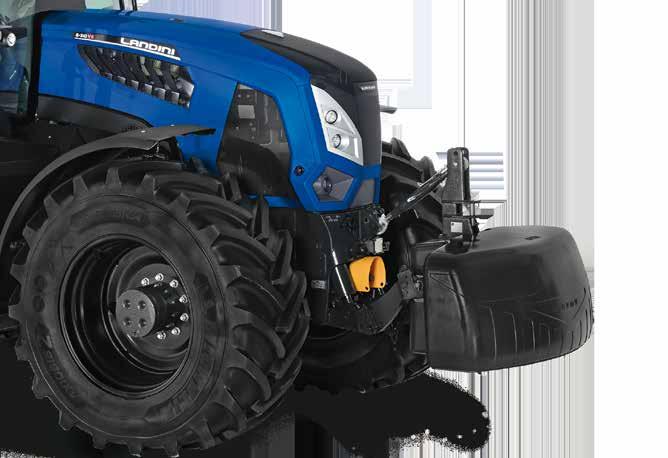
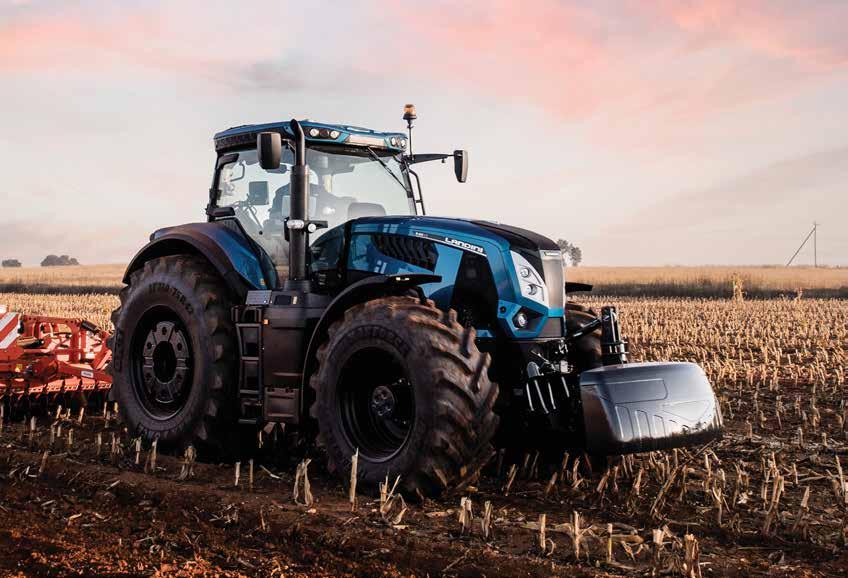
Power through every job with over 300HP of grunt, four-stage V-Shift transmission technology, and a tailor-made hydraulic system. The Landini Series 8 can handle all your farming applications and offers real productivity and efficiency benefits.
Ask us about the Landini Series 8 and let’s grow together.
IN THE EVER-EVOLVING LANDSCAPE OF MODERN AGRICULTURE, SUCCESS IS NOT MERELY MEASURED BY FINANCIAL GAINS BUT ALSO BY THE ADOPTION OF PRACTICES THAT BENEFIT BOTH THE ENVIRONMENT AND THE STAKEHOLDERS INVOLVED.
In the pursuit of sustainable and efficient agriculture, Spreadmark is a beacon of innovation and responsibility.
Spreadmark is a fertiliser placement quality assurance system. It has a dual focus – on maximising agronomic benefits for farmers and minimising environmental harm.
This balanced approach reflects a commitment to optimising yields while safeguarding the environment. It sets a new standard for fertiliser applications in today’s agriculture.
For many, including myself, the role of providing proof of accurate fertiliser spreading is more than mere compliance. It is a multifaceted approach that intertwines environmental sustainability, regulatory adherence, resource efficiency, and the overall image and viability of farming.
It aligns with economic goals but also underscores a commitment to ecological stewardship. It makes accurate fertiliser spreading a cornerstone of modern and responsible farming practices.
The true measure of success is the seamless integration of Spreadmark and Fertmark into farm Quality Assurance (QA) programmes. Synlait’s Lead with Pride programme is a prime example of how farmers can leverage these programmes to earn a significant premium and create a mutually beneficial ecosystem.
Paying a premium to those committed to sustainable practices creates a ripple effect, encouraging wider adoption.
Spreadmark is successful because of its distinctive strength – the robust control and governance wielded by farmers and growers. This unique approach has cemented Spreadmark’s position as a leading programme and it has given tangible benefits to the stakeholders who drive its governance.
Farmer control has been important to the programme’s success and has delivered significant advantages to agricultural processors and the producers who supply them.
At the heart of Spreadmark’s effectiveness is its farmer-driven governance model.

This marks a paradigm shift and puts those directly involved in production at the forefront of decision-making.
This instils a sense of ownership and ensures that the standards set by Spreadmark are practical, realistic and reflective of on-the-ground realities.
By elevating farmers and growers to positions of influence and fostering collaboration across the industry, Spreadmark has established a benchmark for accreditation schemes. It has also become a driving force in promoting sustainable agriculture. Refining these accreditation programmes
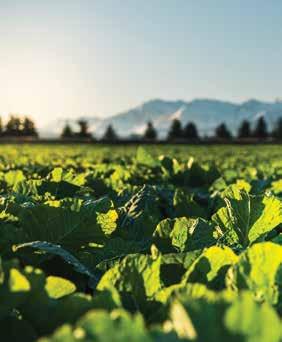
POWER FARMING HAS INTRODUCED A FIRST-OFITS-KIND GUARANTEED
BUY-BACK SCHEME FOR NEW DEUTZ-FAHR TRACTORS. THIS ALL-NEW ‘UPFRONT’ APPROACH
GUARANTEES CUSTOMERS THE RESALE VALUE OF ANY NEW TRACTOR IN THE FULL DEUTZ-FAHR RANGE.
Only available on new tractors that are financed through Power Farming, the Deutz-Fahr guaranteed resale value is based on the tractor’s hours and the term of the finance contract.
Unlike a typical finance, hire or lease programme, at the end of the finance term the customer has the option to retain the tractor, trade it back at the guaranteed resale value, or simply return the tractor to Power Farming. (See Figure 1.)
Power Farming Deutz-Fahr general manager Alistair Horrocks says the buy back guarantee provides farmers and contractors certainty around the total cost of ownership of one of their biggest capital investments.
“At Power Farming we have huge belief in Deutz-Fahr, so much so that we are standing behind the future resale value of the brand,” he says.
Founded in Morrinsville 75 years ago, Power Farming Group is the world’s largest independent distributor for Deutz-Fahr, with 21 dealers in New Zealand, more than 300 in Australia and more than 120 in the United States.
Since launching at the beginning of April, feedback from customers has been very positive, Alistair says.
“Confidence breeds confidence. With today’s market conditions, demonstrating commitment into the future is vital. Under this scheme the buyer knows exactly what their tractor will be worth at the end of the finance term.
“This assurance gives peace of mind and provides a means to accurately quantify the true cost of ownership for their new tractor.”
There is a range of available terms for the finance agreement that underpins the buy back guarantee, which can extend up to five years.
Alistair says after buyers decide which term they prefer, they agree on the finance details with their Power Farming dealer and the number of hours they can use the tractor each year.
“Different deposit, terms and hours options are available. We can even take into account seasonal payments to align with a business’s cash-flow.
“Service contracts can also align with the intended hours and term of the contract. This allows a customer to account for

POWER FARMING SAYS ITS DEUTZ-FAHR BUY BACK GUARANTEE PROVIDES NEW TRACTOR BUYERS PEACE OF MIND AND A MEANS TO ACCURATELY QUANTIFY THEIR MACHINE’S TRUE COST OF OWNERSHIP.
a true hourly cost of ownership and treat the investment as a fixed cost.”
The bottom line with the buy back guarantee is that when you get behind the wheel of your new Deutz-Fahr you know that Power Farming stands behind it and they are assuming a big share of the risk associated with the purchase of any new machine.
Alistair says Power Farming
has represented the Deutz-Fahr brand for 14 years in New Zealand, and the volume of tractors in use throughout the country is a testament to the brand’s success.
Power Farming is offering the buy back guarantee across the full Deutz-Fahr range. It is available through all of Power Farming’s New Zealand dealerships.
to ensure they remain inclusive and representative of the ever-evolving landscape of responsible farming is a step towards a more sustainable and efficient agricultural sector.
As we navigate the complexities of modern farming, Spreadmark’s strengths in governance illuminates its triumph in empowering a more resilient, sustainable and reputable future.
Peter Wood is Spreadmark and Fertmark accreditor with Hamilton-based QCONZ, which provides auditing for animal welfare, environmental, and food safety assurance programmes.
A JOINT VENTURE BETWEEN THE NEW ZEALAND GOVERNMENT AND THE PRIVATE SECTOR THAT AIMS TO HELP FARMERS MEET THEIR CLIMATE CHANGE OBLIGATIONS IS GAINING MORE SUPPORT FROM LEADING KIWI AGRIBUSINESSES.
AgriZeroNZ is a limited liability company that invests in innovative technology that can reduce methane and other greenhouse gas emissions. It was established in early 2023. The Crown made a commitment to match the private companies’ contribution to the fund dollar-for-dollar up to $50 million per year.
The founding businesses that helped set up AgriZeroNZ in partnership with the Crown were ANZCO, Fonterra, Rabobank, Ravensdown, Silver Fern Farms and Synlait. Agriculture Minister Todd McClay says the A2 Milk Company, ANZ Bank, and ASB Bank are now on-board as new shareholders.
With the additional investment from these companies, the investment in AgriZeroNZ will reach $183 million over its first four years. Half of this funding will come from the government.
Todd says this shows the commitment of New Zealand businesses to help farmers find ways to reduce emissions.
“With the backing of both government and private sector, New Zealand will be a global leader in developing tools, technologies, and practices to drive down agricultural emissions while maintaining the productivity and profitability of our food and fibre sector.
“Meeting our climate change obligations and encouraging a booming agricultural sector are not mutually exclusive. Collaborations
HOOFPRINT BIOME CO-FOUNDERS KATHRYN POLKOFF (LEFT) AND SCOTT COLLINS.
such as AgriZeroNZ will ensure that New Zealand’s economy and climate are well served,” Todd says.
AgriZeroNZ executive director Wayne McNee says the fund is looking all over the world for emission reducing technology that will work on New Zealand farms.
“We are moving fast to reflect the mandate for urgent action from our shareholders, and we are taking calculated risks to significantly accelerate efforts made by Kiwi farmers,” Wayne says.
AgriZeroNZ’s goal is to ensure all farmers in Aotearoa have access to affordable, effective solutions to reduce emissions. The aim is to cut agricultural emissions 30 percent by 2030 and drive towards near zero by 2040.
“Farmers will need at least two or three proven tools and technologies in widespread use by 2030 to meet this goal so that’s what we’re working to deliver,” Wayne says.
The most recent investment AgriZeroNZ has made is in Hoofprint Biome, a US startup that is developing probiotics and natural enzymes that reduce methane while improving cow health.
Other investments AgriZeroNZ has made are in two Kiwi companies, BioLumic and Ruminant BioTech.
BioLumic is a biotech company that uses ultraviolet (UV) light to develop more productive crops. It aims to develop low-emissions farm pasture by focusing its technology on ryegrass. Ryegrass with a higher fat content could reduce methane emissions from animals that consume it.
Ruminant BioTech is developing a slow-release, biodegradable methane-inhibiting veterinary medicine for ruminant livestock. A bolus of the material sits in the animal’s stomach for up to six months while active

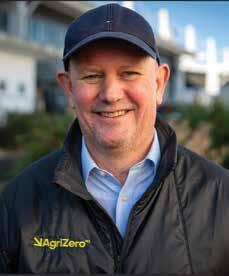
ingredients are released over time. Initial trials show it can reduce emissions by up to 70 percent over that time.
Wayne says AgriZeroNZ has invested NZ$4.1 million into Hoofprint Biome to support development of its probiotic into animal trial proof-of-concept stage.
“Hoofprint Biome is developing novel technology with potential to be a real breakthrough to help meet our country’s climate goals. We’re really pleased to be backing Hoofprint as the lead investor, and secure this opportunity for New Zealand farmers so they can be at the forefront of its future success.”
Hoofprint Biome is a spinoff company from North Carolina State University, founded by Dr Kathryn Polkoff and Dr Scott Collins. The pair discovered enzymes that naturally reduce rumen methane emissions
The patent-pending enzymes are delivered to the animal along with probiotics. When it is fed as a supplement in small doses, the Hoofprint probiotic should reduce enteric methane emissions by over 80 percent but at the same time increase milk and meat yield by over 5 percent.
Kathryn says the investment from AgriZeroNZ offers a unique opportunity for Hoofprint to partner with New Zealand farmers, who have been leaders in sustainable agriculture, so they can tackle the climate crisis together.
AgriZeroNZ has also invested $2.5 million to support New Zealand research on a methane vaccine and methane inhibitor and $4 million to support construction of a new greenhouse gas measurement facility.
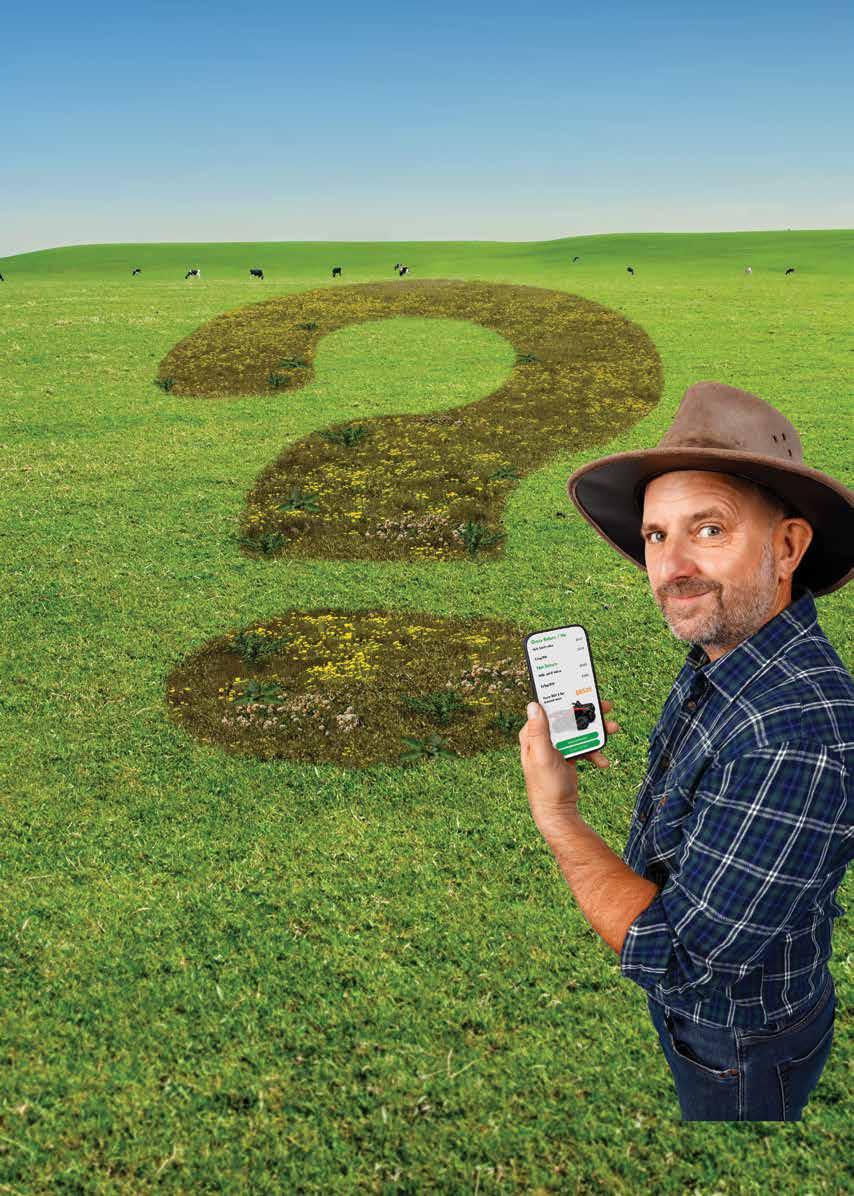
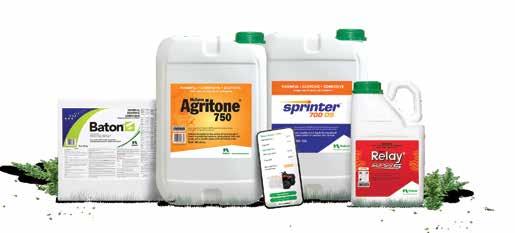
SINCE THE BEGINNING OF 2024, FENDT DEALERSHIPS IN THE NORTH ISLAND HAVE BEEN DEMONSTRATING THE NEW SEVENTH GENERATION FENDT 700 VARIO TRACTORS. THEIR RECEPTION HAS BEEN OUTSTANDING.
The salesmen who have demonstrated Fendt 700 Vario Gen 7 tractors are highly impressed with their power, fuel efficiency and handling. And they say feedback from farmers and contractors has been equally enthusiastic.
For now Fendt has replaced the Fendt 800 Series with the Fendt 700 Gen 7s. The five new 700 models all have a large frame and they span the power range from 203-303 hp.
One of the notable features of the new 700 range is the new 7.5-litre AGCO Power Core engine that delivers high power at low revs especially designed for the Fendt 700 Gen 7.
Another highlight is the VarioDrive transmission. VarioDrive is well-proven in the larger Fendt 900 Vario and 1000 Vario series and it is now available in the 700 Series.
VarioDrive gives variable allwheel drive through Fendt Torque Distribution. The front and rear axles are driven independently,
WITH THEIR VARIODRIVE TRANSMISSION, THE LATEST FENDT 700 TRACTORS DELIVER MAXIMUM TRACTION, LESS DAMAGE TO THE SOIL AND TIGHTER TURNING CIRCLES.
and the transmission automatically distributes power between them to give maximum traction in every situation.
The unique and exclusive VarioDrive transmission gives infinitely variable speeds from 20 m/hour to 60 km/hour. It also creates a pull in effect, which gives the tractor a very small turning circle.
The combination of the new AGCO Power engine and VarioDrive delivers outstanding fuel efficiency, the ability to handle a range of jobs, and a quiet, comfortable driving experience.
John Metcalfe is a sales rep at Waikato Tractors in Hamilton and something of a Fendt specialist. He has been selling Fendt tractors since they were introduced in Aotearoa in the late 1990s.
John says Fendt have always been leaders, not followers, when it comes to tractor technology, and every new generation of Fendts has offered something special. The new 700 Series is no exception. They take performance to another level.
“They are definitely a game changer. Anyone who knows anything about machinery loves the Gen 7 Fendt as soon as they get in it. It is so comfortable and quiet because of the engine

WITH ITS HIGH TORQUE-LOW REV ENGINE, FENDT 700 VARIO GEN7 TRACTORS DO AN EXCELLENT JOB IN CULTIVATION AND DEEP RIPPING JOBS.
and the transmission.
“The big thing you notice is that you get 20 percent more torque at low revs. You can do a job at 12 kph and you are only on 11001200 revs. You need to see it on the screen to believe it because it is so quiet.”
John says the power range that the Fendt 700 Series covers is very popular in Waikato as larger implements have become more common. For example, the new 724 Gen 7 is a direct replacement for the 824 Gen 6.
“The new 700s are so versatile. They have a turning circle as tight as a four-cylinder tractor. They are perfect for a larger dairy farmer who does a lot of their own work.
“They can pull a slurry tanker, do groundwork, run a baler or use a front-end loader. Plus the owner-operator has a machine that is an absolute pleasure to drive.”
James Hannon is dealer principal at AGCO dealership TFM Tractors in Masterton. At the beginning of the year, TFM took on two Fendt 728 Gen 7 tractors, one for demonstrations and one for sale.
A contractor has already bought
the one that was for sale and feedback from customers who have tried the demo model has been “unreal”.
“Fendt is a premium product. Other tractors have to come with a whole lot of spec to meet the quality of a standard Fendt. The new 728 delivers as much power as the 828 Gen 6, but it is smaller so it is more manoeuvrable. Its turning circle is just 10m in diameter,” James says.
“It is super quiet and the ride comfort is amazing. With pneumatic cab suspension and Fendt Stability Control it feels really good on the road. When you are going 50 kph on the road, you would think you are in a car.

“The AGCO Power engine is low rev-high torque. It delivers peak torque at 1300 rpm so it is extremely fuel efficient. The fuel savings are definitely noticeable, whether you are doing PTO work, road work or heavy draft work.”
James says Fendt’s VarioDrive transmission is a big part of the new 700 Series’ performance. It delivers power where it is needed to maintain traction.
“You don’t notice when it is sending power to the front or rear tyres. It is like four-wheel drive on
a car. It also helps pull the front tyres around when turning, which helps make tight turns.
“The power boost is also quite intelligent. It only boosts when the additional power is needed. It is always trying to achieve fuel economy.”
Versatility is another selling point. TFM Tractors has demonstrated the new Fendt 728 on farms with a variety of implements – power harrows, discs, big square balers, heavy direct drills and ploughs.
“The contractor who bought the other new 728 primarily uses it for cultivation and planting but it is so manoeuvrable that it will be more universal than a big lugging tractor. It will happily sit on a combi baler all day,” James says.
Logan Berg is a salesperson at TRC Tractors in Feilding, and he says the response from on-farm demonstrations with the Gen 7 700 Series has been “very positive”.
“The new 728 is the ultimate balance between high horsepower and manoeuvrability. It can handle heavy cultivation but is still a great size for a set of mow-
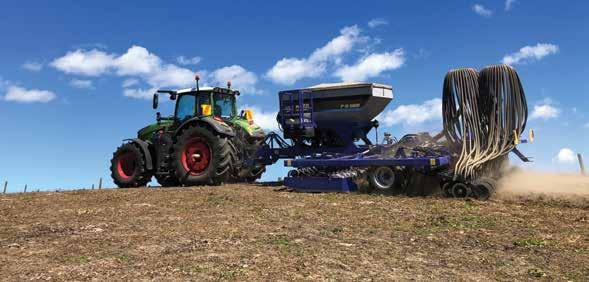
FEEDBACK ON NEW GENERATION FENDT 700S HAS BEEN
VERY POSITIVE BECAUSE THEY PUT OUT THE POWER OF A LARGER TRACTOR BUT ARE STILL NIMBLE ENOUGH TO HANDLE JOBS THAT A SMALLER TRACTOR WOULD NORMALLY DO.
ers or filling in on a smaller implement for a day if you are short of a smaller machine.
“The size of its frame paired with the Vairodrive transmission ensures it pulls extremely well. At one demonstration we ran a 6m set of speed discs. We covered 12 ha in two and a half hours and burnt 55 litres of diesel. That is just over 20 litres/hour, which is phenomenal.
“When we have demonstrated the Fendt 728, we have compared it directly with contractors’ current tractors in different applications. The Fendt has been much more efficient and it has exceeded all expectations.”
Logan says the low rev concept of the AGCO Power engine deliv-
ers fuel savings and makes the new tractor very quiet and comfortable to drive.
“We have put it on a ripper working at a depth of 500-600 mm and the new AGCO Power motor delivered the torque smoothly and just powered on with no surging.”
Having peak torque at 1300 rpm rather than the traditional 18002000 rpm reduces fuel consumption, wear on the engine, and noise in the cab.
The Vairodrive transmission is very impressive because of the way it adjusts power to the front and rear axles on the go. Because it directs more power to the front when turning it pulls the front around and gives it a similar turn-
MORE THAN JUST A ROLLER BREDAL K SERIES
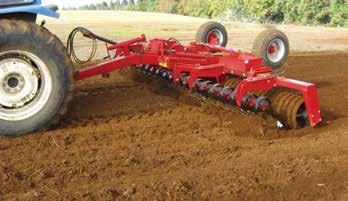
5.4m Tip Roller
$45,995+gst Ready to deliver now
• Versatile roller; options to cultivate, level, seed and consolidate. Can include levelling boards and/or spring tines.
• 3 section, contour following, central pivoting wing sections. 4.5–10.2m working widths.
• Maximum 2.45m travelling width.
• Equipped with HE-VA’s unique SAT pressure system. Uniform soil consolidation across the entire working width.

ing circle to the small frame Fendt 700s.
“Gen 6 Fendt 700 tractors have a two-speed transmission, one for the road and one for the field.
The VarioDrive transmission in the Fendt 700 Gen 7 range has just one range to go from 0 to 55 kph. So there is no chance for the driver to accidently work in the wrong range.
“Our aim is to get operators in seats. Once someone drives the new 700, they can see how it performs and how it could improve the efficiency of a business. It is as nimble as a smaller frame machine but has the power and pull of a large frame machine making it the ultimate all-rounder.”
• Five ring choices to match with soil type. All with 5 yr warranty.
• Tip Roller has become the roller of choice for NZ’s testing conditions.
• Heavy-duty construction for even the most rugged paddock.

• Versatile Lime & Fertiliser spreader
• Two large spreading discs distribute Bredal’s signature 4 x overlap
• K45 – K165 models, trailed. Option to truck mount
• 3500 – 19,000 L capacity
• Working widths: Lime 12m. Fertiliser 12 – 36m

NORTHLAND VEGETATION CONTROL DOES SPRAY CONTRACTING THROUGHOUT NORTHLAND – FROM THE BRYNDERWYN HILLS TO CAPE REINGA.
WHAT HAPPENS WHEN A LINESMAN AND A NURSE CHANGE PROFESSIONS AND BECOME RURAL SPRAY CONTRACTORS? IN CHANCE AND ROCHELLE CAMPBELL’S CASE, THEY CREATE AN AWARD-WINNING CULTURE OF HEALTH AND SAFETY.
Chance and Rochelle bought the spray contracting business Northland Vegetation Control in 2018.
In 2023, they entered the Northland Business Excellence Awards. While they didn’t set out to win the workplace safety category, they are very proud to have done so.
They took out the ACC Workplace Injury Prevention Award over companies in forestry, manufacturing, fitness and accommodation.
Rochelle says the awards presented a good chance to showcase the agricultural industry in a positive way.
“Everyone who enters the awards has to fill out a safety and health section as part the application process. We weren’t specifically targeting that.
“We entered because we thought it would be good for us to look at all aspects of the business from the outside in, and see where we could improve. Actually winning the award on the night was a big surprise.”
Since they bought it, Rochelle and Chance have diversified the business to take on tree planting and maintenance contracts as well as weed control. They now field a full time
team of 10 people, including themselves, with up to eight further casual staff planting trees in the winter months.
The spraying they do is largely in Northland – from the Brynderwyn Hills to Cape Reinga. Chance’s brother Trale manages the tree planting work, which they do as far afield as Levin, Gisborne and Hawke’s Bay.
Northland Vegetation Control joined the Nufarm Accredited Contractors scheme last year.
Nufarm is an integral part of the business, both in terms of product and support.
“It has been really good forming a relationship with one supplier. It has made everything flow better in our yard. They back their products 100 percent and we are really impressed with the support and guidance we get from Joe Heng. He is a mine of knowledge.”
Nufarm supports Rural Contractors NZ which the Campbells also belong to. They say working with the organisation that represents contractors has benefitted them personally and professionally.
“We didn’t get to the Rural Contractors NZ conferences for a start, because of Covid. But when we did, it was really cool to meet and chat with other contractors from around the country, and learn from them.
“It is great to see the effort Nufarm puts into supporting rural contractors. Sometimes as spray contractors, you are not really seen as a professional. You are just someone who sprays weeds.
“When you see Nufarm putting resources


into the industry, it makes you feel more valued.”
Chance and Rochelle have three children, and health and safety has been a priority for from the get-go. This is not only because of their experience in their previous careers, but also for the good of their team and the business as a whole.
The Business Excellence Award judges described their processes and procedures as ‘exemplary’. They highlighted one-on-one training covering risks with chemicals, transport, planting equipment, machinery and working in remote environments.
Rochelle says health and safety is a collaborative effort that tries to address all aspects of their team’s well-being. This includes social and family life.
“When they come into this industry, our people know they are going to be dealing with chemicals. They know that they are going to
HAVING GOOD HEALTH AND SAFETY PRACTICES AND TRAINING IS A WAY THAT CHANCE AND ROCHELLE CAMPBELL LOOK AFTER THEIR TEAM AND THEIR FAMILIES.
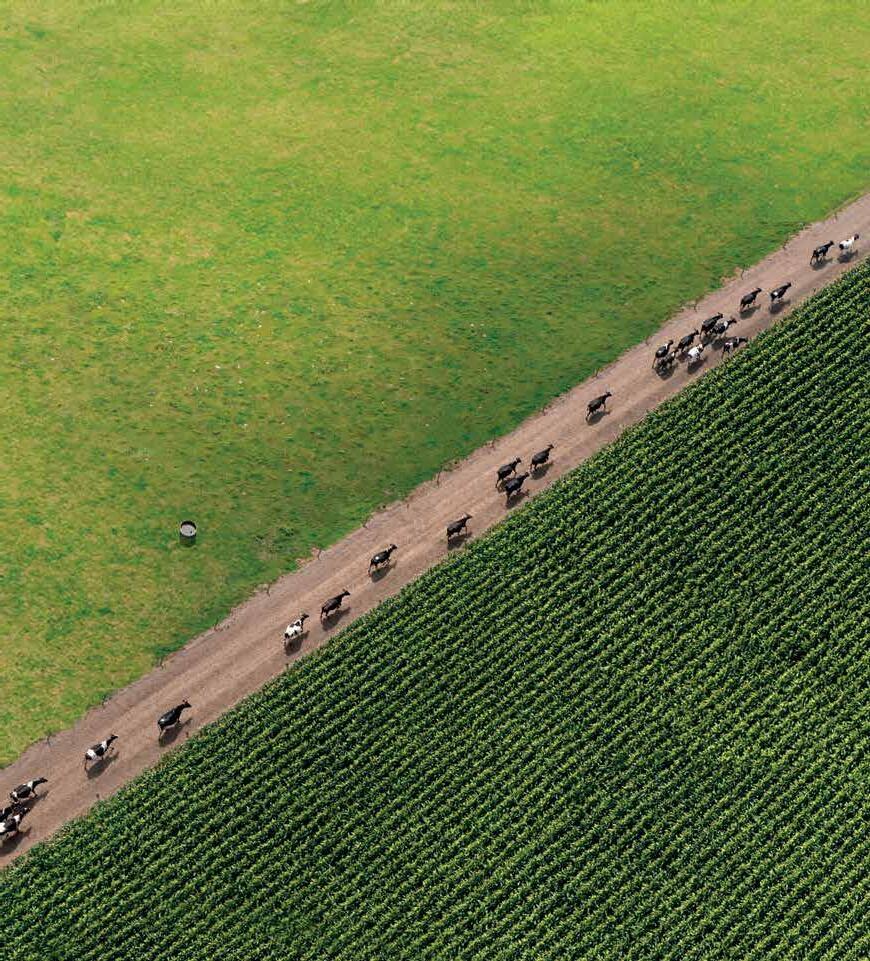
PERFECT PARTNER PASTURE’S
WAIRARAPA DAIRY FARMERS
RACHEL AND HAMISH HAMMOND ARE AMONG THOUSANDS OF FARMERS THROUGHOUT NEW ZEALAND VOLUNTEERING IN LOCAL ENVIRONMENTAL INITIATIVES.
The couple work with fellow community members to help protect and enhance the P āpāwai stream and neighbouring bush block. The Pāpāwai Care group is led by John Argue and a small committee and has been planting every year and managing established plantings.
Rachel says the group started many years ago and Hamish’s grandfather, Malcolm Hammond, was involved in some of the first plantings.
“We get a great sense of satisfaction from volunteering and it is a great way to connect with other locals,” Rachel says.
On their dairy farm, Hamish and Rachel use mixed pasture species, including the leafy herb plantain. DairyNZ-led research suggests Ecotain plantain can reduce nitrogen loss from pasture to help improve water quality while maintaining milk production.
The couple are also efficient with their water usage. “In dry summers we irrigate but our water application is closely monitored with soil moisture probes to ensure water isn’t wasted and the plants are optimising the water applied,” Rachel says.
Water is recycled to wash the yard and the cows are milked once a day, which has halved daily water use at the dairy shed.
“We know we need a good environment to farm well and we want our kids to have a great backyard,” Rachel says.
Hamish is active in the Wairarapa Water Users Society advocating for equitable and scientifically based decision-making around regulations and compliance. The society advocates best practice irrigation and runs training and field days.
On the farm, the Hammonds have planted alongside the stream and their boundaries to provide shade and shelter for animals.
“We are committed to best practice in
be driving on rough terrain.
“We talk about those risks when we interview them, and make sure they have the training they need to work safely.”
Physical well-being is monitored through regular blood testing to measure chemical exposure.
“We are also aware that when they go on spraying or planting jobs, they might be with-

everything we do, including breeding the best cows and being efficient with feed and fertiliser use. We want a really sustainable farming business that is resilient to change,” Hamish says.
Both Hamish and Rachel have Master’s degrees from Massey University – his is in agribusiness and farm management, and hers is in animal science. They decided dairy farming would be the best use of their skills.
“Farming is a great lifestyle. Running your own business means you are in charge of your destiny and the work is mentally and physically rewarding.”
Hamish says after spending a lot of time in front of computers at university, he appreciates the break from the glare of screens.
The farm is right next to Greytown and Rachel says the family loves the rural/urban mix. They are keen to inspire young people
out Internet for up to a week at a time. So we have a portable Starlink to help them stay connected to family and friends.”
Likewise a pool table and darts board are part of the fit out at head office, and there is almost always a Friday night social catch-up for everyone.
Rochelle says entering the Northland Business Awards was an opportunity well worth
WAIRARAPA DAIRY FARMERS HAMISH AND RACHEL HAMMOND WITH THEIR TWO YOUNG SONS, GEORGE (2) AND LOU (5 MONTHS). RACHEL SAYS THEY NEED A GOOD ENVIRONMENT TO FARM WELL AND TO CREATE A FUTURE FOR THEIR CHILDREN.
from towns, cities and rural communities into dairy farming.
The couple host high school students for work experience on the farm and give talks at career days. “We want to show what a great lifestyle it is to live and work on a farm and get people involved in the dairy sector,” Hamish says.
Rachel says a farm is a great place to bring up a family, with their children spending time outdoors and with animals every day.
seizing. “As a contractor, you are so busy that you never have time to work on the business, as opposed to working in it. Going through the application process has been great for us. We have started working with a business advisor, and we have learned so much.”
Would she encourage other contractors to enter similar competitions? “Yes, 100 percent!”
POWER FARMING HAS OPENED A LARGE NEW BRANCH ON THE OUTSKIRTS OF AUCKLAND, WHICH GIVES A BIG PLATFORM FOR JCB CONSTRUCTION EQUIPMENT.
The new retail facility is at Paerata, near Pukekohe, and it was officially opened in March by Prime Minister Christopher Luxon.
Since the beginning of 2022 Power Farming Construction (a new division of the Power Farming Group) has been the distributor of JCB Construction Equipment in New Zealand.
The distribution agreement brings together two significant family-owned businesses.
Founded by Joseph Bamford in 1945, JCB is one of Britain’s most successful family-owned businesses, while the Maber family has run Power Farming since Laurie Maber established it in 1948.
Given the size of Auckland’s construction and civil engineering sectors, it has built the new branch to support distribution of the JCB Construction range in the region.
JCB Group executive director George Bamford attended the opening of the new branch along with JCB Pacific region director
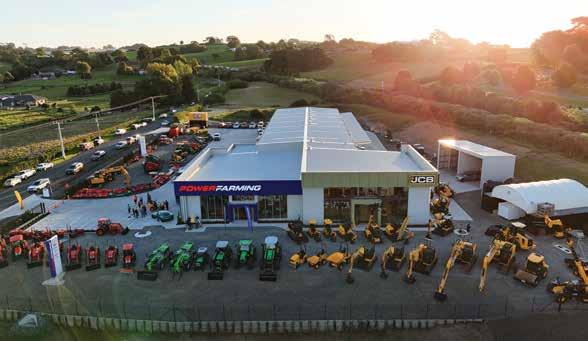
THE NEW RETAIL AND FACILITY AT PAERATA WILL GIVE AUCKLAND’S LARGE CONSTRUCTION AND ENGINEERING SECTOR ACCESS TO JCB CONSTRUCTION
PM CHRISTOPHER LUXON (LEFT) AND JCB’S GEORGE BAMFORD (RIGHT) CUT THE RIBBON TO OPEN THE CENTRE, ACCOMPANIED BY POWER FARMING’S BRETT MABER.
Richard Myles. They are both very positive about what the partnership with Power Farming presents for their brand.
“It is great to see Power Farming investing in the JCB brand and expanding into the construction business. We are very optimistic
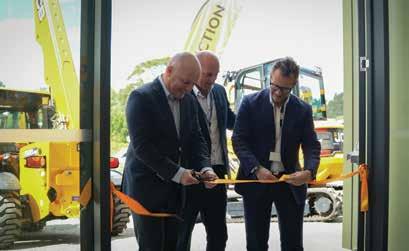





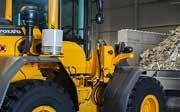
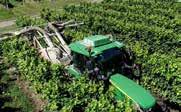
thought
didn’t
NEW ZEALAND NEEDS TO PREPARE FOR SIGNIFICANT CHANGES TO OUR KEY FOOD EXPORT MARKETS, FINDS A NEW REPORT LOOKING AT HOW THE RISE OF ALTERNATIVES TO ANIMAL PROTEINS COULD CHANGE THE FUTURE OF FARMING IN AOTEAROA.
Alternative proteins are likely to significantly affect the global market for proteins, as food technology improves and diets change in response to concerns about climate change, human health and animal welfare.
AgriBusiness Group director Jon Manhire says countries like the UK and China which depend on importing food from countries such as New Zealand will increasingly be able to produce more of their own alternatives to animal protein as technology advances.
The dairy sector in New Zealand is more threatened by the development of new proteins than our meat producers, found the research.
The Protein Future Scenarios research project was funded by the Our Land and Water. It investigated the potential impact on New Zealand of the global growth of new proteins that could compete with milk and meat.
Modelling by the research team projected the economic and environmental implications of three plausible future scenarios against a baseline scenario. The three future scenarios were based on different rates of technological advancement for alternative protein technologies, with associated growth in consumer demand.
Precision fermentation drove the worst economic scenario predicted by the research. Precision fermentation uses fermentation and yeasts to replicate dairy products. This could increase the global supply of dairy proteins and reduce prices for traditional New Zealand dairy products.
Technologies to reproduce dairy ingredients are more advanced than those for meat proteins. Whey derived from precision fermentation is already in commercial pro -
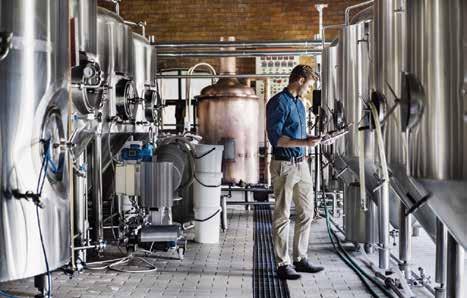
duction, and casein and milk fats can also be produced.
Demand for proteins is expected to increase globally due to population growth and changing diets. This won’t automatically drive increased production from New Zealand’s animal protein sector, because the increased demand could be met by alternative proteins, the research suggests.
Lincoln University’s Dr Christopher Rosin was part of the research team. Christopher says greater global demand for plant protein will have economic and environmental benefits for Aotearoa, but the economic benefits will be unevenly distributed.
“The modelling indicates that precision fermentation has negative economic impacts, mostly for our dairy sector. It does have positive environmental impacts, however. Cell-cultured protein is likely to have negative impacts on the New Zealand meat sector,” Christopher says.
“If widespread availability of cheap alternative proteins reduce profits for beef, sheep and dairy farmers, we are likely to see landuse change into arable, horticulture and carbon farming. This will have positive economic benefits for those sectors, but would reduce the size of our pastoral sector.”
The research models showed that alterna-
AS PROTEIN PRODUCTION FROM PRECISION FERMENTATION ADVANCES, IT COULD DISRUPT NEW ZEALAND’S DAIRY AND MEAT SECTORS.
tive proteins may have a relatively minimal impact on New Zealand agriculture when projected until the year 2035, but significantly greater impacts were identified when the modelling horizon was extended to 2050.
“Long-term modelling forecasts – like longterm weather forecasts – are less certain, but we are confident the research shows the likely trend in direction,” Jon says.
Research scenarios considered regional economic outlooks. For example, a 2050 scenario for Canterbury in which alternative proteins take off could decrease greenhouse gas emissions by over one-third, decrease nitrogen loss by almost 15 percent and increasing economic output 15 percent if some intensive dairy shifts to horticulture and arable.
Another key finding of the research was that global demand for new proteins could hit New Zealand’s meat and milk industry harder if we don’t mitigate our agricultural greenhouse gas emissions and meet high standards for animal welfare and water quality.
about a bright future for the Power Farming Group Construction team as we raise the brand profile in the New Zealand market,” Richard says.
Power Farming executive director Brett Maber says the purpose-built facility at Paerata is a multi-million dollar investment.
“We are very proud to establish this new branch alongside JCB Construction. It rein-
forces our commitment and confidence in the agricultural sector, and now for the first time also positions our brand for future growth in the construction sector too.”
Christopher Luxon acknowledged the importance of brands like Power Farming and JCB Construction to the New Zealand economy, and the respective roles they can play in contributing towards the government’s
future-focussed infrastructure plan.
“This is a great example of a fantastic New Zealand business investing in construction and also in agriculture, and it’s fantastic to see a family-owned business wanting to take the step of investment to actually make sure we can serve the agriculture industry and the construction and building industry in a much better way,” Christopher says.
JOHN DEERE HAS EXPANDED ITS OFFERING OF REPAIR AND REPLACEMENT PART OPTIONS BY ADDING VAPORMATIC PRODUCTS TO ITS RANGE OF ALTERNATIVE PARTS IN NEW ZEALAND AND AUSTRALIA.
UK-based Vapormatic is a subsidiary of John Deere. It has served the agricultural industry for more than 70 years and exports more than 30,000 tractor and agricultural machinery parts and accessories to 90 countries.
Vapormatic supplies parts for all European-built tractors as well as large row crop tractors out of the US. The range includes wear parts such as alternators, starter motors and filters for American-built tractors.
The addition bolsters John Deere’s Alternative Parts offering, which also includes products from A&I and Sunbelt that are made to fit John Deere equipment.
John Deere Australia-NZ director of customer support Emma Ford says alternative parts are an economical choice for John Deere machines, regardless of age.
“These parts have been manufactured to fit John Deere equipment. They are lower priced

than genuine John Deere parts, but still give customers peace of mind they are backed by a 12-month warranty,” Emma says.
“Adding Vapormatic to the range helps provide even more repair solutions for customers no matter their budget. We know customers have a choice when it comes to

VAPORMATIC HAS BEEN OFFICIALLY ADDED TO JOHN DEERE’S AFFORDABLE RANGE OF ALTERNATIVE PARTS.
John Deere equipment, so that’s why we offer choices when it comes to parts.
ONE OF AUSTRALIA’S FASTEST GROWING EQUIPMENT DISTRIBUTORS HAS ARRIVED IN NEW ZEALAND AND IS GEARING UP TO SUPPORT FARMERS AND CONTRACTORS ACROSS THE COUNTRY WITH SOME OF THE WORLD’S LEADING BRANDS.
Waringa Distribution has been operating for around a decade and in that time it has recorded exceptional growth. It has developed an astute understanding of agricultural markets and how to deliver machines and support to producers and dealers.
Part of a diversified farming group, Waringa Distribution thoroughly appraises and tests machinery before introducing it to the market.
Waringa Distribution general manager Sam Abbott is originally from New Zealand. He says he and his team listen to different markets and they are passionate about the equipment ranges they support.
“We work closely with farmers and contractors, and we focus on producing food as productively and cost-efficiently as possible,” Sam says.
Waringa Distribution has been looking to further grow and expand into New Zealand, but this had been hampered by disruptions to the global supply chain in recent years.
Now, however, it has appointed local industry identity Chris Tricker to lead its operations here and has established freight, assembly, warehousing and parts distribution locations in both the North and South islands.
Chris entered the industry as an agricultural engineer and has extensive experience in machinery sales, farm contracting and farming in the UK. He has been in New Zealand since 2007.
Before moving to Marlborough Chris was involved in sales and operations management, consulting and contracting, including with Claas Harvest Centre in the Waikato.
Waringa Distribution is already the exclusive New Zealand distributor for Agri-Spread fertiliser and muck spreaders, Gregoire Bes-

son tillage and soil structuring equipment, Highline rock handling and hay bale processing equipment, and Broughan Engineering trailers.
It is anticipating further interest from grain growers for its Geringhoff header fronts and Elmer chaser bins.
Chris says Waringa will add to its team and resources in New Zealand, which includes appointing dealers. It will be flying the flag and developing relationships at National Fieldays.
Agri-Spread spreaders are already well known in New Zealand. Chris says they are quality-built, durable and have high spec features and precision technology that can help limit environmental impact from fertiliser applications.
“Proof of placement with product applications will drive adoption of these technologies into the future,” Chris says.
“The level of technology with the AgriSpread spreaders is excellent. It offers full section control on a 36-metre spreader and that is almost unheard of.”
He says Gregoire Besson machines will be of particular interest to contractors and larger dairy enterprises that want to manage and incorporate trash when establishing maize
“With challenges around production costs it’s important we provide a wide range of parts to suit all budgets and repair scenarios.”
John Deere’s full range of parts include Genuine, Reman (or remanufactured) and Alternative.
“Genuine parts are built specifically for John Deere machines, meaning they are identical to the new parts fitted at the fac-
tory – in other words, the perfect fit,” Emma says.
“Reman parts have components replaced or remanufactured to deliver like-new performance at a lower cost than brand-new parts. They undergo extensive testing by our engineers to ensure they meet or exceed original performance specifications.
“As the name suggests, Alternative parts are an economical alternative choice which
WARINGA DISTRIBUTION GM SAM ABBOTT (LEFT) AND NZ SALES MANAGER CHRIS TRICKER EXPECT STRONG INTEREST IN AGRI-SPREAD FERTILISER AND MUCK SPREADERS AND GREGOIRE BESSON TILLAGE IMPLEMENTS.
and to undersow forage crops.
Gregoire Besson’s semi-mounted plough, disc harrow and one-pass finishing machines are ideal for these operations.
Chris says Highline rock pickers, rakes, bale feeders and tub mixers will also be a good fit for New Zealand farmers and contractors.
And Broughan Engineering trailers are ideal for famers who need to carry out a variety of tasks. Its farm trailers have removable sides and are ideal for moving a range of materials and picking up hay bales.
Geringhoff header fronts and Elmer’s chaser bins will capture attention from grain growers in the Canterbury region.
For further information on the Waringa Distribution equipment range or demonstrations, contact Chris Tricker on 027 577 0058 or visit waringa.co.nz.
still deliver the performance and reliability expected of John Deere parts.
“Expanding our Alternative Parts offering with the addition of Vapormatic is part of our commitment to offering our customers the right part at the right price.
“Customers who want to find out more about the range of parts designed for John Deere equipment, should contact their local dealership.”
COCHRANES OF CANTERBURY HAD A STRONG SHOWING IN BOTH THE NEW HOLLAND AND CASE IH AUSTRALIANEW ZEALAND 2024 DEALER OF THE YEAR AWARDS.
The award winners were announced in April. Cochranes won both the red and blue CNH Capital Dealer of the Year awards.
The Dealer of the Year awards are based on a range of criteria, including finance and business management, performance in sales and marketing, parts and servicing, precision technology and total market share.
CNH Australia-NZ business director Aaron Bett congratulates all the award winners. He noted the level of excellence achieved by the dealerships and their dedication to their customers.
“The winners should all be very proud of what they have achieved in the past 12 months. Their teams consistently go that extra mile and place a high priority on delivering the service, support and advice their customers rely on,” Aaron says.
“The standard across our network is very high, so to be successful in our Dealer of the Year Awards is an outstanding achievement,
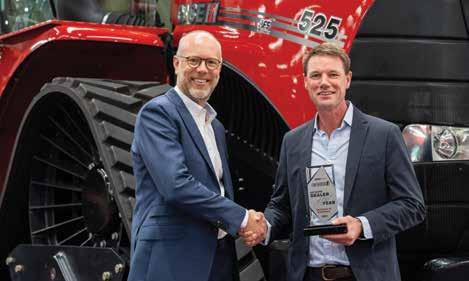
COCHRANES OF CANTERBURY DEALER PRINCIPAL CHRIS WEST IS CONGRATULATED BY CNH CAPITAL ANZ MANAGING DIRECTOR MATT DOWLING AFTER RECEIVING THE CNH CAPITAL DEALER OF THE YEAR AWARD.
and recognition of the work that has gone in across all aspects of the winners’ operations.”
Australian companies took out the other Dealer of the Year awards.
NSW dealership network Intersales in New South Wales was the Case IH Dealer of the Year for dealers with three branches or more and South Australia’s Larwoods Ag Services won Case IH Dealer of the Year with one or two branches.

In the New Holland dealership awards, On-Trac Ag (NSW) was the large dealer network winner and Flinders Machinery (SA) was the small network winner.
Intersales CEO Amanda Blachut says the award they won was a testament to the hard work of their whole team. “The dedication the team put towards training, team collaboration and knocking down barriers between departments is to be admired,” she says.
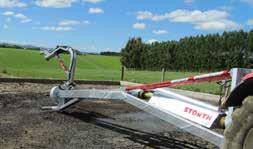
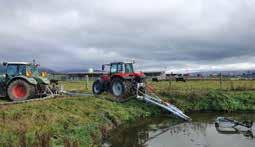
The contractors’ solution for every effluent pumping or mixing problem out there. The FarmChief Mega Mix Lagoon Mixer/Pump is excellent for high-performance incorporation of severely crusted large ponds and lagoons, whilst doubling as a top-of-the-range pump for priming umbilical pumps or transferring directly to tankers. Features include dual hydraulic rams for depth control, hydraulic 300 o rotating jetter for breaking up surface crusts, a Hardox intake chopper plate and impeller drum for incorporating
and a fully galvanised frame for a hard-wearing long life. What peak performance looks like.


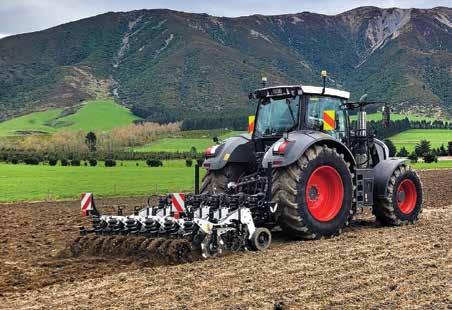
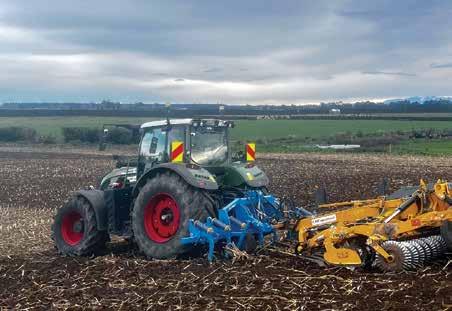

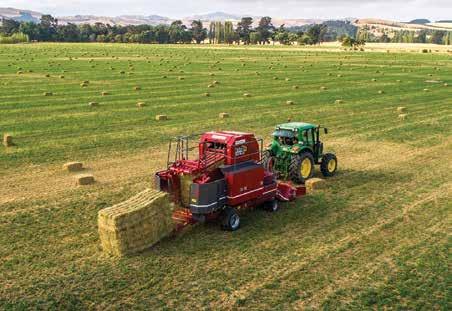
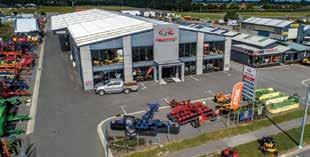
AUTONOMOUS VEHICLES AND ARTIFICIAL INTELLIGENCE ARE POISED TO SHAKE UP THE FARMING INDUSTRY, SAYS AN AMERICAN EXPERT IN THE FIELD.
Dr Scott Shearer is chair of the Department of Food, Agricultural and Biological Engineering at Ohio State University.
He notes that John Deere already sells a fully autonomous tractor, and the only question is how quickly robotic vehicles will replace human drivers. At the same time artificial intelligence (AI) and digital agriculture is now the new shape of precision agriculture.
“Previously it was start-ups talking about autonomy, but now it is almost all tractor manufacturers. It will be one of the things that will change the marketplace,” Scott says.
He spoke via video link at the Foundation for Arable Research’s maize conference at Hamilton in February. He says he attended the 2023 Agritechnica show in Germany, and nearly every manufacturer of agricultural equipment had a robotic or autonomous offering.
Examples include Australian company SwarmFarm which uses the tagline ‘My Dad used to drive a tractor’. Its autonomous sprayers can operate around the clock and they automatically shut down in adverse weather.
Running autonomous systems requires 5G connectivity which is not always available in rural areas. In the US, however, farmers can become their own mobile phone provider within a 2-3 km radius using their own antenna.
Autonomous vehicles present a possible way to counter the cost of farming machinery. To reduce costs and maximise coverage in the field during optimal conditions, agricultural machinery is getting bigger. As tractors become increasingly more high tech and expensive, a major question is how fully they can be used to justify the cost.
While it is now possible to plant seed at speeds of 10-16 kph there are challenges when working higher speeds.
Scott says another trend in the US is using drones to apply agrichemicals. In Ohio, there are about 25 companies that spray fungicides on maize and soybean crops with drones. One group claimed to have sprayed 10,000 ha with eight drones, while another used two drones to spray 2000 ha in a 30-day period.
FAR TECHNOLOGY MANAGER CHRIS SMITH SAYS AI’S ABILITY TO MANAGE AND INTERPRET LARGE VOLUMES OF DATA WILL GIVE FARMERS SOME GREAT OPPORTUNITIES.
Drones are getting bigger. For example, a Hylio AG-272 spray drone weighs 175 kg when fully loaded with batteries and 70 litres of product. It has a 12m application width and can spray up to 20ha/hour.
Scott says AI will help farmers interpret the huge amounts of data they generate when using precision agriculture. It is part of the trend toward what he calls digital agriculture.
“Digital agriculture covers everything from when the seed goes in the ground until there are end products on the consumer’s table. Everything is connected to the Internet.”
Digital agriculture uses artificial intelligence and machine learning to interpret huge amounts of data to support farmers’ decision-making and improve the efficiency of their work.
Scott gives the example of a spray applicator using a camera and processors to distinguish green on brown weeds and in some cases green on green.
“We will use this for a lot more than just spraying weeds. We will use it to manage fungicides, insecticides and nutrients.”
Central Ohio has become the US MidWest’s Silicon Valley, with tech giants Intel, Google, Meta and AWS moving in. When AI is fully implemented, electricity consumption in the Mid-West is expected to increase by 25 percent, he says.
FAR technology manager Chris Smith says the biggest challenge for growers adopting precision agriculture as an everyday tool on-farm has been the perceived cost versus the return on investment. Data transfer and sharing information between different systems by service providers are also barriers to adoption.
“Internationally, several countries are trialling new technologies that may provide

OHIO STATE UNIVERSITY PROFESSOR SCOTT SHEARER SAYS ALL MAJOR FARM MACHINERY MANUFACTURERS ARE DEVELOPING AUTONOMOUS VEHICLES WHILE AGRICHEMICAL APPLICATION WITH DRONES IS TAKING OFF IN THE US.
future precision ag opportunities for New Zealand growers. Software and hardware developments promise greater and smoother integration of layers of data,” Chris says. AI and machine learning will help greatly with this. They will provide higher resolution imagery, draw on large amounts of data to identify weeds, pests and diseases, and have ability to manage data more accurately and cost effectively.

OFF-HIGHWAY MACHINES, SUCH AS EXCAVATORS AND TRACTORS, ARE SOME OF THE LARGEST AND MOST POWERFUL MACHINES IN THE WORLD. THEY REQUIRE HUGE AMOUNTS OF POWER AND THEREFORE GENERATE VAST AMOUNTS OF POLLUTION.
Manufacturers of off-highway machinery have developed electric models to reduce greenhouse gas emissions and other pollutants. These machines – given their size and operating hours – are difficult to electrify, as they require very large batteries and regular access to a grid connection.
Therefore, adoption has been slow, even in markets that are relatively progressive when it comes to reducing emissions. A big challenge is for electric machines to operate for the same length of time as diesel-powered equivalents. Unlike passenger cars, off-highway machines may be in use for more than eight hours in a day or even much more.
To get the same performance from an electric off-road machine requires a very large and very expensive battery. This can make the machine unaffordable, even allowing for the lower cost of electricity versus diesel, and it is hard to design machines with very large batteries. It also takes a very long time to recharge the battery.
But battery swapping could cut the cost of the machine and speed up charging times. Battery swapping is not a new concept. In

the passenger car market, battery swapping has a murky past although Chinese car OEMs are trying to create an ecosystem.
In the heavy-duty truck market, there is a developing market in China where several thousand trucks already support battery swapping. So there are possible options for off-road vehicle battery swapping.
Building machines with swappable batteries has a number of advantages. Battery packs can be made smaller or even eliminated completely from the machine, which substantially reduces the upfront cost. Nearly 40 percent of the cost of an electrified off-highway machine is the battery.
Operators can manage costs by selecting the number of packs they need for a job, rather than buy a very large battery when they rarely need to use all the stored energy.
With swappable batteries the problem of having the vehicle out of work during charging is removed since a pack can be swapped in five minutes.
Also battery packs can be used for grid storage when not in their machines. And a swapping system could prove to be a lucrative source of income for rental companies, because they can provide a battery pack service for users who require additional capacity.
AgroMec in the Netherlands has developed

AGROMEC’S ELECTRIFIED FENDT 700 VARIO HAS A SMALLER BATTERY UNDER THE HOOD AND A LARGER, SWAPPABLE ONE ON A FRONT ATTACHMENT.
a battery swapping system for agricultural tractors. AgroMec has electrified a Fendt 700 Vario tractor that actually uses two batteries, which is possible because the tractor does not have the weight of an engine to contend with.
The first is a relatively small (70 kWh) on-board battery that sits under the bonnet and provides enough power for short, light work and for getting to a battery pack.
A second swappable (140 kWh) battery pack can be added to a lift on the front of the tractor. It can quickly be changed, so it can be replaced by another 140 kWh battery. Then the first swappable battery can be recharged.
The battery pack is made by ECE/Webasto and several of these tractors are already in operation on farms and construction sites in the Netherlands. Electrification of ag equipment is challenging and may not, in fact, be the route the industry decides to go.
It is just possible that a standardised battery swapping system like this could help to drive adoption and convince farmers to make the swap.
The Drever 120 is a prototype autonomous tractor built by Traktorarvid and RISE Research Institutes in Sweden. It features a modular battery swapping system to support longer field operation.
Webasto and Dutch company Electric Construction Equipment (ECE) have collaborated to convert Doosan excavators to operate with swappable battery packs. The battery packs from Webasto are modular and each excavator has two swappable power boxes that have 140 kWh of capacity.
THE 140 KWH BATTERY PACK ON THE FRONT OF THE AGROMEC TRACTOR CAN BE CHARGED IN PLACE OR SWAPPED OUT AND CHARGED WHILE THE TRACTOR IS WORKING.
EUROPEAN AG MACHINERY MANUFACTURERS KRONE AND LEMKEN ARE EXPANDING THE RANGE OF IMPLEMENTS THAT CAN BE USED WITH THEIR PROTOTYPE AUTONOMOUS TRACTOR BY ADDING FRONT-MOUNTED ATTACHMENTS.
Krone and Lemken’s Combined Powers project is a joint effort to develop an autonomous power unit that can be used with various implements to cultivate, drill, mow, rake and carry out other jobs on-farm.
The power unit is called the Vehicle Transport System (VTS) and it has a diesel-electric drive that generates up to 170kW (230hp). It transfers power electrically to the wheels and the PTO, and from there to the implement attached to a three-point linkage. It has four-wheel steering with large tyres for maximum tractive power and minimum ground pressure.
The Combined Powers vehicle uses the Robot Operating System (ROS) as well as software from Apex.AI, which specialises in operating systems for autonomous vehicles, robotics and artificial intelligence.
Now the VTS project is building on the results of the field trials in 2022 and 2023 to develop greater capacity for the autonomous tractor. With the addition of a front linkage with PTO shaft, implements can be attached to the front and rear.
Front-rear combinations can be useful in both pastoral and arable farming. For example, Krone can use the front PTO to increase the working widths of its mowers. They can

combine a Krone EasyCut F 320 front-mounted mower with a rear EasyCut B 950 butterfly mower.
Lemken can use the front PTO to improve stubble cultivation and sowing by attaching rollers or front hoppers.
Combined Powers had the latest version of the VTS on display at Agritechnica 2023. Along with the front PTO, it has improvements that make operation more practical and maintenance easier.
They are now carrying out large-scale on-farm trials in Germany and other European countries to improve the reliability of the VTS as it works autonomously in real farming situations.
Krone and Lemken are not only communi-
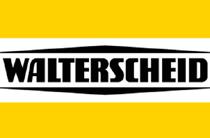

THE VTS RUNNING A KRONE TRIPLE MOWER COMBINATION WITH AN EASYCUT BUTTERFLY MOWER ON THE BACK AND EASYCUT F 320 ON THE NEW FRONT PTO.
cating between themselves as they develop the VTS. They are also talking with other implement manufacturers and working closely with farmers to make the autonomous system as useful as possible.
Their aim is to make a system that will help farmers overcome the impending shortage of skilled agricultural machinery operators. For more details visit the website combined-powers.com.
SERVICE YOUR CLUTCH WITH US THIS WINTER
• Regular clutch maintenance helps to prevent major damage to your tractor and equipment
• Serviced by trained technicians in PTO clutches
• Tested on our computerised torque test rig
CASE IH AND NEW HOLLAND HAVE UNVEILED THE FIELDOPS APP, A NEW ALL-IN-ONE MOBILE AND WEB-BASED WAY FOR FARMERS AND CONTRACTORS TO CONNECT, VIEW AND MANAGE THEIR OPERATIONS.
The Case IH and New Holland FieldOps portals provide access to data from their machines, their agronomist and other advisers and their operations in real time.
At a time when agriculture is becoming more digital and data-driven the FieldOps apps allow farmers and contractors to access vehicles through the cloud to drive more profitable operations. Their dealers also have access to some of this data so they can better service machines to minimise downtime and maximise efficiency.
FieldOps is designed to be simple and understandable for users with any level of experience.
But, as many people who live in rural areas know, there are still serious limitations for those in remote areas to connect on-line to their machines and operations. Without an extensive cellular or terrestrial network, options for farmers to manage data and connect to their fleets are restricted.
To address this, Case IH and New Holland have taken a step in enhance connectivity around the world. They are collaborating with satellite communications company Intelsat to ensure that farmers, regardless of their location, have reliable Internet access so they can use all the features FieldOps offers.

Case IH global brand president Scott Harris says streamlining precision technology integration is at the forefront of the company’s efforts.
“By building a centralised digital user experience with Case IH FieldOps, our customers are going to experience a simplified approach to their data and more informed and data-driven success in their operations,” Scott says.
Major features of FieldOps include:
• Data Visualisation. Instant access to real-time agronomic and machine data. This includes a machine’s precise location and duty status, its current working parameters, its estimated job completion time, its 24-hour history, and more.
• Machine Analytics. Users can proactively monitor the health of their crops, quickly spot high-priority issues and stay informed with notifications. Data can be viewed for

CNH INDUSTRIAL’S FIELDOPS IS A SIMPLE, UNDERSTANDABLE MEANS FOR FARMERS AND CONTRACTORS TO VIEW AND MANAGE DATA FROM THEIR FLEET AND FIELD OPERATIONS.
any specific field over individual seasons and years to enhance efficiency.
• Remote Viewing of In-Cab Display. This allows managers to monitor machines, coordinate with operators, and suggest settings.
• One Simple, Comprehensive Solution. Case IH and New Holland FieldOps centralise tools from the AFS Connect and MyPLM Connect platforms into one streamlined system that can take data from different farm operations or multi-branded fleets. This makes it easier for farmers to access their field and farm data in one platform.
New Holland brand president Carlo Lambro says agriculture is changing rapidly, and farmers want support so they can come up with simple solutions for complex problems.
“Our approach is to put customers at the centre, and it is our job to help by developing technological products that improve their productivity,” Carlo says.
“We created FieldOps based on our customers’ feedback. It has an interface that prioritises simplicity and intuitiveness. It enables farmers to improve their efficiency and profitability, whether they are investing in a new fleet or adding automation to their existing machines.”
Case IH and New Holland FieldOps mobile and web apps are currently in the final stages of development and testing, with a full release expected later in the year.
TO ENSURE FARMERS AND CONTRACTORS AROUND THE WORLD CAN USE THE FIELDOPS APP, CNH IS WORKING WITH A SATELLITE INTERNET PROVIDER TO DELIVER INTERNET ACCESS.
TWO AUSTRALASIAN BUSINESSES HAVE JOINED FORCES TO DEVELOP A ROBOTIC SPRAYING SYSTEM FOR THE HORTICULTURE INDUSTRY.
Kiwi company Robotics Plus is working with Australia-New Zealand sprayer manufacturer Croplands to develop Prospr, an autonomous electric vehicle platform that works in orchards and vineyards. Prospr can use different tools and attachments to spray grapes, apples or tree crops.
Robotics Plus specialises in the design and build of work robots, AI, and autonomous machines. Croplands, a subsidiary of Nufarm, has 50 years of experience in building and distributing spray technology.
Croplands general manager Sean Mulvaney says it has worked with Robotics Plus to integrate Quantum sprayer modules into Prospr.
Sean says Croplands is focused on bringing emerging technology to the market and it looks forward to distributing Prospr and a range of sprayer attachments across Australia and New Zealand.
Robotics Plus chief executive Steve Saunders says his company looks to partner with companies that are keen to adapt technology to solve problems.
“Agriculture is time-critical. With Croplands, we are combining expertise to benefit growers. We have developed an automated, effective spraying and attachment solution with the smarts to not just do the job but to keep doing it better. Prospr customers in Australasia will now benefit from Croplands’ large distributor network, spraying expertise and customer support.” Steve says.
Prospr is a robust autonomous vehicle that can run all day and help growers reduce emissions and chemical use, and overcome shortages of skilled machine operators.
The unique modular architecture that Prospr has can accommodate interchangeable tools for grapes, apples, or tree crops. With the ability to use different tools in different crops, Prospr can help growers maximise return on investment.
Croplands and Robotics Plus have developed the Q Series of sprayers for Prospr. The Q4 and Q6 sprayers have two and three fans per side respectively and are designed for vine or tree crops. The Q8 sprayer has eight fans, four per side, and is designed for tree crops.
Spray rates and air speed on Q Series sprayers are dynamic and controlled with electric drive to maximise spray performance. The sprayers feature Croplands’ Quantum fans, which produce targeted turbulent air for better droplet formation and coverage.
Prospr has an all-electric drive system for superior torque and control. It produces

power using a Tier 4 diesel generator, so it can operate for extended periods without charging or refuelling. Regenerative braking and high-capacity batteries extend its work range.
Its intelligent all-wheel-drive system with independent wheel motors gives superior manoeuvrability, grip, and control. With this technology, Prospr has a small footprint and the ability to make sharp turns.
Electric steering and independent motors allow it to turn on its rear axle so it has a minimum headland requirement of 7.1m for row-to-row turning. This means it can cover ground faster and maximise productivity compared to machines that turn on every second or third row.
The minimum row spacing for Prospr is 1.85m. This gives growers options to use autonomous spraying for a variety of applications and crop types.
The vehicle’s lightweight design, combined with its unique tyre and wheel configuration, reduces ground compaction. Robotics Plus has a partnership with Yamaha Motor Co so
A DIESEL GENERATOR PRODUCES THE ELECTRIC POWER THAT DRIVES THE PROSPR. IT CAN OPERATE FOR LONG PERIODS WITHOUT CHARGING OR REFUELLING.
it has access to their extensive knowledge in machine vision and artificial intelligence.
Prospr uses a combination of sensors and perception systems to detect the environment. Multiple Prospr machines can collaborate in a fleet to get jobs done.
Operators can manage the day’s work with an easy-to-use interface. Team members can coordinate with various desktop and mobile devices. Managers can log jobs in advance and view them in real-time. Jobs that have been completed or are still in progress can be mapped and recorded digitally.
Multiple machines can be managed simultaneously by one or two operators from a single remote control via a fixed or mobile console.
For more information on Prospr or to place an order visit the Croplands website: croplands.com.
PROSPR AUTONOMOUS VEHICLES FITTED WITH Q SERIES SPRAYERS. PROSPR HAS ALL-ELECTRIC DRIVE FOR SUPERIOR TORQUE AND CONTROL.

AT THIS YEAR’S NATIONAL FIELDAYS, PRECISION FARMING WILL ANNOUNCE ITS PRODUCT ORDERING, JOB ALLOCATION AND PROOF OF PLACEMENT TOOLS ARE NOW COMPATIBLE WITH JOHN DEERE GUIDANCE AND DATA MANAGEMENT SYSTEMS.
Precision Farming chief operating officer Chloe Walker says, with this step, Precision Farming’s digital services can be used with a number of the major satellite guidance and precision agriculture providers – including Trimble, Topcon, Ag Leader and Tirotech, as well as John Deere.
“At Fieldays 2023, we announced that we had formed a partnership with Trimble to make our systems compatible with theirs. This year we are doing the same with John Deere,” Chloe says.
“Now any farmer or contractor who uses John Deere Greenstar and Operations Center will be able to connect their tractor with HawkEye, MyBallance and Precision Farming. This allows farm-
ers who self-spread to automate the recording of their activity.
“It also gives contractors who run John Deere equipment the ability to connect digitally with their customers. It automates the steps of requesting a spreading or spraying job, allocating that job to a machine and a driver, and keeping a record to show where and when it was applied.”
Precision Farming is a homegrown Kiwi company, whose slogan is ‘Every tractor, every truck, every trailer on every farm connected’.
Chloe says when former finance minister Sir Bill English became a shareholder and chairman of Precision Farming in 2021, he identified the difficulty of managing and interpreting
With this season now ended, it’s time to put some thought into next seasons staffing.
Hanzon Jobs are currently interviewing. We have started to place drivers already.
If you are interested and would like to secure staff for this coming season, please get in touch, or register via www.hanzonjobs.co.nz/get-staff.
For more information please email us at work@hanzonjobs.co.nz
Hanzon Jobs will be back from the UK and in office from the 1st of July.


data as one of the biggest hurdles farmers face in the push to maintain profitability and meet compliance requirements.
“Sir Bill’s view is that farmers can improve efficiency and reduce manual paperwork if they have the ability to share data and create insights from it. Farmers generate more and more data and they face increasing demands for this data, but they need systems that avoid duplication and make gathering that data as automatic as possible.
“Our expertise is translating data and getting one system to talk to another, even when they are unique and owned by different companies.
“We give farmers the ability to place an order using MyBallance, Hawkeye or with their independent fert supplier like Dickies Direct or Mainfert and then receive a proof of placement map to assist with nitrogen cap compliance, fresh water management and other environmental regulations,” she says.
One strength of Precision Farming’s system is that it is ‘hardware agnostic’. It does not matter what brand of tractor or other vehicle you drive, or what guidance system you use, Precision Farming’s goal is to be able to talk to it.
Another of its strengths is that Precision Farming offers applications for all sized agricultural operations in New Zealand.
The range covers:
1) Contractors and large scale farmers with a fleet of vehicles to manage,
PRECISION FARMING ORDERING, JOB ALLOCATION AND PROOF OF PLACEMENT TOOLS ARE NOW COMPATIBLE WITH JOHN DEERE PRECISION FARMING SYSTEMS.
2) Large and medium-sized farmers who use contractors to do a lot of their work, and 3) Farmers who do their own spreading and spraying.
Precision Direct is the level of service for contractors and other large fleet operators. It allows the fleet manger to send a job assignment direct to the cab of the machine that will do the work. They can track the progress of the job in real time and automatically record all details once it is complete.
Precision Link is the other side of the coin, i.e., it is the system that a farmer uses to request jobs from their contractor. They can use the Precision Farming platform, MyBallance or Hawkeye to order their fertiliser or chemical directly from their supplier. The order then goes directly to the contractor to carry out the job.
Once jobs are completed farmers get the proof of placement from the contractor via Precision Link into MyBallance, HawkEye or Precision Farming. They can use it to track the amount of nitrogen they have used from different suppliers to keep under nitrogen caps.
Farmers can also Precision Link to centralise data from flow meters, moisture probes, irriga-

tors and effluent spreaders.
Precision Connect is the third level of service that Precision Farming provides. It is for farmers who do their own spreading or spraying.
As long as they have a spreader with the ability to use guidance and do mapping they can use Precision Connect to order their fertiliser and record their applications for compliance purposes.
Chloe says about 30 percent of the fertiliser applied on New
Zealand farmland is spread by farmers themselves, so Precision Connect serves an important segment of the market. It gives these farmers the ability to avoid manual record keeping and automate data returns.
The next frontier Precision Farming is expanding into is making it easier for farmers to utilise precision application. It has the ability to ingest and transfer prescription maps to apply fertiliser or chemicals at variable rates across a farm.
Again this can all be largely automated. The map can be based on images from a drone,


satellite or soil tests. It is sent to the machine that does the job so that it can automatically change application rates on the go. After the work is done the placement map is sent to the contractor and/ or farmer.
“Variable rate has the potential to reduce fertiliser applications significantly without loss of yield,” Chloe says.”
Precision Farming’s systems
can be scaled up and adapted to other precision agriculture markets. There is interest from the Australian and European markets because of its ability to connect to different guidance platforms.
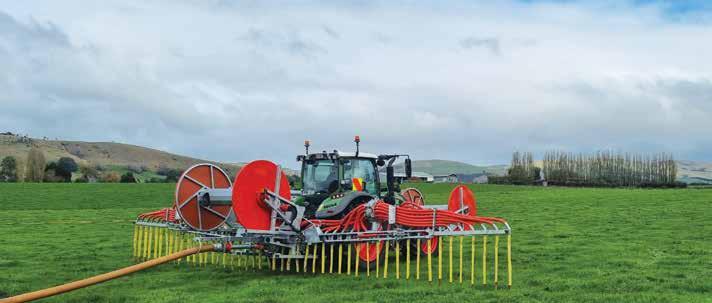

 PRECISION FARMING CHIEF OPERATING OFFICER CHLOE WALKER.
PRECISION FARMING CHIEF OPERATING OFFICER CHLOE WALKER.
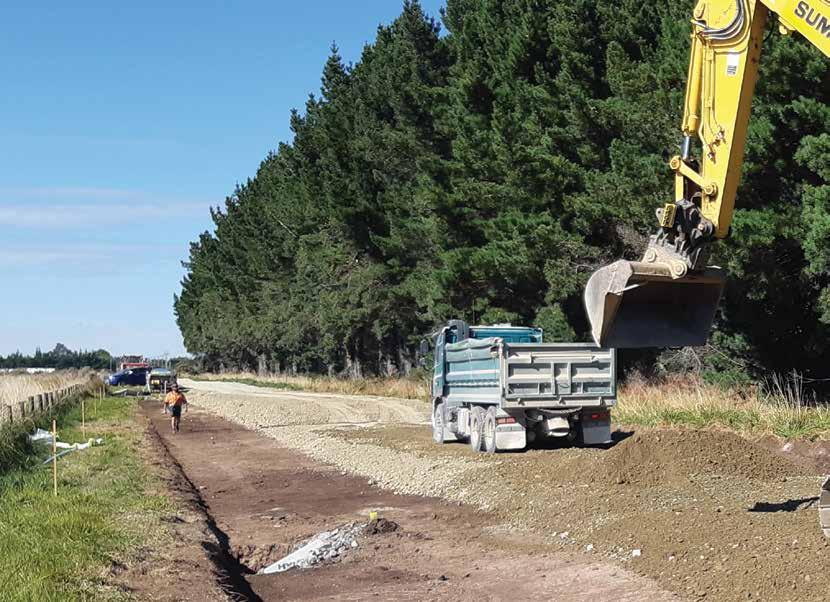
SHANE WILSON ALWAYS THOUGHT THAT HE AND HIS WIFE ERIN WOULD END UP RUNNING THE FAMILY DEER FARM AND EVENTUALLY BUY IT OFF HIS PARENTS, KAYE AND ALLAN WILSON.
Instead, they started a contracting business for additional income, and it grew so enormous that Kaye and Allan now work for Shane and Erin.
Shane grew up on the family farm in Waimatua, near Invercargill and did his apprenticeship as a fitter/welder at the Tiwai Point Aluminium Smelter.
“I always wanted to get a trade. I was into woodwork and metalwork and when the opportunity came up at Tiwai, I took it. It has been bloody good. When I first left, I built a lot of truck decks and equipment for the business.”
When the call of the paddock became too strong, Shane returned home in 2002. The farm could not support two families, so they clubbed together to buy
WILSON CONTRACTING’S TRUCKS DO A RANGE OF JOBS, INCLUDING CHIP SEALING AROUND THE SOUTH ISLAND AND CARTING ROADING CHIP TO DUMP SITES AROUND EASTERN SOUTHLAND.
two silage trucks, which Shane used to subcontract for other contractors. That was the start of Wilson Contracting Ltd.
At that time dairy conversions were a growth industry and Wilson Contracting grew with it.
Kaye and Allan changed tack and Shane converted their deer farm to dairy in 2009. It was becoming clear that he had found his niche as a contractor and would not be running the farm. That was solved with a 50:50 share-milker.
Now Allan drives for Wilson Contracting while Kaye and Erin
MOST EARTHMOVING JOBS ARE DONE ON FARMS BUT WILSON CONTRACTING ALSO DOES FORESTRY ROADS AND COMMERCIAL AND RESIDENTIAL DEVELOPMENTS.
run the office.
Wilson Contracting’s income is roughly divided into three revenue streams – transport, earth-moving and ag work.
The business employs 16 permanent staff. About half are truck drivers and the rest are on

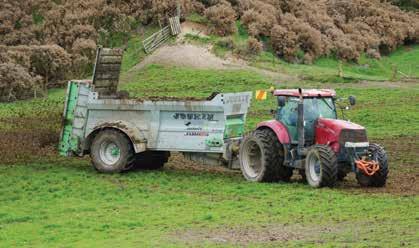
WILSON CONTRACTING RUNS A JOSKIN REAR-DISCHARGE MUCK-SPREADER FOR SOLID MATERIAL.
diggers or tractors, but Shane says most are multi-skilled. During the season they get two or three additional staff through the employment agency, Hanzon Jobs.
“It normally works pretty good. Richard Houston from Hanzon Jobs doesn’t send clowns, although this year they buggered off early and left us in the lurch.”
They also get a few casuals such as university students and semi-retired farmers.
Getting good staff is always an issue. “We have a good core, with staff who have been with
us for a long time, but there are always 10 to 20 percent who are transient.”
They aim to start a youngster out of school every season and get them through their licences.
“That way we get people trained the way we want them.”
Training is important and there is an emphasis on safety and precision. Shane’s trade background influences how he trains.
“I always prefer a tradie to a cocky’s son. They think more logically, not rip, shit and bust. I like to do a job properly.”
Shane seldom drives. He needs to stay a couple of days ahead of the workload, to keep everything flowing smoothly, and also to keep him free to deal with any obstacles in the workday.

ACCORDING TO SHANE WILSON, KUHN TRIPLE MOWERS ARE THE BEST AVAILABLE FOR FOLLOWING CONTOURS.
ALL OF WILSON CONTRACTING’S AGRICULTURAL CLIENTS ARE DAIRY FARMERS ON THE FLAT LANDS AROUND INVERCARGILL.
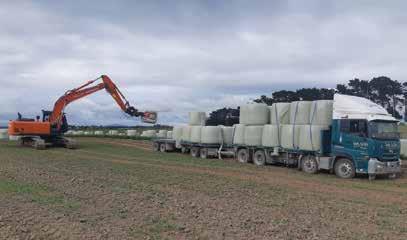
Shaun McDowall took over dispatching. “He’s taken the pressure off. I can take a day off now.”
Work is dispatched through the Mytrucking app. Shaun enters the jobs and they are allocated to them as they log on. Drivers can add more information and when the job is done it is all sent back to Shaun ready for invoicing.
Mytrucking also works with Eroad, making it easier to track



With that in mind, everyone works to the logbook rules. “Efficiency is a lot better when people have time off.”

grow grass for sale.
back off-road mileage. All health safety information is on another app called Safe365.
“We try to stay up with technology – anything that makes life easier.”
The business structure means that work may slow down a little, but it never stops. “Trucks and diggers are not as seasonal as they used to be, so it is important to keep the guys refreshed.”
Nearly all ag clients are dairy farmers on the flat lands of southern Southland, from Hedgehope and Edendale in the north, to Otara on the southern coast. Jobs are mostly up to an hour of travel by tractor.
The trucks go further afield. They roam over the South Island to move stock or do general cartage. Transport of balage, silage, gravel and fert is more local.
Between them the two Wilson families own about 350 ha of dairy support land, which they use for winter grazing and to
Wilson Contracting bales about half of the grass and the other half is for fine-chop. Shane supplies the trucks and sometimes stacks, while O’Connor Contracting supplies the chopper.
This is a good example of figuring out where you want to invest your money. Sometimes it is more efficient to work with other people who already have the gear.
Wilson Contracting also buys a small amount of standing grass for baling and sale.
“We have a good relationship with Agricentre South, so we
have Case IH tractors and Kuhn gear,” Shane says.
Mowing is done with Kuhn triples without conditioners. The front mower is the pull type.
“It’s a bloody good set up - a good floating system. I have had other brands of mower, but Kuhn is better than all others for following contours.”
The Kuhn rakes are only two-rotor. “Two-rotor is fine for feeding the balers. In a heavy crop, four-rotor is too big.”

In Southland most bales are round. Wilson Contracting has two McHale Fusion 3Plus combi balers. Shane likes baler-wrappers because only one operator is needed.
“We work flat ground so we don’t have to worry about bales on hills. You leave at the end of the day and the job is done. You don’t have to charge around with a wrapper.”
He has used a Fusion for the last 15 years, starting with a Fusion 1. Shane did consider changing to Kuhn when they replaced the last baler, but decided it was easier for training and holding parts to stick with the same brand.
“We know McHales are reliable and will bale even in marginal conditions. We can get tight windows and a tough start to the season and we have a good relationship with the local Power Farming dealer.”
Balers are usually replaced every three-five years, when they have done 60,000 bales. “We try to keep them modern so there is not so much down time. Also you attract a better class of driver with good gear.”
In a good season they also use the Fusions to make some hay. The 2023-2024 season was not one of those seasons.
“It was good for growing, but then you couldn’t do anything with it. It was too wet.”
Case IH tractors provide the muscles for the machinery. They include two Maxxums, a 135 and a 150 with Powershift. “I like pow-
WILSON CONTRACTING SUPPLIES THE TRUCKS AND O’CONNOR CONTRACTING PROVIDES THE FORAGE HARVESTER FOR FINE CHOP SILAGE CONTRACTS.
ershift for the smaller tractors with loaders. You get the feel with Powershift,” Shane says.
The rest are Pumas and include a 130, 185, 220 and two 240s – all with CVT. “CVT transmissions are bloody good to drive. They are smooth and really good on the balers and ploughs.”
Shane buys a new tractor every year. “If you miss a year, then you’ve got to play catch up. They are always improving with a better ride and more comfort.”
He likes the service he gets from Agricentre South and their finance packages make it easier to keep tractors updated. “When buying new, they always have good deals.”
Wilson Contracting generally keeps tractors up to 7000 km and then trade them in.
Keeping the same brand of tractor makes it easy for staff to swap between vehicles.
Although Shane could do more maintenance work himself, he finds it more efficient to keep the vehicles new and let a mechanic sort any problems.
His time is better spent ensuring the business is running smoothly. They employ a fulltime mechanic and use local service agents in Invercargill.
Another service they provide is muck-spreading, which they do with O’Connor Contracting. O’Connor has three spreaders and Shane has two, a Shelbourne Reynolds for runny muck and a Joskin rear-discharge muck-spreader for more solid material. They also run a 12,000-litre Joskin slurry tanker.
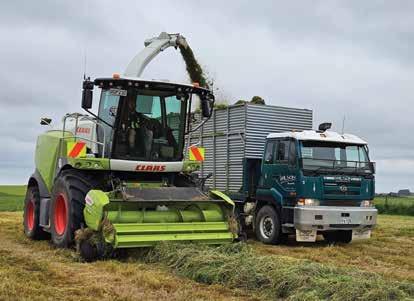

wilson contracting has grown by making smart decisions
They have invested in machinery that makes a return and they work with other contractors who already have gear. They look after staff and always do the best job possible.
Now the next generation of the family is coming along.
Shane and Erin’s son Heath is 16 and leaving school this year to do an apprenticeship as a diesel mechanic. Briar (13) and Sian (11) attend Southland Girls and Tisbury School respectively.
All three children are into sport and keep Erin busy running them around. Erin also works one day a week as a radiographer in Invercargill.
Then there is the ground work.
“Ploughs are still the first choice for us coming out of grass into a crop. After the wet winters it lets more air into the soil and dries it out quicker.”
Wilson Contracting has a Kuhn reversible and two conventional Kvernelands. They are all five-furrow.
In some areas the soils are full of sticks and then Shane uses Quivogne discs.
The next pass is with either the 5m or 3.5m Kuhn power harrows. “Kuhn gear is good and solid and it never lets us down.”
They sow some summer turnips and kale with a 3m Aitchison direct drill but usually they use a
4.5m double roller drill.
“The double roller gives betterresults than a single roller. The seed is applied between the two rollers, so it goes onto a good firm seed bed before it is harrowed and rolled with the second roller.”
A third of Wilson Contracting business is done with its 14 trucks.
THE BUSINESS HAS ALWAYS RUN MCHALE FUSIONS BECAUSE THEY ARE RELIABLE AND WILL BALE IN MARGINAL CONDITIONS.
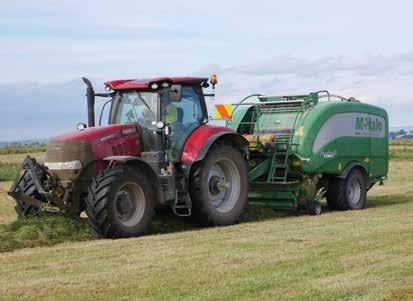
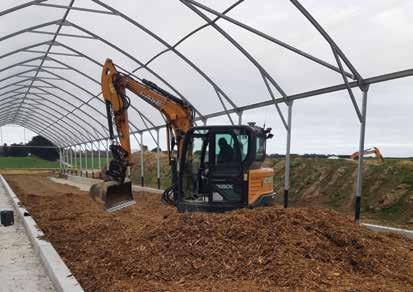
THE RANGE OF DIGGERS WILSON CONTRACTING RUNS INCLUDE A 6-TONNE, A 13-TONNE AND THREE 21-TONNES.
“It just grew organically from a couple of silage trucks. People want a one-stop shop these days – diggers, tractors and trucks.”
Initially they were all Nissans, but lately Shane has been buying Scania.
“At one stage Nissan were struggling to provide the right models, so we started looking. Now the European trucks seem to be a step ahead in terms of reliability and comfort.”
Shane buys them new and because their fleet is still growing they have yet to sort out a tradein timeframe.
“With the Japanese trucks we expect to get 600,000 to 700,000 km, but we hope to get a million ks out of the Scanias.
“If we get as good a run out of the Scanias as we have out of the Nissans we will be very happy. The Nissans have been very good to us.”
They run a few stock units, which are nine-axle, 54-tonne permits with 620 hp. These trucks do 100,000 km a year carting sheep and cattle. Lately they
have been carting store lambs from Canterbury back to Southland.
The other trucks are eight-axle and do local work, mainly carting stock, taking balage off the Wilson farms to dairy farms, running fertiliser to their spreaders, or carting rock to diggers.
Two of the trucks are now doing a contract with Downer, chip sealing around the South Island. Wilson Contracting also carts around 10,000 tonnes of roading chip to dump sites around eastern Southland to fulfil local roading contracts.
They run two MAN fert sowers and self-unloading trailers that spread fertiliser and lime for local clients.
Then there is the earth-moving side of the business. Shane says he now has enough diggers – a 6-tonne, a 13-tonne and three 21-tonnes. Several are Sumitomo and the others are Case.
“We’ve had a good run out of Sumitomo, and Case come out of the same factory anyway.”
Most of the work is farm-related and includes dairy lanes, maintenance and building sites, but they also do forestry roads and some commercial and residential developments.
On one of the Wilson Farms, the family started a quarry. That

gravel is used for local building and roading projects and to supply the local council with maintenance gravel for roads. They purchase all rock required for dairy lane maintenance from local quarries.
All these services have to work together. Spring usually starts around Labour Weekend, in late October, although there may be some ploughing before then as they prepare ground for fodder beet or return a winter crop back to grass.
Trucks working with Downers start carting chip in October as the sealing contracts start.
By November tractors are busy sowing grass and fodder beet, and the balers and choppers get moving.
By then diggers are doing drainage, and the muck spreaders are working to add effluent to paddocks being turned over.
“We have the same clients every year, and there are more wintering barns going up and they rely more on muck spreaders.”
After Christmas the baling and ground work settles down to merely busy, but the dairy farm maintenance with diggers and trucks cranks up a notch.
WILSON CONTRACTING HAS A GOOD RELATIONSHIP WITH AGRICENTRE SOUTH, WHICH IS ONE REASON THEY RUN A LOT OF KUHN EQUIPMENT AND CASE IH TRACTORS.
Muck spreading continues and many trucks are involved carting wood chip to dairy farmers right through into winter.
From the end of April trucks are carting cows to and from winter grazing until the end of August.
During winter when cows are dried off, is also the time to do track maintenance around the milking shed.
Around August and September, during lambing and calving, is the quietest time when “farmers don’t want to know us”.
Meantime over winter up to 1600 cows are grazing on the Wilsons’ farms. The farm manager does most of that work, although Shane and his team prepare the crops and bales.
IN SOUTHLAND, PLOUGHING IS A GOOD WAY TO TAKE GRASS PADDOCKS INTO A CROP BECAUSE IT AERATES THE SOIL SO IT DRIES OUT QUICKER.
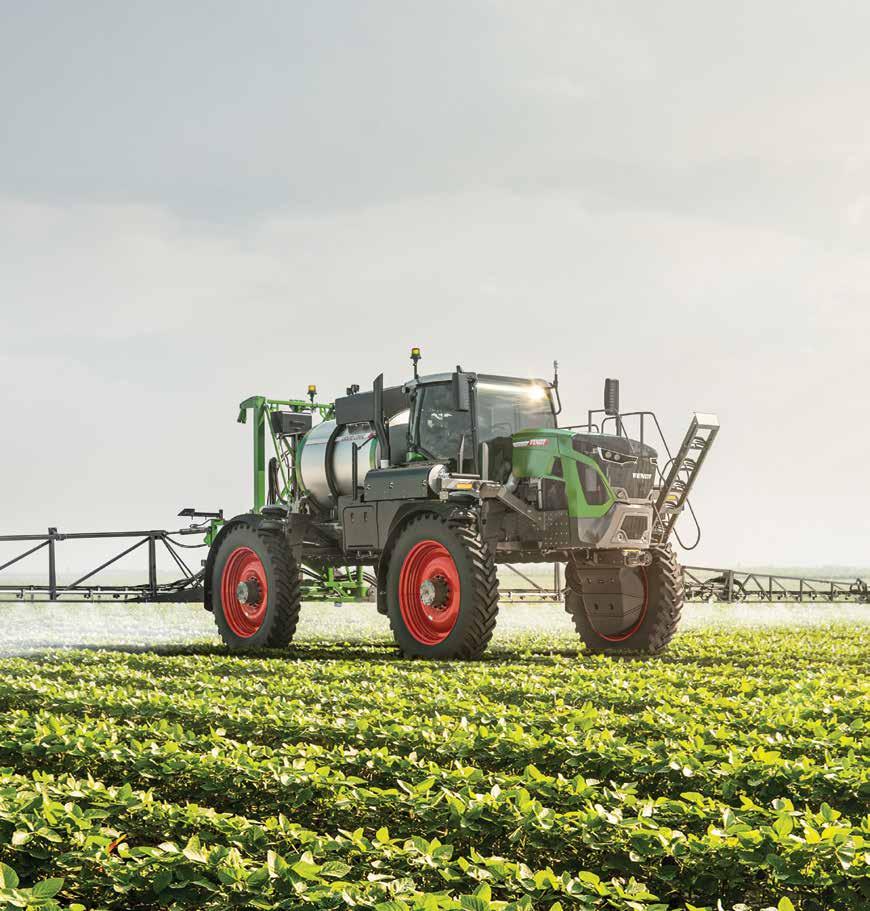


Leaders drive Fendt.

CANTERBURY DRONE CONTRACTOR VAUGHAN WARD HAS ADDED A NEW HIGH-CAPACITY UNMANNED AERIAL VEHICLE (UAV) TO HIS FLEET, WHICH WILL ENABLE HIM TO SPRAY, FERTILISE AND SEED LARGER AREAS.
Along with applying products or establishing crops, UAVs are used in agriculture to map paddocks and monitor crops and stock.
Vaughan says in certain situations drones offer advantages over both ground-based equipment and aircraft.
“Compared to helicopters and fixed-wing aircraft, they can accurately apply products close to power lines, tree lines or environmentally sensitive areas,” he says.
“Unlike trucks, tractors, or self-propelled machines, they do not leave wheel marks, or cause compaction. They can spray or apply granular fertilisers in winter or spring with zero damage when the ground would be too wet to drive on.
“We are in discussions with a
VAUGHAN WARD STARTED USING MAPPING DRONES AS A HOBBY BUT HE QUICKLY SAW THEIR POTENTIAL AND HAS GONE ON TO GET DRONES THAT CAN APPLY FERTILISER AND CHEMICALS.
farmer near Staveley who has pasture paddocks going up into the foothills. These areas are often too wet for trucks, but we can offer accurate and cost-effective granular fertiliser applications.
“This is an ideal situation for a UAV. With our new larger model, we have the capacity to do hill work like this but also to work on bigger paddocks on the Canterbury Plains.”
Vaughan sees lots of potential for UAVs in agriculture – for both contractors and farmers. Farmers may even want to have their own given their minimal cost com-
WITH HIS SMALLER SPRAY DRONE VAUGHAN WARD FOCUSED ON SPRAYING DRAINAGE CHANNELS AND STOCK RACES, BUT WITH HIS LARGER DRONE HE IS TARGETING ARABLE FARMS.
pared to a boom sprayer and the ability they give to apply products exactly where and when needed.
They also have the potential to support precision farming. Vaughan can equip one of his UAVs with a multispectral camera that collects data using differ-

ent light spectrums and thermal images to create normalized difference vegetation index (NDVI) maps.
NDVI quantifies vegetation by measuring the difference between near-infrared (which vegetation strongly reflects) and red light (which vegetation absorbs). This means NDVI images can be used to determine the density of plant populations in different parts of a paddock.
In turn, NDVI data can be turned into prescription maps that the drone can use to apply inputs at different rates in different areas.
“With this technology, you can identify variations in strike rates across a paddock or differences in the crop’s growth rates or weed density. Or you could detect if you have wet areas, perhaps from an irrigation leak.
“When you convert that information into a prescription map, the UAV will change application rates on the fly, so each part of the crop gets the optimal application.”
Vaughan is based in Ashburton and his company AgSmart UAV Ltd got off the ground in 2018. He began with a small UAV with a camera that he used for mapping and surveying.
Mapping with the drone was a part-time hobby that Vaughan

did on weekends, but he had higher aspirations.
“I could see the potential for agricultural drones and had been watching the technology advance. I had done some spraying as part of my day job, so I was comfortable handling agrichemicals.”
In 2019, he took what he calls a “leap of faith” and bought the first agricultural UAV that could apply chemicals and other products. This was followed by a second craft in 2022.
“I didn’t have a customer base, but I could see the opportunity

for the service. Eventually I had to leave my full-time employment. I had tried to reduce my hours and do both, but it got to the point that I could not fulfil all my obligations and I would have been throwing away contracting work.”
Getting to that point was not straightforward, and to get a
clearer picture of Vaughan’s journey you need to know something about how the Civil Aviation Authority (CAA) regulates UAV operations in New Zealand.
If anyone buys a drone, they are obligated to operate it under the CAA’s Part 101 rules. These rules apply to UAVs that weight 25 kg or less and they cover where and



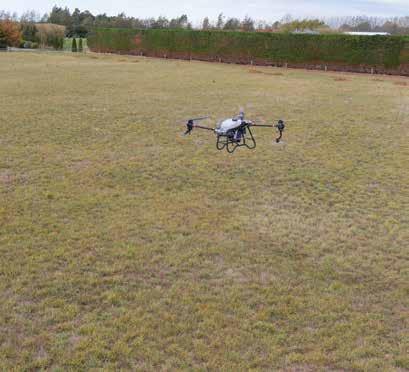
how high it can be flown.
For example, you cannot fly a drone at night, over private land without permission, within 4 km of an airport or helipad, or higher than 120m.
If you are going to operate outside of the Part 101 rules – that is if you are going to operate a drone that weighs more than 25 kg, operate at night, or drop particles from your drone – then you must operate under CAA Part 102 rules.
Under 102 rules, you must be certified by CAA to operate unmanned aircraft. The first step
in that process is to write (or have an expert write) your own operator’s manual, which is submitted to CAA for approval.
You must also hold other qualifications. These include Pilot Agricultural Chemical Rating, a UAV agricultural rating operational competency assessment (OCA ) and a UAV OCA. Both OCAs have to be renewed yearly.
This initial process took Vaughan around 19 months to complete. Once that was done, he was able to operate his first spray and fert spreading drone as well as his mapping drone.
WHEN DRONES APPLY FERTILISER AND CHEMICALS, THEY DO NOT LEAVE WHEEL MARKS OR CAUSE COMPACTION AND THEY CAN WORK WHEN THE GROUND IS TOO WET TO DRIVE ON.
All of AgSmart’s UAVs are manufactured by DJI, as is his newest, larger drone. The mapping drone is a DJI Matrice 300, an industrial grade mapping and inspection drone that can carry a variety of camera payloads.
Vaughan’s first agricultural UAV is a DJI MG-1P. It is an octocopter with eight rotors and is specifically designed for agriculture. It has a maximum weight of 25 kg and can carry a payload of 10 kg.
His latest agricultural UAV is a DJI T40. It is virtually four times the size of the MG-1P. It has a max weight of 100 kg and can carry a 40-kg payload.
“In 2019 I got work straightaway with the first spray drone assisting the regional council with drain maintenance.
“The area around Hinds and Coldstream were historically swamp land and it has a number of natural springs. A network of drains was built so that it could be farmed, and today the region-
Vaughan Ward was so convinced of the advantages that DJI UAVs offer compared to the other agricultural drones in the market, that he has signed on to become an agent for the brand.
“DJI’s New Zealand headquarters are in the North Island, and I thought they were missing out on the South Island market, so I approached them. I am now their representative for the greater Canterbury area.
“I think farmers will want to have their own UAVs to do their own work. I am happy to provide them both the sales and service support they require.”
For further information on AgSmart UAV’s services or DJI products, call Vaughan on 027 299 1225.
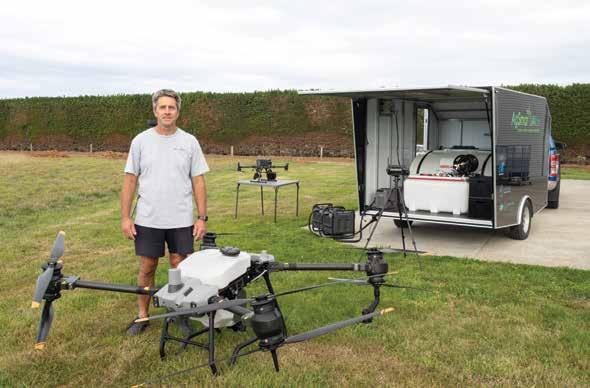
al ctouncil maintains a large percentage of them. They have to be kept clear of weeds so they continue to drain.
“Some of these drains weave through different cropping and dairy farms and access is not always easy. With the drone I can easily get places nothing else can get to. It does require a bit of walking at times, but it is very effective.
“I have been doing this work for several years now and I have developed good rapport with some of the landowners. They give me a call if they notice the weeds getting out of hand.”
Another early contract Vaughan got was with district councils, mainly spraying gorse and broom around stock races.
While he will continue to do this work for the councils with the smaller DJI MG-1P, now that he has the new DJI T40, he has the capacity to take on a wider range of broadcast and crop spraying jobs.
Although it is brand new, he has a number of avenues he is exploring for work. For example, he reckons the T40 will be a good option for farmers and seed companies growing high-value seed crops since it can apply products without any harm to the crop.
Vaughan is currently doing trials at a local vineyard to see how he could provide useful services, and he is working with a range of other clients. He is also collaborating with an agronomist to create prescription maps with the UAV, which could be another source of clients.
The T40 has the output, the spray width, and the speed to do larger jobs. It can fly around 10 minutes per flight (with the area covered in that time relative to the application rate required).
“It automatically adjusts its pump pressure to maintain the target spray rate. When it starts, it travels a bit slower, but as it gets to full speed it increases the pump pressure.
TO SUPPORT HIS LARGER UAV, VAUGHAN WARD GOT A CUSTOM-BUILT TRAILER WHICH CARRIES A 1100-LITRE WATER TANK, A MIXING TANK THAT ALSO FILLS THE UAV’S SPRAY TANK, AND A GENERATOR TO RECHARGE ITS BATTERIES.
“The spray width is 10m. The design of the rotors creates vortices that push the spray down into the crop, so it actually gives better penetration than a spray boom with flat fan nozzles,” Vaughan says.
When he bought the new larger drone, Vaughan also commissioned the construction of a custom-built trailer to support it. It has a 1100-litre water tank, a mixing tank that also fills the spray tank on the drone, a generator to recharge batteries, and storage space for all of the guidance and controls needed to run the drone.
“The efficiency of our operation depends on how fast we are from take-off to take-off, which means how fast we can refill the tank and change the battery. With our new mixing tank we can fill the drone’s spray tank in one minute and at the same time we just slide the old battery out and put in a fresh one.”
Vaughan can handle all agrichemicals with the UAV – herbicides, insecticides, and fungicides. Because the craft has a limited output, it must go slower to put on a higher water rate.
“Because they can apply chemicals so efficiently, there is a case to be made that UAVs should be able to work with lower water rates,” he says.
“In the States, spray drones are more common, and some of the chemical companies put specific application rates for drones on the labels of their products. We would like to see some of the chemical companies in New Zealand do the research on what the best rates for them is.”
When Vaughan does a job with the UAV, he typically starts with a file from Google Earth that shows the area to be covered. It is converted to a shapefile which is uploaded to the UAV. Its software then creates a flight plan that it will follow to do the job. Vaughan says it is not hard to change the flight plan manually, for example, if the wind was blowing from a particular direction.
DJI provides all of the equipment, software, accessories, mapping systems and guidance needed to run its UAVs. It creates an integrated system, which is one reason Vaughan opted for the brand.
AGSMART UAV’S MAPPING DRONE CAN BE USED WITH A MULTISPECTRAL CAMERA TO CREATE PRESCRIPTION MAPS, WHICH CAN BE USED TO APPLY INPUTS AT DIFFERENT RATES IN DIFFERENT AREAS.
“I like DJI’s usability. They have a great user interface and all of their products integrate together. That includes mapping and processing software. It is a complete system.”
The DJI equipment includes an RTK base station, which he uses on most jobs. Not only does it increase the accuracy of the job, it means the drone always lands in exactly the same spot, which makes refilling easier.
When doing a job, the drone selects the best way to follow the flight path in order to maximise the life of the battery. Although it sticks to the flight path, it also has the ability to identify objects and avoid them.
He is developing a mapping service to create prescription maps, and this is also done with DJI equipment. A multispectral imaging system uses six cameras – an RGB camera plus five cameras that cover the blue, green, red, red edge, near infrared and thermal bands.
The camera drone follows its flight path and takes itself without the operator’s direct input.
DJI software synchronises the images with DJI’s RTK system to accurately locate the images in time and space.
When the data from the images is interpreted to create NDVI maps, it will support variable rate applications. While there is not much demand for this now, Vaughan believes this will become common place in the future.
“We can provide farmers another option than just tipping on the same amount of chemical across their whole operation. They can reduce chemical use, save money, and lower their environmental impact.”
WHEN IT IS APPLYING CHEMICALS, THE DJI T40 AUTOMATICALLY ADJUSTS ITS PUMP PRESSURE TO MAINTAIN THE TARGET SPRAY RATE.

DRONE MANUFACTURER DJI ALSO SUPPLIES THE RTK BASE STATION WHICH GIVES ITS DRONES GREATER ACCURACY AND THE ABILITY TO ALWAYS LAND IN EXACTLY THE SAME PLACE.
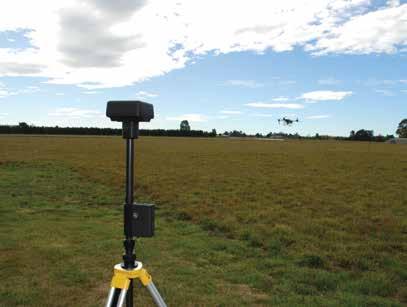
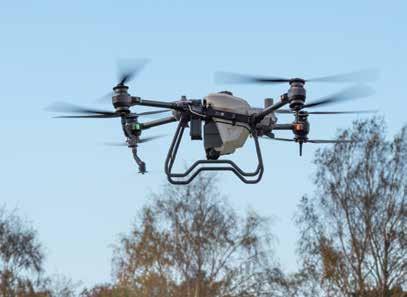
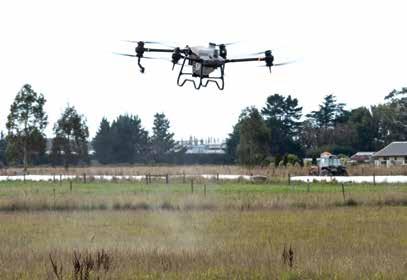

PARAMOUNT EFFLUENT SPREADING’S AIM IS TO HELP WAIKATO DAIRY FARMERS MEET OR EXCEED TODAY’S TIGHTER ENVIRONMENTAL REGULATIONS.
Nick Wright established Paramount Effluent Spreading in the spring of 2018. He is based at Cambridge and he and his small team clean effluent ponds for dairy farms throughout the Waikato region. The range of customers goes from “mum and dad farmers” right up to large corporate enterprises.
Hailing from a farming background himself, Nick has had a varied career in different fields of the agricultural industry in Europe, Australia and New Zealand. Six years ago that experience gave him the insight to see there was an opening to provide a state-of-the-art umbilical effluent spreading service in the Waikato.
“I was working for a general
‘BETTER LAID THAN SPRAYED’ IS PARAMOUNT EFFLUENT SPREADING’S SLOGAN BECAUSE THEIR DRIBBLE BAR SPREADING SYSTEM REDUCES NUTRIENT LOSS COMPARED TO IRRIGATORS OR SPLASH PLATES.
agricultural contractor and I saw an opportunity to offer something a bit different,” Nick says.
“I worked in the Netherlands from 2009-2012, and I had some mates who got into effluent spreading there. The Netherlands have some pretty stringent effluent regulations.
“New Zealand is behind in the regulation side of things, but we are catching up and it is only a matter of time. We are already starting to see the benefits from reducing the amount of synthetic nitrogen farmers apply, and effluent is a big part of it,” he says.
THE SPREADER TRACTOR HAS GPS AND A FLOW METER TO LET THE DRIVER KNOW HOW MUCH THEY ARE SPREADING AND TO PROVIDE PROOF OF PLACEMENT.
“We provide a full spreading service to large and small dairy farmers, and we can provide proof of placement. Farmers can use that to prove they meet regulations and keep the regional council and the milk companies off their back.”
Nick is not put off by the ‘yuck’

factor that some perceive comes with handling effluent.
“At the end of the day it is only cow shit. We just push the pipes into the pond and turn the vacuum pump on and away it goes. You don’t have to get your hands dirty unless it breaks down,” he says.
To set up Paramount Effluent Spreading, Nick bought a new umbilical effluent spreader with a 1.6-km hose and a dribble bar, plus a pond stirrer and a PTO-mounted pump.
He says an umbilical system is the most efficient way to pump and spread large volumes of effluent in a short amount of time. Paramount Effluent Spreading’s system can shift up to 280,000 litres/hour.
It is also an environmentally friendly way to pump effluent and it causes virtually no wear and tear on lane ways.
Paramount Effluent Spreading’s slogan is ‘Better laid than sprayed’, which refers to not only its umbilical system, but also its dribble bar.
“With the dribble bar, we can spread effluent evenly over 90-95 percent of a paddock and there is less nutrient loss com-

pared to irrigating or using a splash plate. It also limits interruptions to day-to-day farm operations and grazing routines.”
When Nick started the business, he was full-time on the umbilical spreader and hired casual workers to operate the pond stirrer and the pump. After doing that for four seasons, he hired a full-time employee last August to operate the spreader.
A semi-retired worker is employed to run the pump two to three days a week, so Nick can spend more time building up his business.
“It is hard to grow the business if you are sitting on a tractor 60 hours a week and not getting out to talk to people. You get a bit stagnant,” Nick says.
“With a full-time employee we can get through 25 to 30 percent more work. Also I can get out of the tractor for half of the week, which means I can work on the business rather than only working in business.”
When Nick started Paramount Effluent Spreading he ran a 230hp Case IH Puma tractor and in
June last year he added a second-hand, 220-hp Fendt 822.
The Case IH now runs the pump, while the Fendt has been put to work on the spreader.
“We got the Fendt not so much for the power, but for the ability it gives us to fine tune the spreading. The tractor really only needs to be strong enough to carry 1.6 km of hose, which amounts to about seven tonne,” Nick says.
“The Fendt is a nice tractor to operate and it works bloody well for us. Its Vario transmission lets us pinpoint how fast we spread so we can apply the effluent at
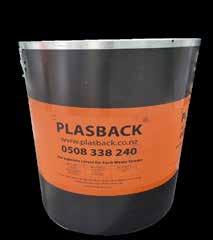



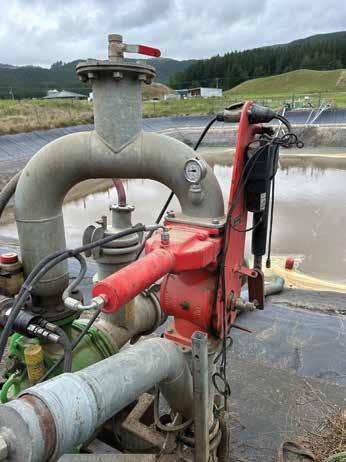
the right rate. And it has a fair weight in the chassis so it is stable on the road.
“Another benefit is that it is easier to get good staff when you have got a nice tractor to operate.”
The Case IH that was the spreader tractor has now been put to work on the pump to give it a bit more grunt.
Giltrap AgriZone in Cambridge is the dealer for the Case IH, while the Fendt was purchased from Power and Earth, which is based in Morrinsville. Nick says both dealers have been
good to deal with.
The spreader tractor has GPS, and Nick runs TracMap-Tabula and a flow meter through it as well. Together, they let the driver know how much is being spread and provide proof of placement.
Nick says the beauty of the umbilical system is that it is a straightforward bit of machinery.
“It is just hoses and a dribble bar. It is a very effective system and you can pump a lot through it. It is all about spreading the effluent out evenly.”
He has a couple of different stirrers depending on the applica-
NICK WRIGHT RUNS A CASE IH PUMA TRACTOR ON THE EFFLUENT PUMP AND A FENDT 822 ON THE UMBILICAL LINE.
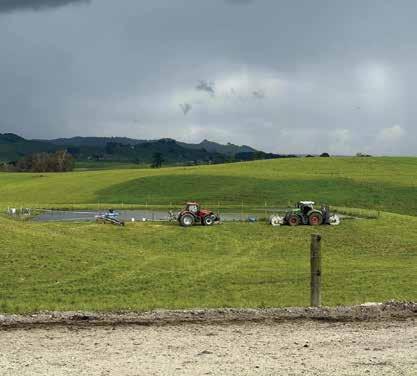
nick wright’s goal is to keep growing his business
He says that Paramount Effluent Spreading has been growing steadily over the last five years and in the next two years he wants to get another effluent system on the road – the whole set-up and another team to work it.
It might mean spending even less time in the tractor, but he wants to be ready for whatever comes his way.
“Staff are always coming and going, so you have got to be ready to do whatever it takes to keep it all going.”
AT THE EFFLUENT POND, PARAMOUNT SPREADING CAN USE A TRADITIONAL PROP STIRRER OR A LARGER JET STIRRER TO GET THE MATERIAL READY FOR THE PTO-POWERED PUMP.
tion. These include a traditional prop stirrer and a larger jet stirrer.
The prop stirrer is a 6m Pearson and can run on anything over 60-hp, while the jet stirrer is a 5.5m Storth.
Paramount Spreading can also arrange for a nutrient test, by taking samples from the effluent pond and sending them off to Hills Laboratory. This can be done prior to spreading to assist in the application decision or while spreading to help with the nutrient recording.
“It is about using the nutrient wisely and not putting it on too heavily. Making use of the effluent gives farmers some peace of mind.
“They know we have already applied a certain amount of nutrient and they can dial back on synthetic fertilisers, which is better for the environment and a
cost reduction.”
As technology improves and regulations tighten, Nick believes greater emphasis will be placed on proof of placement, whether the effluent is irrigated or spread into paddocks.
“It may get to the point where we need to inject the effluent into the ground rather than spreading it on top. In the Netherlands they enforce it, but there is a lot of cost in doing that.”
The situation in the Netherlands is different to New Zealand in that the cows spend more time indoors, which means they produce more effluent and it contains a lot more nitrogen, he says.
“You can’t be spreading it willy-nilly because you can do a lot more damage to the environment if it’s running off.”
For now advanced technology is slow to take off in New Zealand. Nick says just 15 percent of his
PARAMOUNT SPREADING GET SAMPLES FROM THE EFFLUENT POND TESTED SO THAT FARMERS KNOW WHAT LEVEL OF NUTRIENTS THEY ARE APPLYING.
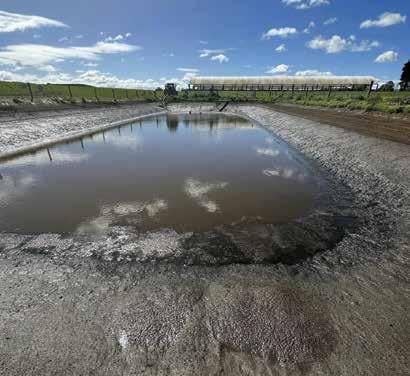
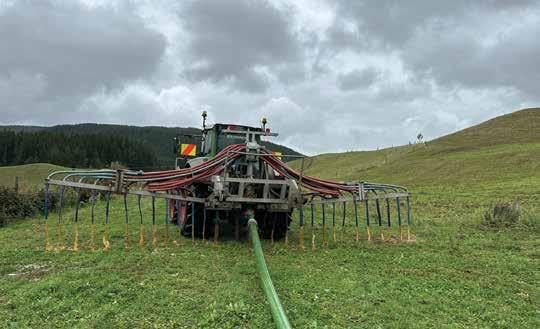
AFTER WORKING FOR A CONTRACTOR IN THE NETHERLANDS, NICK WRIGHT THOUGHT HE COULD OFFER KIWI FARMERS ASPECTS OF THEIR ADVANCED APPROACH TO EFFLUENT MANAGEMENT.
clients want the full technological benefits his service can provide. The other 85 percent just want to see the job completed.
While Paramount Effluent Spreading is fully compliant with local council requirements, the biggest challenge facing his clients is the current increases in
farm costs, with a percentage of them likely to go without effluent spreading services when their budgets are tight.
Effluent spreading is largely seasonal work, so the equipment needs to be ready to go when needed.
“We do a lot of work in the spring and autumn, working in with farmers when they are planting new crops. Through the winter we often help guys out with full ponds that they cannot get on top of, especially if they have had issues with their own effluent systems.”
Unlike most other forms of agri-
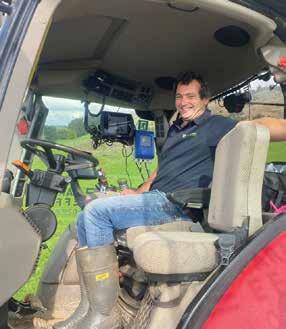
cultural work, Nick says being in the effluent game means having a summer holiday.
“You do feel a bit guilty when we are away on holiday and only doing a week of work a month over the summer when other guys are busy.”
Nick says he does most of the maintenance work for the effluent equipment himself, although he calls on his dealerships and local mechanics when needed.
“The gear has plenty of life in it yet, but we will look at buying more equipment as the work comes on.”
Having bigger tractors means
NICK WRIGHT WORKED A VARIETY OF JOBS IN THE AG INDUSTRY IN EUROPE AND AUSTRALIA BEFORE COMING HOME AND GOING CONTRACTING IN AOTEAROA.
it is relatively easy to move gear around. “We are all set up to tow a ute and the pond stirrers behind one tractor and the other carries all the hose.”
Nick tries to group jobs together to minimise time on the road. The majority of the time the tractors are not on the road for more than an hour a day.
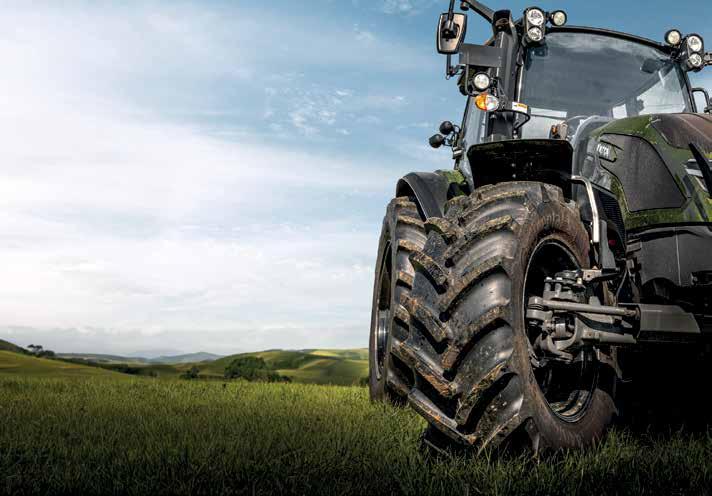
The all-new Continental Farm Tyre range has extra grip to help lower fuel costs and get the job done faster. Then there’s N-Flex resilience for extra damage resistance and a longer lasting, more comfortable ride. All backed by a 10-year manufacturer's warranty.
Technology that’s ahead of its field. So you can stay ahead in yours.
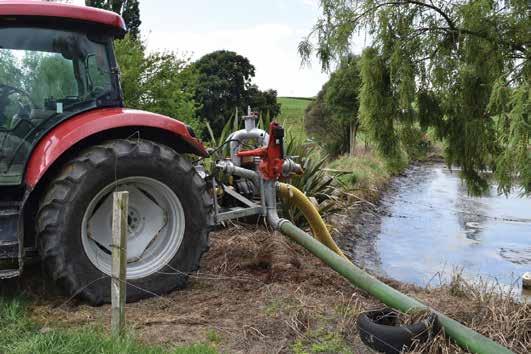
“When we go further afield, it might take us two to three hours to get there, but we tend to leave the gear there and drive home at night. The gear really only comes home over the summer or for the odd weekend.”
Nick’s team typically works a day on a farm, which includes pumping the effluent out of the pond and spreading it. But for the large corporate dairy farms the team might spend four days working away. “It all depends on the size of the pond and how full it is.”
Nick comes from an agricultur-
NICK WRIGHT SAYS AN UMBILICAL SYSTEM IS THE MOST EFFICIENT WAY TO PUMP AND SPREAD LARGE VOLUMES OF EFFLUENT IN A SHORT AMOUNT OF TIME.
al background. His family has a sheep and beef farm in the Wairarapa that has been in the family for four generations. His brother took over running it last year.
Nick attended Lincoln University, where he gained a Bachelor of Commerce, majoring in agriculture and accounting.
He had always had an interest in operating agricultural machinery and after graduating he spent four seasons in Europe working for a large Dutch contracting company, Rijko Bv.
Rijko contracts to food processing factories across Spain, Belgium, the Netherlands and Germany. They are contracted to grow and harvest vegetables, which are then frozen.
“The factories are the equivalent of Watties, I suppose, but a lot of the harvesting work is outsourced to Rijko,” Nick says.
“Each factory pretty much has its own harvesting crew, but
they bring in contractors so they know they have the supply to keep the freezers running. Rijko have quite a smart piece of the market, and it was interesting to see the logistical set-ups to make things work.”
At the time, Rijko had around 20 pea viners, six bean harvesters and a number of carrot harvesters in operation.
Nick had some mates working alongside him who started up an effluent business, which has since grown.
He then worked for a season in Western Australia driving combine harvesters during the grain harvest and replanting crops.
Later he stepped out of the tractor for a while and joined the corporate world. He worked for the large American global food corporation, Cargill, which had taken over the Australian Wheat Board.
He worked in Cargill’s logistics
THE PARAMOUNT TEAM CAN USUALLY CLEAN OUT AN EFFLUENT POND IN A DAY BUT IT CAN TAKE UP TO FOUR DAYS TO DO THE PONDS ON A LARGE CORPORATE DAIRY FARM.
team, managing road freight across the Australian eastern seaboard.
“I sat there for three years putting number ones on, doing the logistics and working with 200 other people,” Nick says.
But he missed working with the big machinery, so it didn’t take him long to get back to contracting. After he returned to New Zealand in 2016, he worked for Waikato contractor John Austin as customer manager. He then moved to the dispatch team for J Swap Contractors, who are involved in quarrying, bulk transport, and stock food supply.
This allowed him to learn about business practices and staff management in New Zealand and prepared him to go out contracting on his own.
Nick’s father had a company called Paramount Marketing, which gave the idea for the name of his business, Paramount Effluent Spreading. ‘Paramount’ means supreme or superior, which fits his aim to provide farmers a service that is second to none.
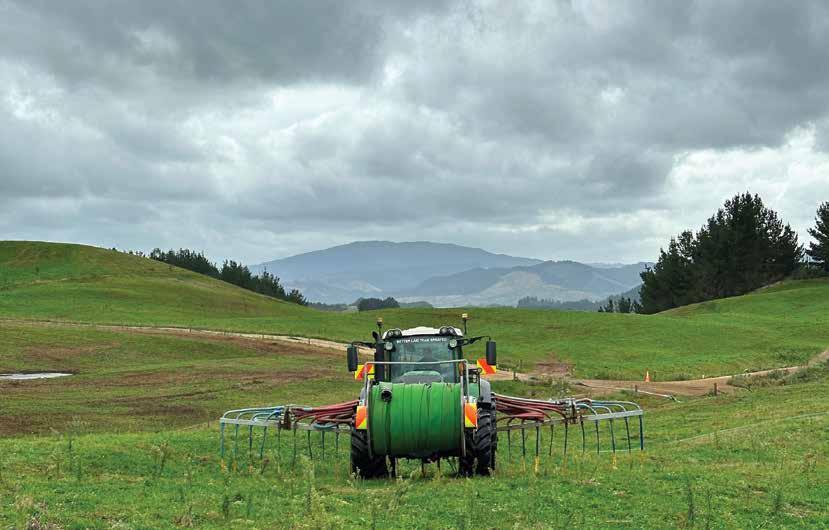
Nick owns 7 ha of land at Cambridge, He has a yard there for his machinery but he leases the land to his neighbour, who milks sheep.
Outside of his business, Nick is involved in the local squash club, plays golf and is an oar sponsor for the local Cambridge High School rowing team.


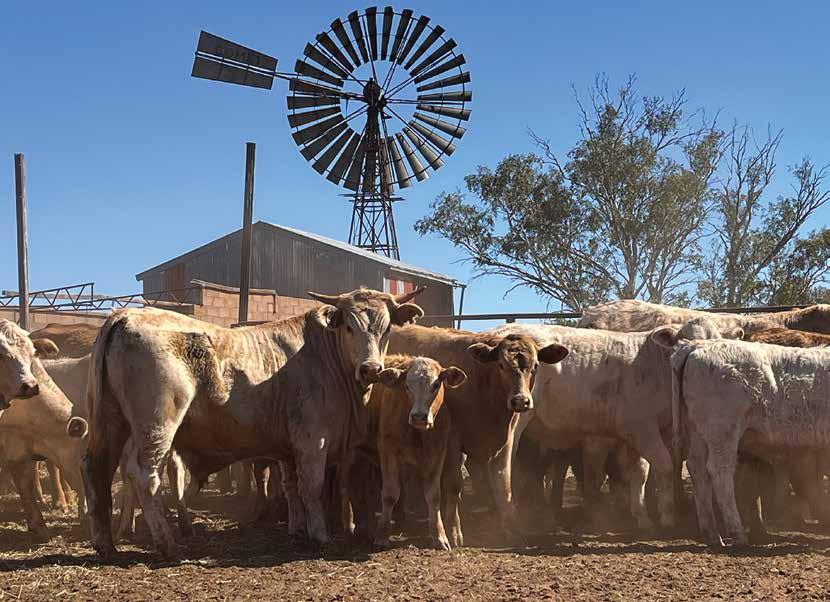
IT’S AN OUTLANDISH INTRODUCTION TO A CATTLE FARMER WHO, FOR THE MOST PART, SEEMS PRETTY DOWN TO EARTH.
The larger-than-life name tag is part of Gillian Fennell’s online persona as she and husband Mark share their life with followers, raising cattle on Lambina Station, a million-acre rangeland property in the Pedirka Desert, 450km south of Alice Springs in northern South Australia.
her two older brothers have, only seeing their parents in the holidays. Gillian and Mark also went to boarding school as youngsters in Queensland and it was here they first met.
Sharing their life on the land online, with humour, images and short videos adds a layer of fun and creativity to their lives. The more thoughtful blog posts, and industry commentary helps followers see the realities of production behind the humour.
Gillian initially got into social media to see what other farmers were doing on their land.
“I found it a fascinating way to learn about other people and other agricultural systems in other countries. They all seem to have challenges, including with their





And Lambina is very outback. The closest shop is in the town of Marla, a 70km drive away. Freight for the surrounding areas is delivered there once a week, meaning a long drive to collect or do the grocery shopping over rough roads. The mail and school work for their youngest child, Eleanor (8), is delivered by plane from Alice Springs to the letterbox on their airstrip at the back of the house, on a Wednesday.
“We hear them come in – they’ll drop stuff off and take off again,” says Gillian.
Eleanor will eventually head off to boarding school in Port Pirie as
CATTLE FARMING IN THE PEDIRKA DESERT SOUTH OF ALICE SPRINGS CAN BE CHALLENGING AT TIMES. SHOWING FARMING


governments and policy. I’d like to think they’re learning about agriculture from me as well.”
And it wasn’t just farmers who began following her, watching what was going on in stock cameras set up around the station, the cattle and wildlife that regularly visited, unwanted trespassers and camels, appreciating her sometimes sweary sense of humour.
Social media also became her way to bridge the divide between farmers and their urban counterparts.
A lot of farmers are too focused on their own issues, Gillian believes, while it’s in their own best interest to reach out - especially to those in towns and cities.
“We need urban people to understand farming life better so they feel more connected to people living on the land and the countries’ food systems,” she says. “There’s a lot of negativities around farming and people often don’t make the connection we are real people. We may not have the exact same struggles or issues but we all want what’s best for our families, access to a decent education and health care – these are universal things.
“Someone has to extend their hand and I think agriculture has to do it first. We need to connect on a human level or nothing will ever change.
“We’re such a small number of people, and a small number of the vote base. No political party has to pay attention to us and our needs. We have all these people in the cities, who have no idea about farming, saying we need to protect the environment. We need these people in cities to also say we need to look after the farmers too - to protect our production systems, to pro -
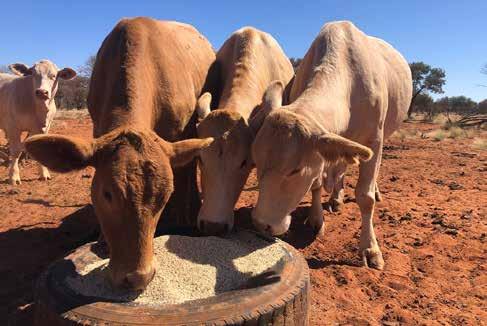
tect our food sources.”
Gillian has also been critical of conservatism within the agriculture industry’s leadership. Failing to engage as the industry faces new pressures including from climate change is doing their membership a disservice she believes, as it locks the industry out of senior level discussions around planning, strategies and policies.
“You lock yourself out of the room when, if you’re genuinely serving your members and your industry, you should really be staying in there until they turn the lights off and kick you out.”
With these big picture views on agriculture it’s perhaps no surprise that Gillian is an industry representative on the board of Livestock SA, as well as being on a couple of committees of Cattle Australia (Cattle Council of Australia).
This sees her periodically off the station at meetings and conferences, meeting new people and hearing their stories.
Her followers often get to follow along on these trips.
While Gillian loves the outback, she admits it can be a bit drab and as she’s a bit of a magpie, something sparkly is usually part of her ensemble when she heads off the station. It’s also why she called her recent start-up media/ communication business Glitterati Media.
Gillian admits station life was tougher than she expected when she and Mark first settled in to help run the property 21 years ago after Mark’s parents decided they wanted a change to
farming life in Queensland.
While Mark’s family had always farmed, Gillian had grown up in Richmond, a small town in northwest Queensland whose main claim to fame was Minmi - Australia’s best preserved 100-million-year-old dinosaur skeleton, and the marine reptile museum Kronosaurus Korner.
Travelling around with her dad when he was working as a station mechanic, and watching her grandfather shearing wasn’t enough to prepare her.
Nor was the contracting job she did with Mark when they first got married and she left her “cushy” office job to maintain and repair windmills on the Barkly Tablelands in the heat of summer when most of the work was done. This saw them both living rough and sleeping for weeks at a time in swags.
Climbing to the top of 40-foot structures with a great big spinning wheel on the front to do maintenance can be dangerous she says, and they had a lot of close calls. And coming across venomous brown snakes while climbing down wells to the pumping infrastructure at the base was also memorable.
While windmills may be an iconic image of outback Australia, they are fast disappearing
from the landscape.
A windmill will only pump when the wind is blowing, but there’s also no real way to stop it when it is blowing. Once the tanks and everything else are full, the water pumps out onto the ground. This is one of the reasons people have been moving to motor pumps which are easier to run and maintain.
On the station Gillian and Mark are transferring their last two windmills over to solar pumps which have a shuttle switch and will stop pumping automatically once the tanks are full.
“The sun shines pretty much every day, but we can go weeks without enough wind to pump water for the cattle.”
Completely off grid, power on the station has been a work in progress since they moved in.
For a long time, they ran a generator. But this went off at 10pm and didn’t start up again until 6am. This meant no water during the night with the fridge and freezer also turning off with food going off quicker, especially in summer.
Gillian and Mark are used to the heat now and don’t think it’s anything extraordinary. But with no air conditioning in the early days, Gillian was really suffering when carrying her first baby through summer with temperatures hit-
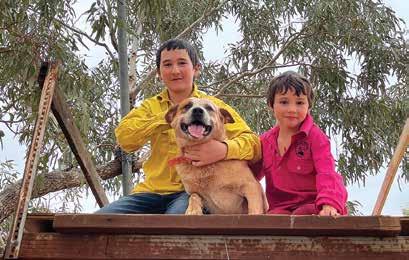 A RECENT SYSTEM UPGRADE SAW THE END OF ACID BATTERIES.
A RECENT SYSTEM UPGRADE SAW THE END OF ACID BATTERIES.

ting 45 degrees Celsius. To get some sleep, she ended up with a mesh gazebo set up on the front lawn with a bed in it. The sprinkler would water the grass and when the power went off, she’d sleep in the gazebo overnight with a cool breeze coming off the wet grass.
When Alan was born, bottle-feeding meant boiling water with the gas stove and torch light.
For Stephen, born five years later, there was at least 24-hour lighting.
By the time Eleanor came along in another five years, Mark had designed and built a solar power system providing 24-hour power and water, and as a winter baby she even had a heater.
These days, the house has evaporative air conditioning. Not
as power hungry as refrigerated air-conditioning but, if it isn’t humid, it’s enough, she says.
The solar system 15 years ago had panels covering the top of a 20ft container which was full of acid batteries needing to be topped up with water every week.
Mark’s recent upgrade sees a 17kW solar array with a 24kW three phase output microgrid supplying power to the buildings on the station. The panels are smaller and more efficient, with six lithium-ion batteries that look like bar fridges.
“That’s enough storage for our three dwellings and the work shed, and enough battery storage to run all that for about two days if we get cloud cover.”
The output can be expanded to
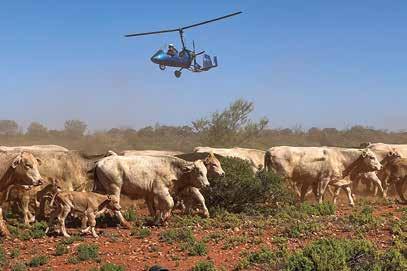
25kW in the future if needed, with each of the buildings able to have additional solar panels added. Falling component prices saw the upgrade come in at $60k - half the price of the original system. Because they’re so isolated, contractors are pretty thin on the ground, and they need to be self-sufficient and do things themselves.
This has seen them build up all the equipment they need – loader, grader, backhoe, crane, and a couple of trucks, even if most of it is over 30 years old.
Mark’s repair and maintenance skills have also come in handy in recent years and enabled him to discover a love of flying. He is now happiest when in the air at the controls of the two-seater ultra-
light gyrocopter they bought.
Marketed as a recreational flying machine and made in Germany, the AutoGyro comes in a box ready for home assembly. Much cheaper than a helicopter, the AutoGyro can cover hundreds of kilometres and can see Mark gone for six hours, says Gillian. Able to do their own servicing, the aircraft is also cheap to run.
Their manoeuvrability at low speeds makes them ideal for life on a cattle station, although they aren’t meant to be used for commercial purposes like mustering and there are rules around how high they can be flown.
“He’s passionate about it and takes it very seriously. If we could afford it, he’d love to have a helicopter,” says Gillian, whose air-


sickness sees her stay firmly on the ground.
Aircraft ownership, particularly fixed-wing, is popular among landowners in the area including for mustering while others use contract helicopter pilots.
Motorbikes were used a lot more for mustering in the past, but labour shortages and a lack of experienced riders with the skills to muster out in the bushwithout stressing the animals too much, means smaller numbers are being used.
“A lot of blokes just like to chase shit but that’s not helpful to anyone,” she says.
The stony plains on the property also make riding at speed, for the inexperienced, difficult and dangerous.
Pedirka Desert covers around half the land and has undulating red sand hills covered in trees and native grasses. The Mulga wattle tree is common, and with an unusually long tap root, is able to withstand long periods of drought. It’s also very palatable to sheep and cattle, giving them both food and shade, with urea part of a feed supplement for the cattle which helps them to digest the woody matter.
Loamy clay soil makes up the rest of the property and, while it is stony, it grows good feed with enough rain.
Not surprisingly in this part of the country rainfall is never high80 inches annually in the extreme west falling to just 5 inches in the east, with drought fairly common.
This sees the couple running 5000 Charbray cattle - a cross between French Charolais cattle and American Brahman cattle. These hardy animals are well suited to the heat and desert conditions. Their light colouring helps keep their bodies cooler and they are also resistant to humidity, parasites and diseases. The challenging conditions mean they only breed from their own cattle which have naturalised here, as outside animals often don’t survive.
Because of the large distances on the rangeland and limited fencing infrastructure, over time Gillian and Mark have learnt to use the cows natural herding instincts so they move to new forage largely on their own.
By putting in more water points and then turning them on and off, the cattle shift themselves. This
also helps to maintain biodiversity and the health of the country, by reducing overgrazing, says Gillian.
“They’ll graze out to a maybe 10km circumference from a water point, maybe 25 if they’re young cattle or steers.”
They also don’t control joins, having bulls in with the cows all the time. They have found the cows cycle naturally on feed availability and rain fall, and become fertile when conditions are such they will be able to raise a calf.
They do, however, make sure the bull size is matched to the heifer size, with only young bulls going in with maiden heifers so they aren’t being covered by big giant one tonne bulls, she says.
Maintaining production through droughts sees them change weaning practices - taking calves off earlier, along with culling unproductive cows and other unproductive animals out of the herd, ensuring enough food is left for the productive animals.
They also try and breed traits that reduce the need for intervention for animal welfare with the focus on polled cattle, small birthweight bulls, big frame breeders with wide hips so calving is easier.
Having to handle the cattle through the yards alone, a lot of breeding effort goes into a quiet temperament (research has shown calmer cattle are also more heat tolerant than excitable ones).
This sees a difficult temperament as one of the four T’s they cull animals on.
The others are teeth which need to be in good order for obvious reasons, toes too long making it
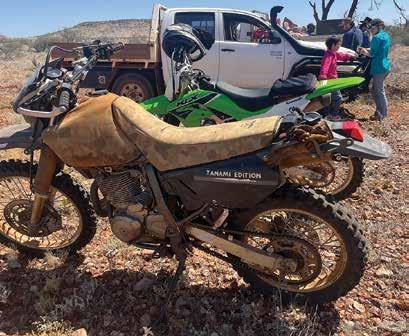
GOOD RIDING SKILLS ARE NEEDED ON THE STONY EARTH AT MUSTERING.
harder for animals to travel, and “bottle” teats that are large and difficult for calves to latch onto.
“We want them to live, breed and survive with as little human interference as possible,” says Gillian.
Because the cows are producing calves as conditions allow, animals are sent to market sporadically. But being a small operation, they are still able to maintain a good cash flow and remain financially stable.
Angus and Hereford cattle are very popular beef breeds in SA, says Gillian. With buyers less familiar with Charbray cattle and unsure how they will go in feedlots, the animals don’t do so well going through the yards.
Along with wanting to avoid agent and yard fees they sell their stock privately.
This has seen them recently buy a farm block 900kms south in the Flinders Ranges where they can stockpile large numbers of cattle to sell, and where prospective buyers can come and see them.
A B-DOUBLE MACK FOR TRANSPORTING CATTLE IS PART OF BUSINESS EXPANSION INTO THE FLINDERS RANGES.
Purchasing a B-double Mack truck to get them there means they are now self-reliant with transport.
At 10 - 11 hours drive away, it is also within livestock transport guidelines before the animals would need to be unloaded and spelled.
It’s been a valuable addition to the business, says Gillian, as they also grow lucerne there. When they deliver cattle, they can then bring hay back to the station.
While Gillian’s industry involvement and activity on social media doesn’t generate revenue, it has seen her guest writing columns for agricultural media, making appearances at events and participating in conference panels.
Along with her boutique social media company she is also involved with Australian agricultural platform Farm Table.
Gillian and Mark can be found on Twitter/X @stationmum101, Instagram & Threads - @stationlife101, and Linkedin - Gillian Fennell.

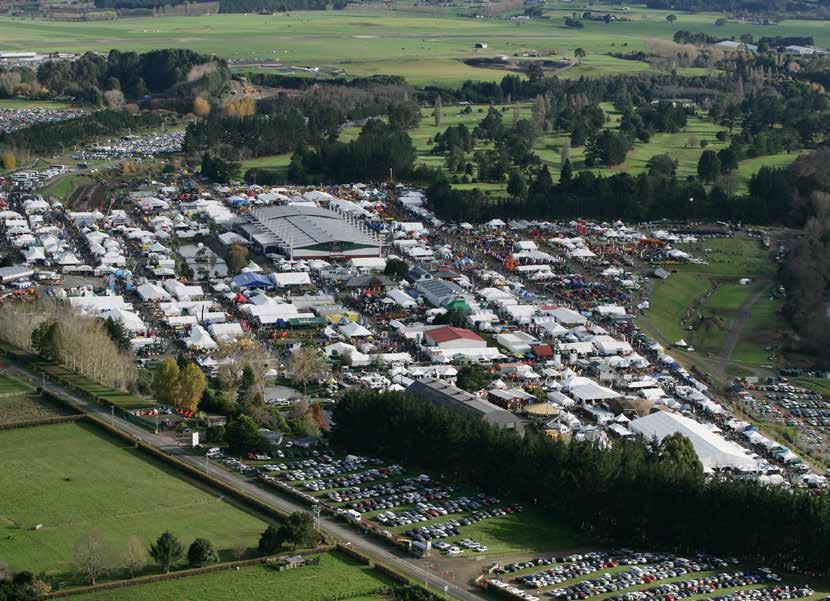
MACHINERY SUPPLIERS OFTEN UNVEIL NEW PRODUCTS AT NATIONAL FIELDAYS. IT IS THE IDEAL PLACE FOR FARMERS AND CONTRACTORS TO CHECK OUT THE LATEST TECHNOLOGY, COMPARE BRANDS, AND LOOK FOR BARGAINS. HERE IS OUR PREVIEW OF THE MACHINERY THAT LEADING DISTRIBUTORS WILL HAVE ON DISPLAY.
AGCO
The large AGCO stand at National Fieldays will display tractors from its three major brands –Fendt, Valtra and Massey Ferguson – as well as a full range of Fendt grass and hay harvesting tools.
Big attractions in the Fendt lineup will be a Fendt 700 Vario Gen 7 and the flagship model in its tracked MT 900 Series, the 431hp 943 Vario MT.
Also on hand will be Fendt Rotana balers, a Fendt Tigo loader wagon, a Fendt Slicer triple mower combination and a Fendt Lotus tedder.
The new Fendt 700 Vario Gen 7 range is powered by a 7.5-litre AGCO Power Core engine and the same VarioDrive transmission that has been proven in Fendt 900 Vario and 1000 Vario tractors.
VarioDrive is an all-wheel drive transmission that gives infinitely variable speeds from 20 metres/ hour to 60 km/hour.
Fendt 900 Vario MT has a powerful seven-cylinder AGCO Power engine. The 9.9-litre engine generates up to 431 hp at just 1700 rpm.
Like all of the latest high-horsepower Fendt tractors, MT 900 Vario tractors feature a VarioDrive CVT and the Fendt iD lowspeed concept, which delivers maximum torque at just 1450 rpm.
With Mobil-Trac tracks, MT
tractors deliver more traction, less soil pressure and an optimal weight distribution across the entire contact area.
The butterfly mower combination on show at Mystery Creek will be high capacity Fendt Slicer 960 rear mowers with a front-mounted Slicer 310 F. Together they give a working width of 9.6m.
Fendt mowers feature the durable and efficient Streamline spur gear cutterbar. Streamline cutterbars deliver high throughput and a steady flow of forage even in

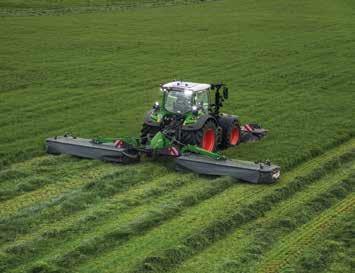
challenging conditions.
The Tigo XR loader wagon XR range has models with carrying capacities from to 100m3. On the AGCO stand this year will be the 75m3 Tigo 75 XR.
Tigo XRs have the VarioFill automatic loading and unloading system. VarioFill optimises capacity by using the bulkhead to load and pre-press the crop. It also helps completely empty the bin during unloading.
A full representation from the Valtra alphabet will be on display
at Fieldays. They include models from the A, N, T, Q and S Series.
Valtra has a strong focus on operator comfort and all models have a great working environment thanks to the SmartTouch armrest, A-Pillar digital displays and redesigned cab interior.
Covering the power range 155271 hp, the Valtra T5 Series is popular in New Zealand. They have a six-cylinder AGCO Power engine and a drive train that delivers high power at low revs.
Valtra T5s are the ideal loader tractors. It is easy and quick to mount or remove the loader from

the tractor, and the T5’s long wheel base gives it sufficient weight and stability to handle loader work.
A multi-function joystick gives full electric control of the loader, which has lifting power above 2.5 tonnes. The operator can keep an eye on the loader during work through the roof window.
T5 tractors are designed to make precision farming easier. The Valtra Smart Farming package gives Valtra Guide auto-guidance, ISOBUS connections, section control and variable rate applications.
Leading the MF line-up on the AGCO stand will be 8S and 7S Series tractors.
Built on a 3m wheelbase, the 8S Series offers max power from 205 hp to 305 hp. All deliver comfort, connectivity, power efficiency, and low cost of operation.
The six new models in the Massey Ferguson 7S Series offer maximum power from 145 hp to 210 hp. They are equipped to a high specification as standard and come with a choice of transmissions, cab comfort, automation and control technology.
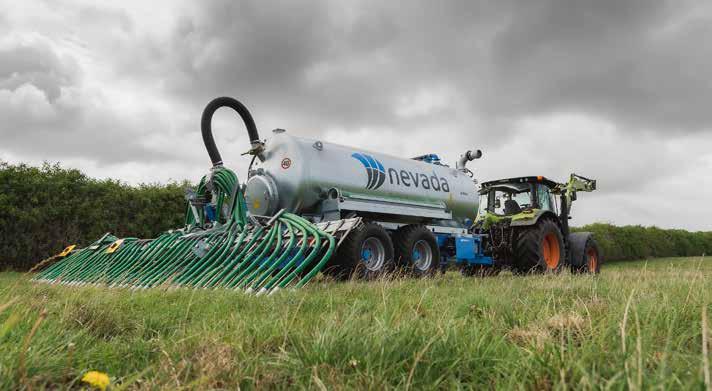
Hustler Equipment’s new Combi RX2 (Series 2) multi-feeder wagon is a groundbreaking addition to the Combi RX multi-feeder range.
The Combi RX2 has a number of features that are based on feedback from farmers. It will be on the Hustler stand at this year’s Fieldays, five years after the first generation Combi RX was unveiled at Fieldays 2019.
Hustler CEO Brent Currie says the Combi RX has a simple and unique pusher design. It eliminates high maintenance chains, bars, gearboxes and bearings of conventional feedout wagons.
“Our original Combi RX delivered reliability and low maintenance, and we have built on this benchmark. After more than five
years of invaluable feedback from owners, we are rapt to be able to release the Combi RX2.
“The Combi RX2 takes another leap forward in reliability. It requires even less maintenance and is more user-friendly. Whilst many of the improvements appear subtle, together they add up to a significant step forward,” Brent says.
One significant upgrade is a wider cross floor design. This ensures that when feed is pushed forward, potential crushing and jamming is mitigated.
The wider cross floor comes with a steeper left-hand side in the feeding chamber. This design is more user-friendly and reduces the risk of errors that inexperienced operators can make.
The front of the Combi RX2‘s
chassis rail now has an angled design, so the tractor can turn tighter without the risk of the tractor tyre rubbing against the chassis rail. A new plastic bonnet and redesigned antenna look modern and protect the FeedLink weighing and feed management system from the elements.
Larger pushing rams provide greater pushing power and, therefore, the ability to handle heavier loads.
Brent says the three models in the Combi RX2 range are the Combine RX148, RX178, and RX218. They have an improved spring and sub-frame design for less greasing, less wear, and lower maintenance for high-end operators.
“We worked with ag tyre manufacturer Ascenso to develop larger diameter, 20 ply tyres for greater load rating and dura-
bility. We have optimised hose routing to reduce chafing and improve flow.”
The Combi RX 2 also has a simpler pusher blade, reduced weight and increased strength.
Brent says all these features build on the already impressive leap in feedout wagon reliability and low maintenance that Combi RX brought to the market in 2019.
Hustler has also introduced an optional Trough Feeding Kit as a factory fit for new Combi RX 2 models or as a retrofit option for all original Series 1 Combi RXs. This kit includes unique feed bars and a hooked elevator that better release stringy hay, silage and balage.
It is great when feeding into troughs, on feed pads or over fences, where precise feed drop placement is crucial.

Leading the line-up of the latest machines that Kuhn will have on display at National Fieldays will be VBP 7100 combi balers and the Axis 40.2 MEMC fertiliser spreader.
Kuhn VBP 7100 baler-wrappers are designed for contractors and farmers who want the most powerful and versatile machines.
There are two models in the VBP 7100 Series. The VBP 7160 produces bales with diameters

of 80-160 cm, and the VBP 7190 produces bales with diameters of 80-185 cm.
Both models can be equipped with the optional Kuhn filmon-film binding system. Kuhn’s unique film binding system uses two regular 750 mm stretch-film rolls rather than a specialist mantle film.
Kuhn’s twin-roll film binding system has a much higher prestretch ratio compared to mantle film, which reduces film cost and extends the intervals for changing rolls.
Another advantage Kuhn VBP 7100 heavy-duty balers offer is consistent high performance in all crops and conditions. They can produce large, dense straw bales or perfectly-shaped silage bales with high moisture content.
Today’s farmers and contractors need baler-wrappers to be versatile, high-density, high-ca-
pacity, and durable. With the VBP 7100 Series, Kuhn meets this challenge.
These combi balers can produce well-shaped and dense bales in various crops and conditions due to these features:
• Patented i-Dense density regulation system gives optimal bale starts and baling pressure. It enables the VBP 7100 to produce high density straw bales.
• The intake system with up to 23 knives gives a wide range of cutting lengths.
• The optional Kuhn Twin-reel film binding system allows more efficiency in silage crops.
Every component in the VBP 7100 is designed to ensure maximum capacity. Notable features include a three-tine integral rotor and specially designed crop roller for unrestricted crop intake.
The bale chamber features a double tension arm for guaranteed bale start, high densities,

The Power Farming stand at Mystery Creek will feature a representative mix of its tillage, seeding, harvesting and spreading implements.
This year Power Farming will be showing off a five-furrow version of the new generation KV 3400 S plough, which can work on-land and in-furrow.
Kverneland 3400 S ploughs are relatively light, so they are easy to lift and pull. They are available with five, six or seven furrows and can be run with tractors up to 385 hp.
The patented stepless Variwidth system allows the operator to make infinite adjustments of the working width. It is available with either hydraulic or mechanical furrow adjustments.
Benefits of Vari-width include time and cost savings because ploughing can be done with maximum capacity at all times. It also gives the ability to work right up to hedges, fences and ditches and consistently maintains the right line of pull, which reduces the draft requirement and wear and tear.
A 4m seed and fertiliser version of the U-Drill will be on the display. In one pass the U-Drill prepares a seedbed, levels, reconsolidates, drills the seed (and fertiliser) and presses.
U-Drills come in working widths of 3m, 4m and 6m, and they deliver accurate seed placement at speeds of 6-18 kph. Row widths can be specified at
12.5 cm or 16.7 cm.
The U-Drill can now be specified with minimum disturbance (MD) discs on the front disc harrow. These are waved vertical tillage discs.
Other Kverneland implements available for viewing will be an advanced KV Geospread iDC spreader, an iXter B sprayer front tank, and two mowers – a KV 2832 disc mower, and a KV 5087MT butterfly mower-conditioner paired with a 3632FT front moco.
The KV 5087 has a floating suspension, non-stop break-back protection, and the option to run the conditioners at 600 rpm or 900 rpm.
Kverneland’s 2832 FS is the first front disc mower with an actively driven swath former that can do either narrow swathing or wide spreading. It has a working width of 3.16m and can produce swaths 1m, 1.15m or 1.3m wide or wide spreading up to 2.2m wide.
When it comes to PTO-driven tillage gear a folding Maschio Puma rotary hoe will be on hand. Available in working widths from 3.2m up to 4.7m, Puma rotary hoes are ideal for contractors or medium-large farms.
They deliver excellent soil finishing and outstanding hourly work rates. They have a transport width of just 215 cm and can be paired with tractors in the mid power range.
Maschio Tigre mulchers can be used on row crops, pasture or maize stalks. Tigre mulchers


come in working widths up to 3m. They have a rigid structure thanks to their double-sheet frame, and their notched double blades guarantee optimum cutting even in tough conditions.
Two leading Fliegl spreading machines will be at Fieldays – an ADS 120 muck spreader and a VFW-8600 slurry tanker.
Fliegl ADS spreaders have a fully galvanised steel body with a unique horizontal push-off system that consistently unloads the manure. The push-off wall and a section of the floor move in sync towards the rear of the trailer.
Without chains to tension and with fewer moving parts, Fliegl ADS spreaders can spread manure, compost and other organic waste quickly and efficiently.
Fliegl vacuum tankers feature robust compressors that create the negative or positive pressure rapid fill or empty the tank. The steel tanks are fully welded and inspected down to the very last detail.
Each tank is galvanised both inside and out to ensure maximum corrosion protection. Safety mechanisms, such as the sealed pressure relief valve, ensure hazard-free use.
and quick re-tensioning. And the fast tailgate and bale transfer help the VBP 7100 achieve high productivity.
Durability is reinforced by the heavy-duty bale chamber, heavy duty rollers and drive components, reinforced frame and extra-large tandem axle and tyres.
Kuhn’s Axis spreaders have hopper capacities from 1000 to 4200 litres. The Axis 40.2 M is an ISOBUS machine with a max-
imum spreading width of 42m and a maximum load capacity of 3200 kg.
Axis spreaders offer the advantage of the CDA distribution system. CDA gives accurate spreading in all conditions and continuous regulation with a weighing system. With this system an Axis spreader maintains an even spread when the operator alters the spreading rate .
Another advantage Axis spreaders offer is an extra-slow rotating agitator. In an Axis spreader the agitator rotates
at a speed of just 17 rpm, which preserves the quality of the granules and improves fertiliser flow. Axis spreaders have the advanced electronic mass control (EMC) system. EMC regulates the flow of fertiliser to the left and right spinner by monitoring the flow to discs on each side of the spreader with torque sensors.
Sensors measure the driving torque on each disc every second and adjust the fertiliser flow independently. Therefore, fertiliser flow is automatically adjust-
ed independently for the left and right discs. With EMC, the flow to each disc is unaffected by slopes or vibrations. You get better fuel efficiency thanks to the reduced engine speed. No calibration test is required – just programme the dose and start spreading.
The Axis 540.2’s application rate range is very versatile and you can use GPS to accurately achieve a precise application rate.
For more information, visit www.kuhn.com.
Krone New Zealand will display a full range of Krone products at National Fieldays – mowers, tedders, rakes, balers, wrappers and the mighty BigX 780 forage harvester.
Two Krone disc mowers will be on hand. Krone ActiveMow and EasyCut disc mowers have reinforced components and, therefore, resist wear and tear for an extended lifespan. They have flexible hitching systems and are compatible with a variety of tractors.
Krone disc mowers are where innovation meets efficiency and there is a wide range of models, from compact to high-capacity.
The innovative features on Krone Vendro tedders ensure superior work and operator comfort. Their robust design ensures
downtime is minimised.
Whether you are working with grass or other forage crops, Krone rotary tedders adapt to different forage types with ease to speed up drying. Designed to provide exceptional manoeuvrability, Krone tedders handle tight turns and contours, and ensure efficient tedding.
Once you have wilted or dried your crop, you need to efficiently gather it into perfectly formed windrows. Krone Swadro rotary rakes deliver clean, gentle raking for minimal leaf loss and optimal drying.
A Swadro rake can revolutionise your forage production with a performance that redefines efficiency and reliability.
Forage farmers and contractors know that the perfect bale
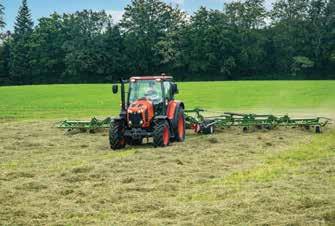
Along with models from its range of fertiliser spreaders, SAM Machinery will have models from its new tip trailer line-up with hightail sides.
SAM Machinery has been building rugged hydraulic tip trailers to serve Kiwi farmers and contractors for decades. Built in the Waikato, all feature heavy duty construction, high quality components, and a mega-strong corten steel deck.
They also have easy-to-use drop-down, tool-less sides for convenient side loading and a versatile tailboard that makes it easy to spread metal or other material.
Now SAM Machinery has redesigned the drop down sides with a hightail design that eliminates
is the end product of machines that have been engineered and built to deliver efficiency, precision and unwavering reliability.
Krone round and square balers can revolutionise your operation with every perfectly-formed, high-density bale. Krone’s advanced baler technology produces tightly packed, uniform bales that deliver the highest quality fodder.
For the final step in quality balage, Krone’s EasyWrap 165T has an advanced wrapping mechanism that delivers superior bale sealing. EasyWrap wrappers create a tight, secure seal that preserves the freshness and nutritional quality of silage. EasyWrap wrappers are fast so you can wrap more bales in less time.
For fine chopped silage, the
Krone BigX delivers precision cutting, efficiency and reliability. Krone forage harvesters are engineered to maximise the harvest, from field to stack.
BigX forage harvesters deliver cutting-edge technology and durability. Their robust construction withstands the demands of heavy use. From the chassis to the cutting mechanism, every component is built for longevity and consistent performance.
Smart technology and user-friendly controls make life easier for the operator and boost efficiency. Step into the future of forage harvesting with Krone BigX self-propelled forage harvesters.
Krone products will be on display at Fieldays at site G50. For more information visit the website kronenewzealand.co.nz.

spillage when tipping. Hightail sides are standard on all trailers in the range.
Models in the SAM tip trailer range are 4-, 6-, 8-, 10- and 14-tonne. The 4-tonne version has a single axle and the others have tandem axles
All models from 6-tonne have
a multi-stage tipping ram. The rams are extremely reliable, tip to a steep angle, and have plenty of lifting power. A safety bar locks into place when the deck is up so you can safely work underneath.
SAM trailers have an in-house coating protection system. It includes blasting, thermal arcing
and protective coatings for longterm corrosion resistance.
A hydraulic trip is standard on the 8-, 10- and 14-tonne models. The smaller trailers have a mechanical trip. The decks on SAM trailers are wide enough to accommodate round bales.
LED lights are an option if you

Mechanical advancements and precision technology will no doubt be a focus for farmers attending this year’s Fieldays.
According to CNH Australia-NZ business director Aaron Bett, Fieldays is an excellent time to find out more about the Case IH and New Holland extended warranty and competitive finance packages.
“We are continuing to bring connectivity to more customers, including the recent release of the Case IH AFS Connect Puma. Accurate on-farm records are becoming increasingly important and our connected machines are streamlining this process,” Aaron says.
Case IH is a premier sponsor of Fieldays and will have an assortment of equipment on show, including the Optum 340, which adds more horsepower to the Optum range.
New Zealand farmers will also be able to see the new Case IH AFS Connect Puma 260 for the first time at Fieldays.
Launched in April, the AFS Connect Puma line-up brings a range of new design features and performance updates. These include the connectivity capabilities of its larger Steiger, Magnum and Optum stablemates.
A continuously variable transmission (CVT) comes standard on AFS Connect Pumas and the four models cover the 200 to 260 hp segment. For farmers working long hours, the new larger
are using your trailer on the road. Housed in a steel mount, the lights are weatherproof and plug directly into your power source. Other optional extras for the full trailer range are brakes, swinging tailgate, hay extensions, safety chains and tyre upgrades.
All spreaders in the SAM lineup feature a clever design and top build quality. They include spreaders with single or tandem axles and carrying capacities of 4, 5 and 6 tonnes, all with the option of single and tandem axles.
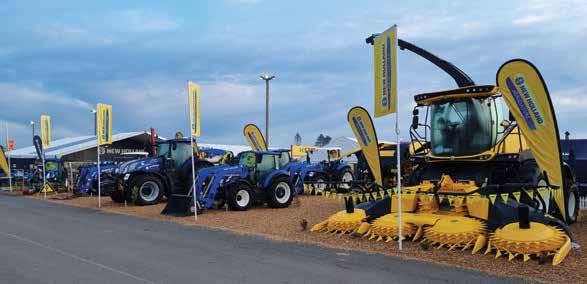
cab at just 66 decibels offers a premium experience.
The Pro 1200 display is also part of the new Puma offering. It further simplifies machine control and guidance operations.
On CNH’s New Holland site, the New Holland T4.120 F specialty tractor will be a talking point for horticulturalists and viticulturists. The T4.120 F won the Best Specialised title at the 2023 Tractor of the Year Awards.
Its new VisionView cab design offers next level comfort, ergonomics and visibility. It has a standard flat deck and incorporates features from the cabs of New Holland’s higher horsepower ranges.
The cab can be optioned with Category Four protection levels, with enhanced filtration against dust aerosols and vapour.
With its suspended front axle the T4.120 F ensures a smooth ride and has SuperSteer as
SAM spreaders can spread all synthetic fertilisers, including superphosphate, urea and lime at rates from 40kg/ha up to 2500 kg/ha and at spreading widths of up to 20m (for superphosphate). Longer throw vanes are also available.
Combo spreaders can handle 5-9 tonnes of processed fertiliser or organic material.
The spreading mechanism at the rear of all models is mostly stainless to extend its working life. Two hydraulic motors run the stainless steel discs. Adjustable tapered roller bearings keep the spreading discs tight. Three different levels of tech-

standard. With an effective steering angle of 76 degrees, it can turn in a radius down to 3.5m.
Later this year, both Case IH and New Holland will launch new FieldOps desktop and mobile portals. FieldOps combines real-time monitoring, remote display viewing and an easy-touse interface to make farm data management much easier.
nology are available in SAM’s spreader range. The most basic models feature manual drives.
The next level of sophistication is the SAM e-Spreader, which enables the operator to control the floor speed electronically from a screen in the tractor cab. With an e-Spreader you can easily adjust the rate on-the-go.
All e-Spreaders can be used with load cells because using GPS and weighing your product is the only way to get the level of accuracy that the e-Spreader can achieve.
At the top end of its range is SAM Topcon spreaders. With Topcon guidance and load cells
“Don’t miss the opportunity to talk to one of our precision specialists,” Aaron says.
The Case IH stand at National Fieldays is M30 and New Holland’s stand is D99. On the New Holland stand you can meet the New Holland Brand Ambassador Emma Poole. Emma was the 2023 NZ Young Farmer of the year. She will be on site Wednesday and Friday.
plus ISOBUS, they are precise and convenient. They can also integrate with other platforms such as Greenstar and Trimble.
The Topcon computer controls the floor speed hydraulically from a screen in the tractor cab. It can use the weight of the product to constantly check the spread rate on the move.
Now, for a small connection fee with Precision Farming, these spreaders can link directly with your fert suppliers.
With the Precision Farming link you can share data with whoever you wish. You can order, dispatch, report and apply a farm’s inputs using a simple interface.
Giltrap Ag will have a full range of Giltrap, Duncan and Buckton machines on display at its National Fieldays site. Highlights will include the new GT range of trailers, a Duncan ATD45 triple disc drill, and an Orchard-MD multi-directional spreader.
A good trailer is vital to every farming and contracting business. Giltrap Ag will use Fieldays to introduce its new GT trailer series, which have a number of unique features.
Giltrap Ag NZ sales manager Matt Moodie says there are three models in the GT Series –the 6T (6-tonne maximum load), 8T (8-tonne max load) and 10T (10-tonne max load).
Each GT trailer has a larger deck than the same models in the earlier Gitrap trailer range. (The same-sized decks as the old Buckton trailer range.)
“All GT models have a 54° tipping angle for efficient unloading. The 6T and 8T are on fourstage hydraulic rams while the GT 10 is a five-stage ram,” Matt says.
Giltrap Ag engineers have developed new self-locking mechanism for the sides of GT trailers.
“You just have to slam the side shut and it automatically catches and locks. It is a foolproof mechanism that is locked into place further by the trailer’s vibrations as you drive away.
“Another feature is a free-standing tailgate, so you can remove one or both sides of a GT trailer without the need to remove the tailgate.
“The tailgate has its own frame so it can also be removed. But leaving it in place while taking off a side is a great option if you want to quickly load a couple of pallets, for example. The headboard can also be removed to give you a completely flat deck,” Matt says.
An option with the new GT trailers is a side-hinging tailgate. It is a bolt-on extra, which does not have to be welded on. It can be factory fitted or retro-fitted to a GT trailer.
“Another optional extra that can be retrofitted to a GT trailer

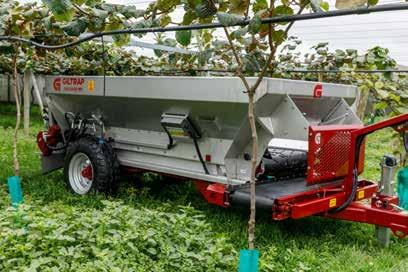
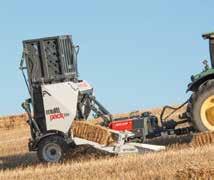



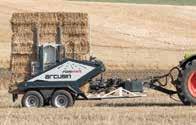
 is a hydraulic release tailgate. When you tip the trailer and it reaches a certain angle, it auto -
is a hydraulic release tailgate. When you tip the trailer and it reaches a certain angle, it auto -
Norwood will have some of its leading tillage and seeding implements at National Fieldays. They include a Väderstad TopDown cultivator and Spirit seed drill as well as a Sky Easy Drill.
TopDown cultivators can do shallow and deep cultivation in a single pass. They combine a tworow disc cultivator with a robust three-axle tine cultivator.
Models in the TopDown range have working widths from 3m to 7m and a 4m version will be on the Norwood stand.
The discs ride on individually suspended disc arms and are spaced at 12.5 cm. They cut and mix the top soil, then the tines loosen and mix soil and crop residues down to a depth of 40 cm.
In the TopDown’s final two working zones, a leveller and a packer reconsolidate the soil and leave an even surface.
TopDown cultivators reduce passes, preserve ground moisture, and lower establishment costs. The intensity of the discs and working depth of the tines can be adjusted from the cab.
When equipped with a BioDrill 360 airseeder, TopDown can be used to establish cover crops, catch crops or small-seeded crops, such as canola. Another option is to fit your TopDown with a fertiliser kit to apply fertiliser when cultivating.
At Agritechnica 2024 Väderstad won the tillage farm machine of the year for TopDown cultivators fitted with the E-Services control system. With E-Service, a TopDown can use
prescription maps to control machine settings automatically on-the-go.
Farmers can program the discs, tines, leveller and packer to match the soil types or other characteristics in different parts of each field using an ISOBUS monitor or iPad.
Also on the Norwood stand will be a 4m-wide Väderstad Spirit 400C pneumatic drill that sows both seed and fertiliser.
Spirit drills can prepare a seedbed, reconsolidate, place the seed and press in one pass. They deliver impressive precision at high working speeds.
They have a combination of heavy-duty front tools that prepare the seedbed, large packer wheels that consolidate the soil before seed placement, and accurate seed coulters with their own press wheels. Seed coulters are on 125-mm row spacings.
The combi version of the Spirit 400C meters out seed and fertiliser via two separate Fenix II metering systems. It can meter out fertiliser at up to 500 kg/ha at 15 kph.
Sky Easydrills are all about accuracy and flexibility. Accuracy comes from the seed coulters, which control seed depth using a front and rear wheel much like a precision planter.
Pressure is essential in dry conditions, but not when rain arrives. This is why the Easydrill can modulate its downforce pressure from 0 to 250 kg, simply by adding shims to a cylinder.
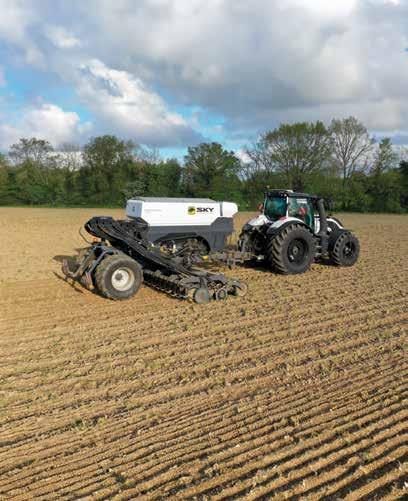
The Easydrill can drill in tilled soil, direct drill or drill into a live cover crop. Also, Easydrill can be configured to work with four hoppers.
The main 4000-litre bin is divided into two - one for seed and one for fertiliser (or both for seed). Two smaller 120-litre hoppers can broadcast seed, slug bait, insecticide or micro-nutrients.
Electrically-driven metering units give Easydrills accuracy and an ability to do section control and variable rate applications. With electric E-Drive, the different products in the four bins can be sown at four different rates.
Easydrill can handle seeds of any size – from peas and sunflower to cereals, grass, brassicas, canola or clover.
Its stainless steel distribution system can sow at rates from 1 to 450 kg/ha. The two main seed tanks can sow at different rates and at different depths.
It can, for example, sow barley deeper than undersown grass, or drill beans for winter feed at the same time it sows grass and clover at a shallower depth. Or fertiliser can be placed at a different depth to the seed.
Another option is to broadcast a cover crop seed at the same time the main crop is drilled along with fertiliser.
central greasing on the axles.
Giltrap Ag now produces two folding models of Duncan Enviro triple disc drills - the 4.5m ATD45 and the 6m ATD60. Both fold to a width of 3m for transport.
ATD drills can sow all types of crops – from small seeds at rates less than 1 kg/ha to peas at upwards of 350 kg/ha.
Seeding units are on 125-mm row spacings and the seeding depth is controlled by the press wheels. The folding wings lock
down and the individual disc units follow the contour of the ground.
Both the ATD60 and ATD45 have two hoppers, mounted front and rear, each with a capacity of 1500 litres. Both hoppers can be used for either seed or fertiliser.
Matt says ATD drills are designed to be user-friendly. All parts are accessible and easy to adjust. Altering the angle of the front discs and changing seeding depths are hydraulically controlled from the monitor.
“Calibration can be done either with our Duncan seed drill app on your smartphone or via an ISOBUS screen in the cab. With the app you can take a seed sample and enter the results on your phone while standing outside the cab.”
Giltrap’s 2.5m3 Orchard-MD spreader has a wide, low profile and can work comfortably under kiwifruit vines as well as in vineyards and orchards.
The new spreader has two
features that lift it above a traditional orchard spreader – a side-banding conveyor belt at the front of the bin and a reversible floor that can direct the contents either to the rear or front. When using the rear spinners to spread fertiliser, the floor moves to the back. To band bulk products like compost, mulch, or chicken manure, the floor moves to the front.
The Orchard-MD’s moving floor is 780 mm wide and it is riveted to the robust slat and chain unit that drives it.



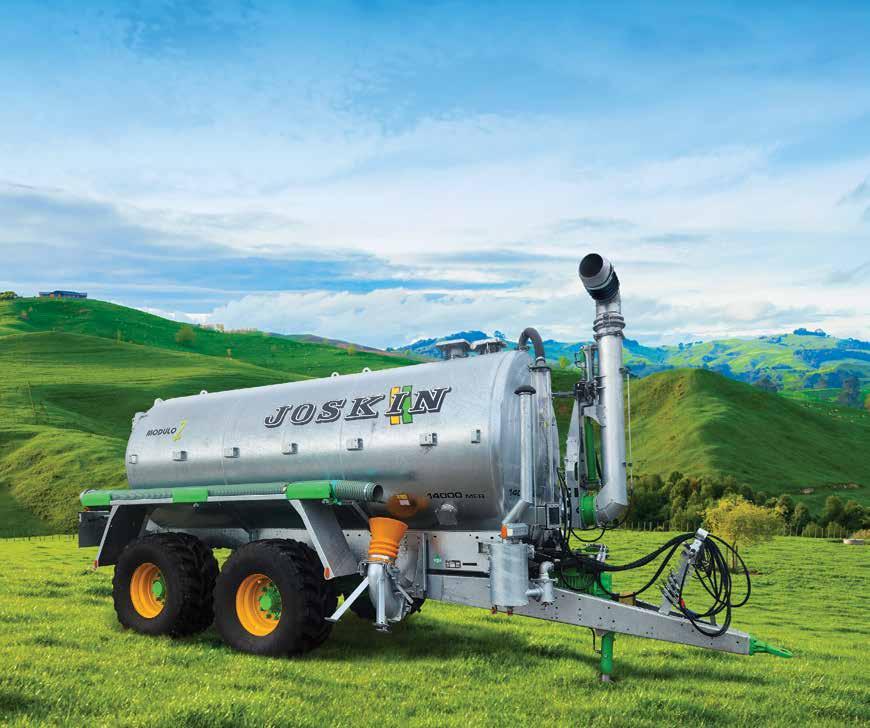

KAITAIA Kaitaia Tractors 09 408 0670
WHANGAREI Piako Tractors Northland 09 438 1319
SILVERDALE Brandt NZ 09 427 9137
PUKEKOHE Brandt NZ 09 237 0043
MORRINSVILLE Piako Tractors 07 889 7055
MATAMATA Matamata Tractors & Machinery (07) 888 6292
HAMILTON Brandt NZ 07 847 0425
CAMBRIDGE Brandt NZ 07 827 5184
ROTORUA Piako Tractors Ltd 07 345 8560
TAUPO Taupo Tractors & Machinery 07 378 4533
STRATFORD FieldTorque Taranaki 06 765 8643
HASTINGS Stevenson and Taylor 0800 4273 2273
WAIPUKURAU Stevenson and Taylor 06 858 6041
DANNEVIRKE Lancaster Tractors 06 374 7731

PALMERSTON NORTH Transag Centre 06 354 7164
MASTERTON Brandt NZ 06 377 3009
NELSON Drummond & Etheridge 03 543 8041
BLENHEIM Drummond & Etheridge 03 579 1111
KAIKOURA Drummond & Etheridge 03 319 7119
GREYMOUTH Drummond & Etheridge 03 768 5116
CHRISTCHURCH Drummond & Etheridge 03 349 4883
ASHBURTON Drummond & Etheridge 03 307 9911
TIMARU Drummond & Etheridge 03 687 4005
OAMARU Drummond & Etheridge 03 437 1111
MOSGIEL JJ Limited 03 489 8199
GORE JJ Limited 03 208 9370
INVERCARGILL JJ Limited 03 211 0013
Power Farming will display leading models of Merlo’s Turbo Farmer range at Fieldays. The first Turbo Farmers were launched in early 2000, which is the year Power Farming became the Merlo distributor.
Today there are still older model Merlo TF P28.7s, P30.7s, P33.7s and P36.7s at work around the country. More importantly many of those original Merlo owners (or their next generation) still run Merlos today.
The TF range starts with the compact TF27.6 and extends up to the heavy-duty TF65.9-170. Within the range are models with engines and boom lengths to cater to a wide range of operations.
On display at Fieldays will be the nimble TF35.7-115EE (with a capacity of 3500 kg to 7m) and TF42.7CS-136. These are versatile machines suited for all manner of loading operations.
With their low centre of gravity and low boom heights, both of these machines provide maximum operator comfort and visibility in tight surroundings. They can load a mixer wagon in a tight bunker and are ideal for warehouses or timber yards.
The higher specification TF42.7CS-136 has the latest Per-
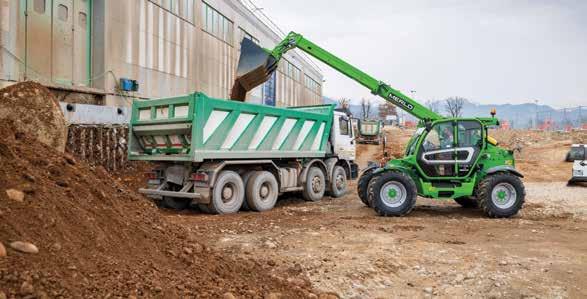
kins engine and cabin suspension that is unique to telehandlers.
The 3.6-litre Perkins 904J engine puts out maximum power of 100 kW and maximum torque of 539 Nm at 1500 rpm.
Perkins 904 Series engines are compact, powerful, and quiet. The 3.6 litre version delivers an excellent performance and torque, which improves fuel consumption. Because it is so quiet, it is a great choice when working around livestock.
The engine has Merlo Eco Power Drive (EPD), which gives three drive strategies. One is digger mode, where the driver sets the engine rpm and then uses the joystick to increase engine revs.
It then returns to idle for drive operations when the joystick is released.
Both the TF35.7 and TF42.7 have boom suspension Active. When unloading wrapped bales, the suspension automatically turns off under 3 kph and reactivates over 3 kph.
TF telehandlers have Merlo’s patented Suspended Cab (CS) system. When CS suspension is active, it significantly reduces vibrations and stresses inside the cab.
All Merlo TF telehandlers have a hydrostatic transmission. The larger TF65.9Cs have a CVT transmission opposed to the standard two-speed on other models. All
have permanent four wheel drive, powerful hydraulics and the ASCS safety system, which warns the operator when a load is moving into a dangerous position.
Merlo cabs are comfortable and practical. TF cabs are 1m wide and very roomy. For visibility, there are 4.3m2 of windows while vibration-damping silent-blocks reduce noise and vibrations.
All machines come with Quick Tac, so most implements can be attached and detached from the driver seat.
Power Farming has a number of demo TF35.7-115s with non-AdBlue engines available to try through its nationwide dealer network.
Visit the BA Pumps & Sprayers stand at National Fieldays to see its all-new, cutting-edge LM Link-
age Sprayer with fully hydraulic M-fold boom.
With an LM sprayer, farmers
can achieve safe, highly efficient operation in almost any terrain. They can be specified with a 900or 1150-litre tank.
The unique T-shaped tank

ensures weight is distributed forward for optimal performance.
Chemical loading is easy and efficient thanks to the built-in waist-height induction hopper. For operator safety there is a built-in flush tank and hand wash tank. The pump and lines are easy to clean.
LM sprayers have Bertolini 75-litre Poly Pumps, which can handle liquid fertiliser. In-cab electric control allows the operator to make pressure adjustment on-the-move.
Auto rate control, GPS, and ISOBUS-ready upgrades are available for advanced operations, which means the LM Series can fit into a precision agriculture operation.
The M boom offers full wing lift and hydraulic fold functionality from just two hydraulic remotes. M booms are 10m or 12m wide
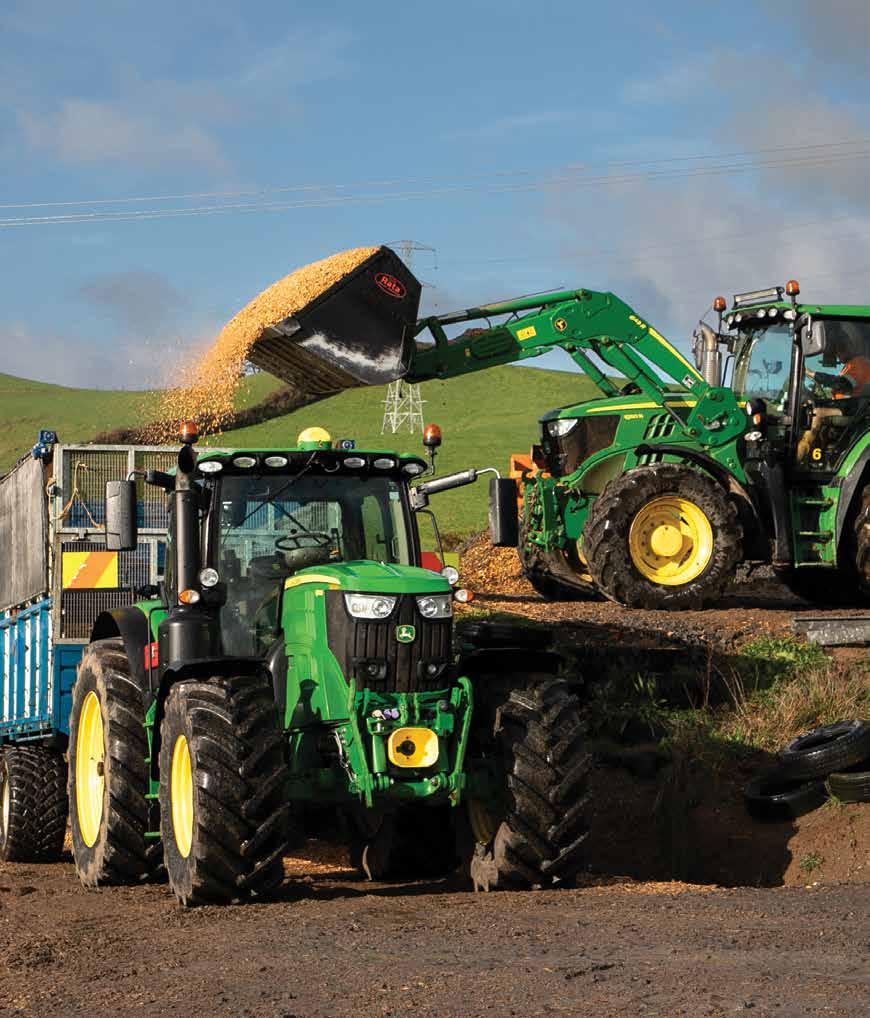
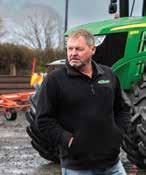


Landpower is will have an exciting new layout at this year’s National Fieldays where it will showcase machines from Claas, JCB, and Amazone.
The range of Claas tractors on site will include compact and manoeuvrable Arion 410 and 430, the mid-sized Arion 620C and big Claas Axion 960 with Terra Trac.
Arion tractors combine power and ease-of-use. The Arion 620C is a fuel-efficient tractor that has a long (2.82m) wheelbase and tight turning radius.
It has the familiar Claas comfort concept with four-point cab suspension. An option is the factory-fitted Flex Pilot joystick.
Axion 960 Terra Trac is the first half-track tractor with full suspension. Terra Trac provides low ground pressure to preserve your soil and its oscillating motion keeps the track parallel to the ground whatever the working conditions or weight distribution.
The Axion’s six-cylinder 8.7-litre FPT engine delivers full power at all engine speeds for fuel efficiency. It has up to eight spool valves and 220 litres/min hydraulic capacity.

Claas Jaguar forage harvesters are always a big drawcard and this year Landpower will have a Jaguar 970 on display. This model boasts a new MAN S6 engine with 790 hp and continuously variable front attachment drive. Its efficient performance comes from hydraulic pre-compression, enhanced crop flow, reinforced feeder housing, and Auto Fill automatic rear and side loading.
Optional features on the Jaguar 970 include fuel-saving operator assistance systems such as CEMOS Auto Performance and CEMOS Auto Crop Protection. These systems maintain a target engine speed and adjust the
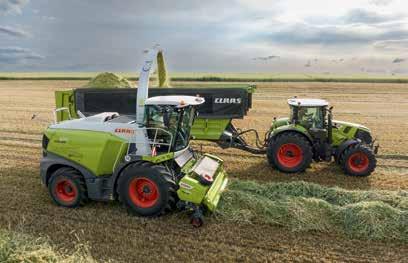
and can cover up to 18m with a factory-fitted fence line kit.
The boom open and closes hydraulically. M folding and full wing lift enable farmers to get the productivity benefits of a 12m boom, even when working in rolling country. Built-in break-
aways enhance safety and prevent damage to the equipment by clearing obstacles during spraying.
Designed for New Zealand conditions, LM linkage sprayer can save farmers up to 50 percent on spraying times. LM sprayers
engine output and ground speed according to the volume of crop.
Other Claas grass harvesting tools on display will be Disco front, rear, trailed and combination mowers; Volto tedders; and Liner rakes.
JCB agricultural machines on display will be the Loadall 542-70 telehandler and the Fastrac iCon 4220 tractor.
Loadall 542-70s have a JCB DieselMAX engine that delivers maximum engine power of 129kW and travel speeds of 50 kph. Its fuel efficiency is 5.97 litres/hr based on over 2.5 million machine hours in farms around the world.
Fastrac iCon 4220 gives today’s farmers and contractors easy access to precision ag technology, a configurable control system and new Smart Transmission Control (STC). The large CommandPlus cab provides a 50 percent reduction in cab noise. Its unique suspension enables the Fastrac 4000 to operate at road speeds up to 60 kph, and to accommodate this it has unique safety features.
With the Fastrac’s touchscreen controller, the operator can select different transmission and engine control strategies.
prioritise safety, efficiency, and durability.
As well as the LM Series, the stand will feature BA’s other linkage sprayers including the 1000 and 1300 litre LS Series plus the 1600 and 1900 litre LK Series. There will also be a selection of
The Amazone sprayer range includes the UF 1602, which has a unique polyurethane tank that has a favourable centre of gravity, and smooth walls that make for effective interior and exterior cleaning.
On sale during Fieldays is the Amazone ZA-M 1502 twin-disc spreader with a 3000-litre hopper and spreading widths of up to 36m. The ZA-M 1502 has a slow-turning, high-capacity agitation system. Its reduced disc speeds ensure an even flow and will not damage fertiliser granules.
The Amazone ZA-TS Ultra twindisc spreader has a hopper volume of 1700-4200 litres, with working widths of 18m to 54m.
The Amazone KG 3001 rotary cultivator in combination with the GreenDrill seeder offers all the benefits of the rotary harrow with a stronger gear trough, thicker rotor shafts and stronger tines.
Amazone rotary cultivators have on-grip tines, which pull themselves into the soil and maintain the target working depth. Even in hard going soil, the rotary cultivator loosens the ground and simultaneously intensively mixes in the straw.
trailed and deck mount sprayers for those smaller spray jobs.
Fieldays is a great way to connect with farmers and contractors and BA Pumps & Sprayers is excited to have the LM sprayer on display so farmers can have a close look.

‘Accuracy’, ‘simplicity’, ‘reliability’ and ‘cost-effectiveness’ are just some of the things that Allen Custom Drills hears from farmers and contractors when discussing what they need from their agricultural machinery.
In agricultural businesses, and especially ag contracting businesses, it is common to have people from different countries, some speaking different languages, operating farm machinery. This is an incentive for manufacturing companies in the industry to ensure their equipment is simple and effective.
Allen Custom Drills takes pride in the fact that their drills are easy to use. They don’t overcomplicate things, which is one reason their air seeder range is popular across NZ and Australia. Using an accurate and proven system to get seed into the ground is the only way to achieve
even germination and a successful crop. Allen Custom Drills believes that their air seeder drills can play a pivotal role in this.
Allen drills use the well-known Accord metering and distribution system combined with their own 7115 controller with a 7-inch touchscreen. There is also an option of ISOBUS-ready.
This technology gives the operator control of sowing rates, area covered, and audible and visual alarms. It can be configured to apply seed or seed and fertiliser, and there is the option to run small seed and slug bait applicators.
Allen Custom Drills’ 7115 drill controller has GPS mapping for proof of placement. The system is simple to calibrate and provides a high standard of accuracy from less than 1 kg/ha to more than 300 kg/ha.
Animal nutrition is critical for production and animal health. Jaylor mixer wagons provide a very efficient way to introduce long fibre and reduce the ability of cows to sort through the mix.
It starts with Jaylor’s patented square cut auger. It has a lower slide plate that loads the auger to ensure every part of the ration is propelled vertically.
The drive line runs with 1000 rpm PTO input. This produces high input speed and low torque, which reduces stress on the tractor’s PTO line. Most other machines run at 540 rpm, so they work at low-speed, hightorque and transmit higher loads
on the tractor driveline.
Jaylor also has a 1.3:1 ratio reduction box that can handle
Providing agricultural machinery that is cost effective in today’s world is very important. With increases in the cost of living and fuel, supplying a cost-effective air seeder drill is a priority for Allen Custom Drills.
An Allen Custom Drill is an investment well worth considering if you want an accurate, simple, reliable and cost-effective machine operating in your fleet.
The company have five base models in their range:
• E-D Series / Ergonomic Drill. An entry level triple disc drill that is suitable for both farmers and contractors.
• C-D Series / Contour Drill. The top pick triple disc drill for contractors and large-scale operations.
• T-D Series / Tyne Drill. An entry level tyne direct drill.
• H-D Series / Heavy Duty Direct Drill. A heavy duty direct drill that is ideal for flat ground.
• P-D Series / Packer Drill. A
heavy loads.
The augers’ rotation speed is 38 rpm, about 40 percent faster than most other mixers. The nine tungsten-coated blades fitted to
min-till, arable drilling.
All series in the Allen range can be customised with a range of optional extras to meet the needs of individual businesses.
The company’s parts department has hard-wearing parts available on the shelf that they can delivery quickly, either direct to local customers or by an overnight courier.
For more information on Allen Custom Drills, give the team a call (03 308 4094), or visit their website (allencustomdrills. co.nz).
If you live in the Ashburton area or are visiting, Allen Custom Drills welcomes you to stop in to say ‘gidday’ and have a cuppa at their head office at 13 Range St, Ashburton. You can meet the team and tour the workshop to see how they build their drills from the ground up.
Allen Custom Drills will be on display at Mystery Creek Fieldays on site F43.
each auger produce more slices per revolution to speed up mixing time and get the feed out to the trough quickly.
An option is additional special-
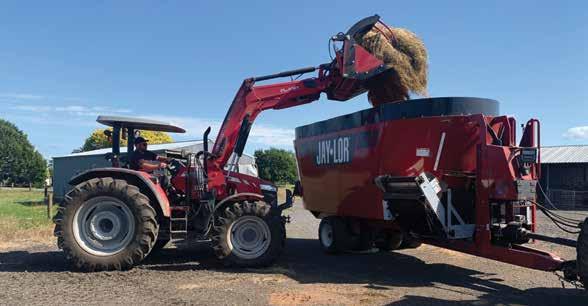
FarmShop is making a very special offer during this Fieldays – they will be giving away a CanAm Defender valued at $31,500*.
To be in the draw with a (very good) chance, all you need to do is order a Samasz GigaCut grouper mower on indent this season.
The odds are stacked in your favour because entries are limited to those investing in this big-ticket item before the end of June.
Visit the FarmShop stand at Mystery Creek (site H3) to learn why farmers and contractors are choosing a Samasz GigaCut grouper mower.
The Farmshop crew can share the finer details on finance, including 20 percent off the retail price and 0 percent finance across three years.
European mower manufacturer Samasz exports its machines to 70 countries and has produced more than 160,000 mowers since it began in 1984.
It has identified New Zealand as one of the main countries where it can achieve growth, which is excellent news for contractors looking for a sharp price on a mower.
FarmShop has qualified technicians who have trained at the Samasz factory in Poland. A nationwide roll-out of service agents is underway (supported by a 0800 Samasz helpline), and when customers commit to an annual servicing programme, their warranty increases from two to three years.
Many Kiwi farmers and con-
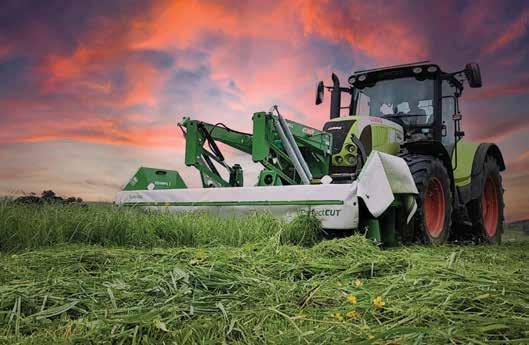
tractors are aware of how well Samasz mowers perform. Those who own Samasz equipment appreciate how the company has customised its machines to suit our harsh conditions.
Samasz regional export director Lukasz Lapinski says the company’s commitment to the NZ market is strong.
“New Zealand is important when it comes to modifications of our machines. Based on feedback from New Zealand, we have introduced new spring holder pins and modified the shape and mounting of conditioners’ tines, for example.”
Designed for large farms and contractors, the Samasz GigaCut grouper mower has a robust frame, conditioners, stone-proof
knife holders, and replaceable stone protectors. Thicker 25-mm spur gears with a bevelled edge means less maintenance costs because there are no sharp edges to catch or break.
A GigaCut grouper can increase productivity and eliminate a tedder and rake. They are available with tine or roller conditioners, and they feature easy adjustment to the groupers’ belt speed.
Samasz mowers boast a blade tip speed of 3200 rpm. This is an important factor in mower performance because it provides a cleaner, faster cut.
The GigaCut controller on hydro-pneumatic models is very simple to use. Everything can be controlled from the monitor.
PerfectCut cutterbars provide excellent contour following. It is a wider cutterbar than those on
most mowers and is excellent for straddling the pivot irrigation ruts. They also have a quick knife replacement system.
A hydraulic safety breakaway device protects the mower against hitting obstacles. If hit, the cutter bar folds back and rises about 50 cm, then automatically returns to its working position once the obstacle is passed.
For advice on a Samasz mower, get in touch with the team at FarmShop. They will make your investment seamless, and you could be the lucky owner of a brand new Can-Am Defender.
*To enter the draw to win a Can-Am Defender HD10 XU 4x4, order a Samasz 9.4m grouper mower or an 8.6m grouper mower on indent this season. The prize will be drawn on June 30, 2024.
ised knives to process different forages or root crops.
When dealing with lucerne, for example, two Alexander plates and blades can be added to each auger. These sit at a 45 degree angle and undercut the long forage to shred the feed and allow it to enter the lower auger where the majority of processing occurs.
When there is access to fresh fodder, such as potatoes, onions, fodder beet and kiwifruit, you can add another two vertical blades to the slide plate.
These deal with heavy products that roll around in the bottom of the mixer. Once they have been sliced and diced, they quickly become homogenised in the mix, which avoids stock choking on large chunks of under-processed root crops.
Jaylor 5750 wagons weigh only 5900 kg empty. They can feed 550-600 cows and are remarkably nimble thanks to their oscillating inline axle. It trails like a single-axle trailer without dragging wheels when turning. This eliminates unnecessary
rear suspension and an integrated steering system, which increase weight and maintenance costs.
Jaylor also offers a single-auger 5425 model. It can carry nearly 15m3 with extensions, and is popular with herds of 300-350 cows. It is a simple machine with minimal moving and wearing parts and it only requires 80-90 hp to drive efficiently.
A Jaylor 5425 can process a load in less than 30 minutes from loading to unloading. The auger takes 540 PTO rpm and
transfers this to a massive planetary drive gearbox to create an auger speed of 41 rpm.
For unloading it has a 6-ft cross conveyer and 41 inch discharge elevator. The elevator is raised with two hydraulic rams and the unloading height can be adjusted using ram stop collars.
Power Farming has provided service and support for Jaylor customers for nearly 20 years. Jaylor reliability is second to none but they are backed up by Power Farming’s nationwide dealer network.



























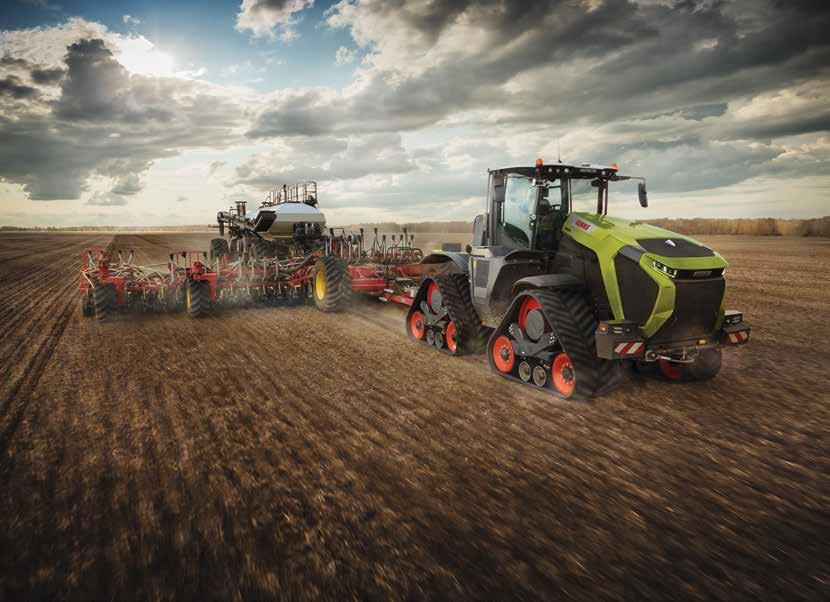
MANUFACTURERS CONSTANTLY RE-ENGINEER THEIR EXISTING TRACTORS AND ADD NEW MODELS AND NEW RANGES. ADVANCED FUELEFFICIENT ENGINES, MORE EFFICIENT TRANSMISSIONS, FACTORY-FITTED PRECISION FARMING TECHNOLOGY, AND LARGE COMFORTABLE CABS ARE AVAILABLE ON MORE AND MORE MODELS. IN THIS FEATURE THE LEADING COMPANIES TELL US ABOUT THEIR NEW HIGH HORSEPOWER TRACTORS.
Claas has added some serious new models to the Xerion range, built to deliver towing efficiency, comfort, driver assistance and profitability.
Claas Harvest Centre’s product business manager Kevin Walker says Xerion 12 Series models are the most powerful four-wheel tractors with CVT on the market, and they set new standards in this segment for efficiency and comfort.
The all-new Xerion 12 Series is positioned above the Xerion 4200, Xerion 4500 and Xerion 5000 models and is the largest tractors Claas produces.
The new 12.650 and 12.590 models are the flagships in the Xerion 12 range. Claas engineers designed them with four major features in mind:
• Better profitability due to low fuel consumption, low maintenance and low wear.
• Stronger pulling power thanks to high torque, large contact areas, 50:50 weight distribution and
powerful hydraulic power.
• Greater comfort thanks to the large, four-point suspended cab, rubber Terra Trac track units and comfortable steering.
• More assistance via CEBIS, Cmotion, CEMOS and GPS Pilot CEMIS 1200 digital automation.
Xerion 12 models are powered by the same 15.6-litre six-cylinder Mercedes-Benz OM473 engine found in Claas combines and forage harvesters. It has a
maximum power output of 653 hp.
“This is one of the most powerful four-wheel-drive tracked tractors on the market and the only one equipped with a Cmatic continuously variable transmission as standard,” Kevin says.
“With their balanced 50:50 weight distribution, Xerion 12 Series tractors are great for heavy-duty pulling in all speed ranges, whether in front of a cultivator, plough, airseeder or trailer. Despite its power and size, they
 CLAAS
CLAAS
are nimble thanks to their precise twin-axle steering.”
The low-engine speed concept delivers maximum torque up to 3100 Nm at 1300 rpm. Combined with hydraulic flow of 537 litres/ min, it can efficiently operate big air seeders and other implements with high oil demand at a low engine speed.
An intelligent drive train helps ensure fuel-efficient operation. Independent testing has shown fuel consumption is 8-10 percent less than other tractors in this category.
Since its launch, the Xerion 12 has been recognised with a number of international awards. It was named both Tractor of the Year (2024) and Farm Machine 2024 (large tractor category) at 2024 at Agritechnica.
The Xerion 12 Series Terra Trac model has new triangular crawler units and 914-mm or 762-mm tracks. Wheeled models can be fitted with 800/70 R42 duals or 900/60 R42 single tyres.
The cab offers space, comfort, and all-round visibility.
Precision farming technology includes automated steering, section control, variable rate, and automatic documentation.
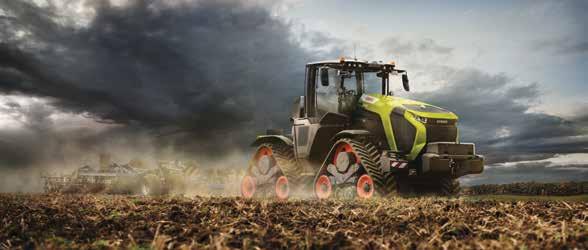
With CEMOS, it has automatic optimisation of the tractor’s performance.
The Claas Axion 900 Terra Trac comes in two model variants –the 445 hp Axion 960 and the 360 hp Axion 930.
Unveiled as concepts at Agritechnica two years ago, the new Terra Trac models incorporate the proven tracked assemblies used in the company’s Lexion combine harvesters and Jaguar forage harvesters.
Kevin says the ‘half-track’ tractor concept combines the benefits of tracked and wheeled machines.
“In short, Terra Trac improves traction and reduces soil compaction, whilst still retaining


the driving characteristics of a wheeled tractor,” Kevin says.
“Combined with the front axle and unique four-point cab suspension already found on the Axion, this creates what is arguably the most comfortable broadacre tractor on the market.”
The Axion 900 Terra Trac is currently available with 635 mm, 735 mm or 890 mm track widths.
With a total footprint of 3.87 m2, the 890 mm track is 35 percent larger than a 900/60 R42 tyre. This translates into 15 percent more tractive power and a 50 percent reduction in ground pressure.
This has a positive impact on your soil. When there significantly less pressure from the tractor, there is less surface compaction. This means you spend far less



time and energy on restructuring work.
Even more striking is the soil-protecting effect of the Axion 900 Terra Trac in deeper soil horizons (below 40 cm) which were not tilled. Here test have recorded 50 percent less soil pressure compared to a standard tractor, and this better soil protection ensures high soil fertility in the long term.
Kevin says it is also worth noting that all three widths keep the external width of the tractor to less than 3m.
The rear axle of the Axion has been substantially modified to accommodate the Terra Trac units, which in turn, have been modified to improve traction.
“The size of the drive wheel has been increased to meet the specific power transfer needs of
High quality innovative and reliable machinery - robust and easy to maintain.


To develop the tracked 900 Vario MT, Fendt has adapted the revolutionary Fendt VarioDrive drivetrain from Fendt 1000 Vario wheeled tractors. The result is an efficient continuously variable drive.
It gives operators of the Fendt 900 Vario MT the ability to run a continuously-variable power-split in a speed range from 12.5 metres/hour to 25 kph –without the need to manually change between speed ranges. Therefore you are always working in the optimal speed range with minimum slippage.
The VarioDrive CVT, paired with Fendt iD low-speed concept and the Mobil-trac system, provides an operating experience like no other.
The three models in the range are the 938 Vario MT (380 hp/279 kW), 940 Vario MT (405 hp/298 kW) and 943 Vario MT (431 hp/279 kW).
Under the hood of the Fendt 900 Vario MT is a powerful seven-cylinder AGCO Power engine. The 9.9-litre engine generates up to 431 hp at a rated speed of just 1700 rpm.
Two in-line turbochargers with fixed geometry generate power constantly. Max torque is reached at just 1450 rpm thanks to Fendt iD. The engine’s speed range is 1000-1700 rpm and idle speed is just 800 rpm.
Efficient cooling comes from Fendt’s fan and Concentric Air System (CAS). A high-performance fan sits in front of the cooler unit. It pulls in dense cool air, accelerates it and pushes it through the cooler. The CAS has its own hydrostatic drive, so it always delivers each component the cooling it needs, independent of the engine speed.
At the heart of VarioDrive drivetrain are large, powerful hydrostatic devices. The hydro-motors can swivel independently of each other so that the drivetrain achieves maximum efficiency in every situation.
With Fendt VarioDrive, you always drive automatically within the most efficient range. The Fendt 900 Vario MT achieves a transport speed of 40 kph at just 1550 rpm.
Fendt’s Tractor Management System (TMS) along with the automatic maximum load con-

trol ensures that the 900 Vario MT delivers the most efficient results, without the driver having to make elaborate settings.
You can drive the Fendt 900 Vario MT using either the joystick or the accelerator pedal. The TMS maintains an optimal ratio of the rpm and driving speed.
The Fendt 900 Vario MT’s hydraulic system also delivers maximum performance. Select either 220 or 440 litres/min capacity. The bigger version has two separate circuits with 220 litres/min capacity each. Both versions deliver maximum performance at 1700 rpm.
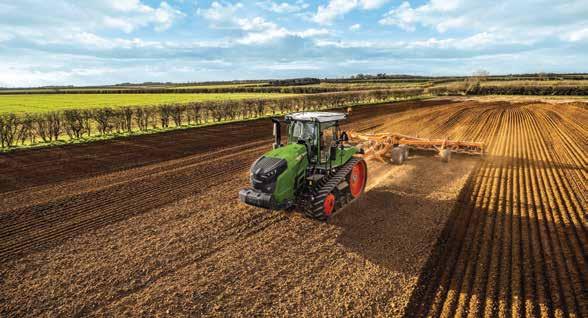
a tractor and to handle the high levels of torque,” Kevin says. “Likewise, the transmission inside the crawler tracks has been strengthened to transmit higher torques. Each assembly can pivot up to 23 degrees longitudinally.”
Combined with its individually-suspended rollers, this allows each unit to maintain optimum ground contact in all soil conditions, terrain and operating speed.
The continuously variable
Cmatic transmission allows the tractors to be precisely operated at low speeds, or at the other end of the scale, up to 40 kph on the road.
An intelligent drive control system means the tracks are capa-
Hydraulic oil supply is separate from transmission oil to avoid mixing oil. The steering system has its own separate system. This means that there is always enough oil for the implement.
One of the pumps is directly coupled to the left valve block and supplies to valves 1-3 and the Power Beyond connection. The second supplies to the right valve block with valves 4-6 and the power lift.
You can attach three-point implements onto the Fendt 900 Vario MT just as comfortably as onto a wheeled tractor. The rear power lift has a 8618 km lift capacity.
Shock load stabilizing actively dampens when driving on the road, which contributes to ride comfort and safety. Gearbox pressure sensors are used to control the rear power lift. You can control the implement perfectly via the comfortable power lift module in the armrest.
To transmit the AGCO Power engine’s power to the PTO-operated attachments efficiently, the PTO is almost directly connected to the crankshaft. Only one gear level lies between them, which makes it very effective.
Two speeds are at your disposal - 1000 at 1650 rpm or the 1000E at 1255 rpm. The speed is pre-selected at the touch of a button in the cab. The PTO is similarly activated.
ble of performing tight turning manoeuvres.
The driver can activate three levels of steering assistance or adjust the tractor’s ground clearance by up to 12 cm via the CEBIS terminal.
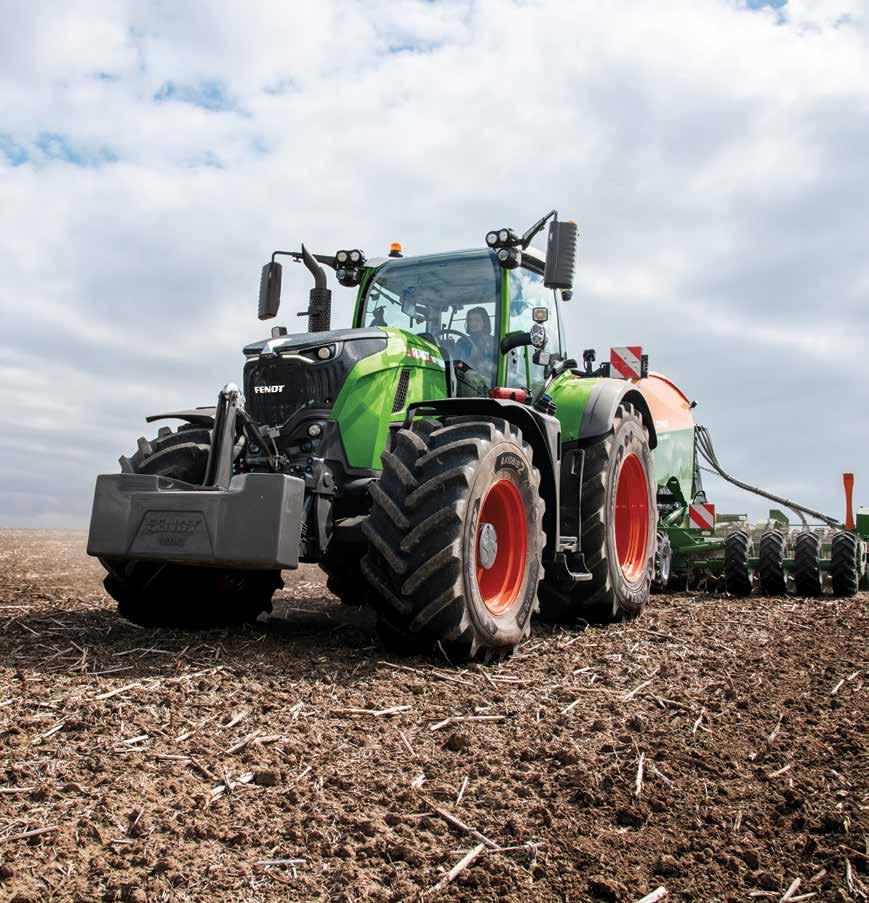

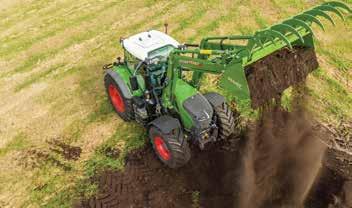
The all-new Fendt 700 G7 is perfect for those with big plans. It features the latest innovations and technologies, and delivers unrivalled efficiency and performance. The FendtONE workstation, combined with intelligent vario drive and Fendt iD low-speed concept set this tractor apart from every other machine in its category.
Lead from the front with the Fendt 700 G7 Series.

Visit fendt.com/au or contact your local Fendt dealer to find out more.
Leaders drive Fendt.
NZ farmers and contractors now have the option of New Holland’s T7 PLMi Long Wheelbase range tractors to choose from. There are now four distinct models available to order.
The revised T7 PLMi Long Wheelbase range now includes a new flagship model that delivers enhanced power and an exceptional power-to-weight ratio while maintaining the dimensions and manoeuvrability of the other models.
The new T7.300 Long Wheelbase with PLM Intelligence (T7 LWB PLMi) offers more power, more technology, and more comfort to maximise the tractor’s efficiency, productivity, and uptime.
New Holland Australia-New Zealand product manager Ben Mitchell says the company has added the T7.300 in response to feedback from customers who want a tractor with more power and more weight without a bigger frame, so that it maintains good manoeuvrability.
“We took up their challenge and developed the new T7.300. It delivers greater engine power and it has larger tyres for increased traction, but it retains the same overall dimensions of the existing T7 models.
“It is designed for farmers and contractors who accrue high operating hours each season and want an efficient and reliable all-rounder with the latest cutting edge technology.
“Features of the latest model include a FPT six-cylinder engine that delivers 280 hp maximum power for draft work and 300 hp for PTO and haulage tasks.
“The T7.300 also gives operators the ability to spend more time in the field, thanks to its 18 percent increase in fuel capacity.”
Also, the T7.300 boasts an upgraded version of New Holland’s popular Auto Command transmission. The Auto Command driveline delivers outstanding tractive effort, which further adds to the tractor’s exceptional efficiency.
Integrated controls for large square balers optimises interaction between the tractor and baler. It anticipates the forces exerted on the tractor by the baler, which results in a 15 percent reduction in cab movement, a more consistent PTO speed, and a 12 percent reduction in fuel consumption through the baling cycle.
Ben says the new addition to the T7 range has a number of features that give new levels of comfort. These include the Horizon Ultra cab, with a noise level of just 66dBA.
“Comfort Ride suspension coupled with the active electro-hydraulic system decouples the movement of the cab from the chassis and a ‘skyhook’ control logic delivers a supremely smooth ride.”
Easy-to-use technology makes
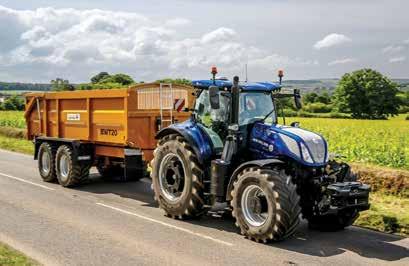
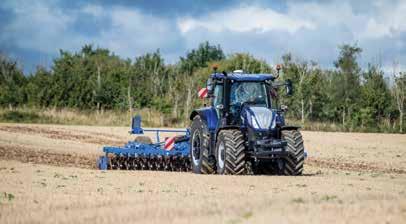
the operator’s job easier. This includes the IntelliView 12 monitor, and the SideWinder Ultra fully adjustable armrest for ergonomic and intuitive operation.
The T7.300 delivers all the benefits of New Holland’s advanced PLM Intelligence, allowing field applications such as IntelliSteer autosteering with 1.5 cm accuracy and IntelliTurn headland sequence management.
It is the first New Holland tractor to be fully ISOBUS Tractor Implement Management (TIM) certified. It gives two-way communication between the tractor and implement and gives the implement a degree of control over the tractor.
The new T7.300 along with the other models in the expanded T7 LWB PLMi range are now available to order.


The all-new 6 Series from Deutz-Fahr will be taking centre stage at the Power Farming’s site at National Fieldays, where it will have its official New Zealand release.
To broaden its six cylinder product offering, Deutz-Fahr has added a number of features and specifications to the new 6 Series from its popular large frame 7 and 8 Series siblings.
Whilst the 6 Series range has featured in the German manufacturer’s line up for a number of years now, it is new receiving its biggest range of updates since its release to market back in 2013.
The 6 Series 6170, 6190 and range topping 6230 are available for the New Zealand market. All three models are available with the proven 5 range, 6 stage semi powershift transmission from ZF, whilst the two larger models are also available with SDF’s new in-house designed and built compound TTV transmission. The TTV transmission also features in the larger 7 and 8 Series machines.
Although the latest 6 Series models are still powered by a DeutzAg 6.1 litre six-cylinder engine, the power plant has received several updates to achieve the latest off highway European emission standards.
For the Australia-New Zealand market there is the option of an engine that has been homologated as a Tier 3a variant. Tier 3 engines do not require the use of AdBlue or a DPF after treatment system.
The torque curve produced by these new engines has a long, flat peak that allows the tractors to run at lower rpm whilst still producing ample power for transport applications.
Deutz-Fahr has also overhauled the cooling package for the 6 Series to better cope with the excess heat produced by an engine that is designed to run hotter and cleaner to meet emission standards.
It is easy to maintain the large cooling package thanks to a large cantilever style radiator stack that swings out for easy cleaning and maintenance. To make it even simpler, there is the option of an air outlet that runs off the tractor’s pneumatic system that can blow out dust and debris whilst in the field. An electro-viscous fan can also be used to optimise airflow and cooling capacity of the powertrain.
All models in the 6 Series have a fuel tank with a capacity of 405 litres to ensure you can get in a full day’s work without the need to refuel.
The two transmission options allow Deutz-Fahr to cater to the requirements of a broader range of customers. The semi-powershift offers such features as an electronically controlled, five range, six stage powershift. It has good overlap between ranges and a high number of speeds in the key working range (5-17 kph).
For the operator, the result is a more comfortable working experience. There is no need to work between ranges because each range has six steps of uninterrupted power to cater to any task.
This is particularly important when working on hill country or under a heavy load where a range change is not optimal.
Auto-shift modes either within ranges or through the entire transmission range mean transport operations can be performed with minimal operator input.
The other option is the new compound TTV transmission, which was first showcased in the Deutz-Fahr 8280 TTV. It consists of two high pressure hydrostatic units and a stepped planetary gearbox that provides seamless and consistent power delivery.
With the TTV transmission, the two drive ratios shift automatically without any operator input and without the operator noticing a shift. The design of the transmission ensures minimum power loss through the driveline and allows power to be delivered as consistently and efficiently as possible.
Whilst the cabin frame remains unchanged, the cabin interior has been upgraded to align with Deutz-Fahr’s latest generation product offering.
An improved air-conditioning system delivers better air circulation. New fans and intake vanes allow the system to work more efficiently and effectively. Additional cabin ventilation has been added to provide higher volumes of airflow for enhanced operator comfort.
The iMonitor has also received an update with the new H5 operating software. The software brings a number of enhancements to make the control terminal more user-friendly.
Deutz-Fahr improvement to ISOBUS integration and logging of job data are examples of the many enhancements made to the new operating system to allow professional operators to get more efficiency from their machine.

Case IH has introduced AFS Connect precision farming system to its high horsepower tractor ranges over the past few years, which has changed the game for farmers and contractors. Now this advanced technology has been rolled out across the popular Puma range.
AFS Connect Puma has just been launched into the Australian and New Zealand market. These models have a range of new design features and performance updates, including the connectivity capabilities of its larger Steiger, Magnum and Optum stablemates.
Case IH Australia-New Zealand Product Manager for Puma tractors Lawrence Polga says the Puma has always punched well above its weight when it comes to performance and versatility in the midrange of tractor models.
“Now with the addition of the AFS Connect platform an already strong tractor is now even better,
offering customers everything they could once only find in our larger tractors,” he says.
AFS Connect Puma models will also come with a continuously variable transmission (CVT) as standard. Case IH is also introducing a new 260 hp model whereas the top model in the range previously stopped at 240 hp.
Other improved features include bigger rear tyres and a stronger front axle. The higher horsepower models in the range also boast a bigger back axle as well.
The most exciting upgrade is the Puma’s technology capabilities, however. With the Case IH AFS Connect telematics package they deliver instant two-way data transfer between the tractor and the AFS Connect online management portal. This gives owners and farm managers complete control over their farm, their fleet and/or their data.
When AFS Connect is active,

data on the tractor and implement’s operation and performance are immediately, securely and continuously sent to the online portal so the owner or manager can monitor them.
“This means they can make management decisions more precisely and with greater speed, because they have access to accurate data, both current and historical. You can also monitor real-time information such as the location of the tractor, its fuel levels and other key management and performance data,” Lawrence says.
Owners could also choose to allow their Case IH dealer to remotely monitor their tractor’s AFS Pro 1200 terminal screen via AFS Connect. This enables the dealer or their servicing technicians to receive notification should there be early warning signs of an issue with the tractor. With this access they can also provide remote servicing and operating advice based on data from the tractor.
“Having that connectivity between the farmer or contractor in the paddock and the dealer allows us to minimise their downtime. If they choose, when we are connected to their machine we can also provide product improvements like software updates,” Lawrence says.
Case IH is introducing a new hydraulic cab suspension system for better comfort on Puma AFS Connect models. It is also offering the option of Advanced Vehicle Suspension (AVS), a fully-integrated suspension system that combines front-axle suspension, cab suspension and rear hitch to provide the operator with a high-
er level of driving comfort.
Other notable features are a new fuel tank with increased capacity of 457 litres, ergonomic steps into the cab, and more storage, including a storage box on top and a storage area in front of the steps.
Puma AFS Connect models feature a new, larger cab with a premium leather seat that has active suspension and full cooling and heating,
The operating experience is more efficient with a new drive pedal that provides more precision and control when inching at slow-speeds, when making headland turns during field work, and when travelling at highspeed on the road. A large cool box and multiple USB sockets will also be welcomed by operators.
Remaining in the cab, there’s a Multi-controller armrest and its Multi-Function lever, larger AFS Pro 1200 touchscreen monitor with greater functionality, and A-pillar tablet instrumentation for engine/transmission information read-outs. Via the new monitor at the armrest’s front, key controls on the Multi-controller and armrest can be customised to suit operator preference and the job at hand, including the remote valve paddle switches.
“The inclusion of AFS Connect takes the Puma’s capabilities to a new level, giving users a versatile tractor with continuously-variable transmission that offers even more in terms of comfort, capability and connectivity,” Lawrence said.
The AFS Connect Puma is available to order now and for more information contact your local Case IH dealer.

66 dBA QUIETEST PUMA
+8% ENLARGED CAB +18% FOOTPRINT
MORE POWER
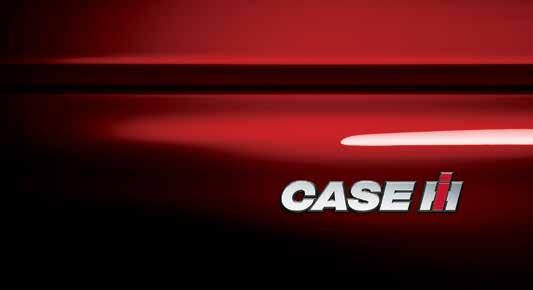
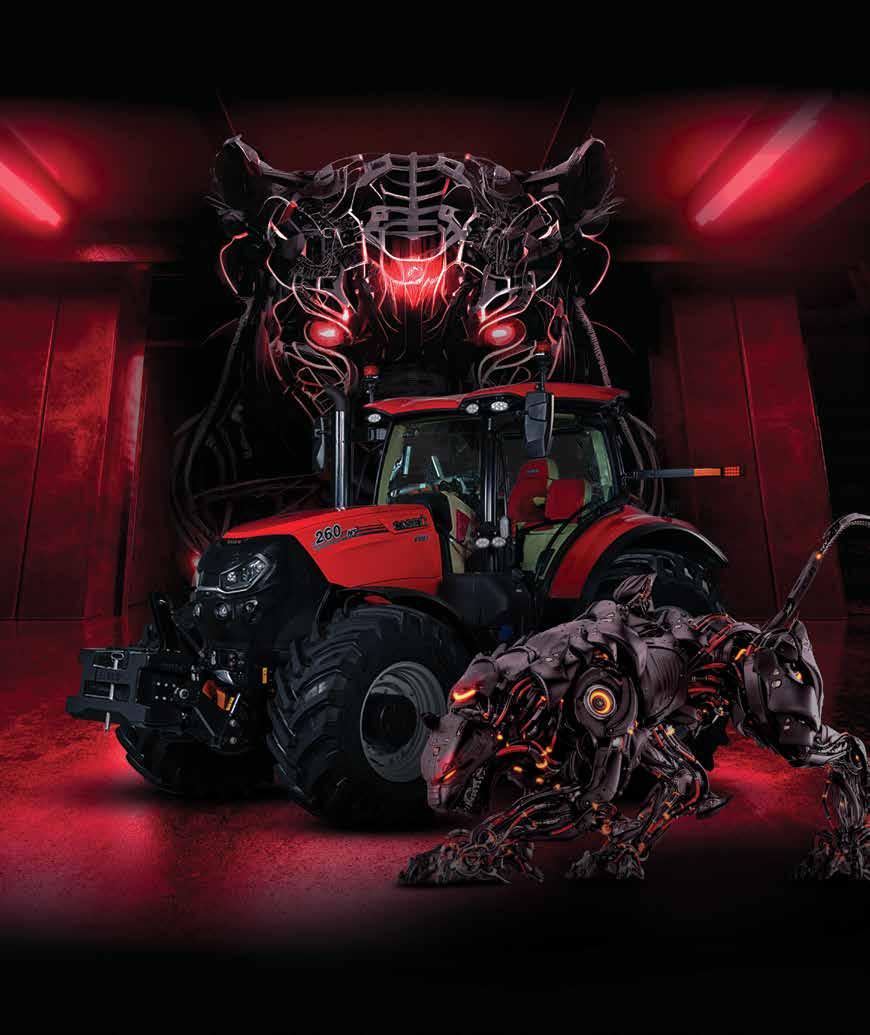






DON’T GET CAUGHT OUT - Make sure you are up-to-date!
• Over 140 new listings
• 160 deleted products
• 100 existing labels updated (new weed, pest & disease claims)
Plus the latest regulatory amendments
The definitive guide to agrichemicals registered for use in New Zealand.
A comprehensive alphabetical listing of products, active ingredients, crop & weed tables, weed & pest identification and much, much more all in one single publication. It really is the definitive agrichemical guide and the only one you’ll ever need.
Purchase a manual to receive a FREE 12-month subscription to our subscriber only website.
The website is continually updated and contains product listings, a fully searchable online product manual, a powerful search engine of weeds, diseases & pests, including photo galleries with all the agrichemical options to use on individual crops as well as up-to-date SDS’s, Haznotes and product labels, plus posts about industry news and information.
ORDER NOW to receive your FREE pair of SureShield Coveralls

SureShield Coveralls supplied by pH7, provides both protection and comfort with exceptional liquid and particulate protection. Ideal for a wide range of industrial applications. One size fits all.
Shigematsu Respirators supplied by pH7.
* Available to those who order directly from www.novachem.co.nz - while stocks last.
Print up-to-date SDS’s & Haznotes from novachem.co.nz to ensure you are compliant.
The six new models in the Massey Ferguson 7S Series offer maximum power from 145 hp to 210 hp. They are equipped to a high specification as standard and come with a choice of transmissions, cab comfort, automation and control technology.
Model numbers denote the maximum power of each tractor. They are the MF 7S.145, MF 7S.155, MF 7S.165, MF 7S.180, MF 7S.190 and MF 7S.210.
All models have a 2.88m long wheelbase for optimum stability and traction. Powerful six-cylinder, 6.6-litre engines deliver high levels of power and torque, while robust engineering enables them to carry and haul heavy loads.
The AGCO Power engine delivers generous amounts of extra power and torque. They are generated automatically when required for transport, PTO work or demanding hydraulic requirements.
In New Zealand, MF 7S models come with Tier 2 engines for straightforward, dependable operation and a very low cost of ownership.
Massey Ferguson’s efficient and easy-to-use Dyna-VT Eco continuously variable transmission offers seamless shifting. It is available on all models.
A Super Eco version of the DynaVT further improves efficiency by allowing the tractor to achieve 40 kph at just 1450 rpm.
Dyna-VT transmissions now have a new automatic mode. It allows operators to use the Multipad lever or the foot pedal to alter forward speed. It automatically sets the optimum engine speed according to the load and speed, so it delivers smoother operations and improves fuel efficiency.

For all models up to the 180-hp MF 7S.180, there is the choice of the efficient and reliable Dyna-6 Super Eco 24 x 24 semi-powershift transmission. Proven in the field for more than 20 years, this achieves a top speed of 40 kph at just 1500 rpm to save fuel.
Automatic Mode is standard on all Dyna-6 models. It automatically shifts speeds relative to the engine load and speed. Operators can manually set the engine rpm at which changes are made.
All MF 7S tractors have the useful brake-to-neutral function. It is easy to activate using a switch on the pillar.
Those working in specialist crops will welcome the Super Creeper option, which provides precise control with speeds down to 70 metres/hr at 1400 rpm.
MF 7S operators benefit from a cab that provides more comfort and better control. First introduced on the award-winning MF 8S tractors, the cab has a new armrest, Multipad controller and enhanced connectivity.
Operators will appreciate the latest Datatronic 5 terminal, which has a bright touchscreen to reduce glare. They can use
Datatronic 5 to manage all of the tractor’s functions.
With ISOBUS and GPS, it also runs the MF Precision Farming suite. It includes MF Guide, MF Section Control to reduce overlaps, and MF Rate Control for variable rate applications.
Massey Ferguson’s 8S Series deliver comfort and efficiency, and they are fully-connected to deliver smart, sustainable farming.
The six models in the MF 8S Series all have the unique Protect-U cab and engine installation and a radical ‘neo-retro’ design. Built on a 3m wheelbase they offer maximum power from 205 hp to 305 hp.
All MF 8S models come standard with MF Connect Telemetry. Optional is MF Task Doc data transfer software. With MF Connect Telemetry, contractors and large farmers can manage their fleets with MF Cloud-based tools.
While equipped with the latest precision technology, they offer exceptional value for money because owners only pay for what they need. Finance and extended warranty can be fully
integrated into the package.
The 3.4m3 cab has a four-pillar structure and delivers great visibility. It offers plenty of space, comfort, control and connectivity.
The Protect-U design creates a 24 cm gap between the cab and the engine. This reduces noise, heat and vibrations. With Protect-U, MF 8S cabs are among the best available in terms of noise levels.
AGCO Power six-cylinder, 7.4-litre engines deliver more power, torque, and performance at low rpm to reduce running costs. Maximum power is generated at just 1000 rpm and it is constant up to 1500 rpm. This provides high performance at low engine speeds and cuts fuel consumption and noise.
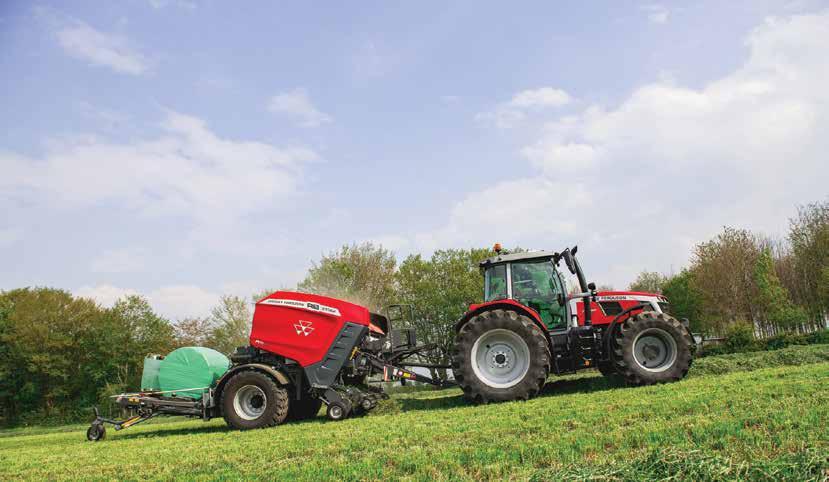
Two transmission options are available in NZ - the Dyna-7 Semi-Powershift, which offers 28 forward and reverse speeds, and the Dyna VT continuously variable transmission.
A new, rear axle combined with higher oil flow improves efficiency and versatility. With the extra traction power and oil flow, you can use wider, more productive implements to boost performance and reduce costs.
With its six-cylinder, turbo-charged engine that produces 305 hp and its V-Shift continuously variable transmission, the Landini 8-310 is prepared to do some serious work.
It comes with ISOBUS and is guidance ready so it can accommodate all the latest implements and precision farming applications.
The 6.7-litre engine is mounted on the cast iron chassis, which forms the main structure of the tractor. The engine puts out 224 kW, which gives the 8-310 exceptional power-to-weight ratio.
The V-Shift transmission has four-stage technology, which sets it apart from its competitors. Using a four stage VT transmission instead of the conventional two stage CVT transmission offers real advantages and gives famers and agricultural contractors additional productivity and efficiency.
With its V-Shift CVT, the Landini 8-310 reaches 40 kph at a quiet running 1300 rpm (or there is the

option of 50 kph at 1600 rpm).
Landini 8-310 tractors have a closed-centre hydraulic system with a variable displacement pump. This design means the pump always delivers exactly the quantity of oil that the system requires, and it eliminates power waste.
Oil supply is 212 litres/min to the hitch and remote valves and 115 litres/min to the electronic steering system. This gives
simultaneous operation of all hydraulic functions.
A unique feature of this tractor is the independent hydraulic oil reservoir. It holds 90 litres of hydraulic oil and eliminates any possible contaminated oil from an implement to infect the hydraulic components of the tractor or the transmission.
A robust rear three-point hitch provides lifting capacity up to 12,000 kg.
The four-pillar cab has semi-active hydraulic suspension. The air-suspended operator’s seat provides automatic height adjustment and a backrest with heating and ventilation.
All main controls and the multifunction joystick are located on the right armrest. The 8 Series can also be equipped with Landini’s fleet management and remote diagnostics system.

Valtra’s new Q Series is the ideal tractor for large farms and contractors who want performance and smart technology in the mid-to-high horsepower range.
The five models in the Q Series start with the 230-hp Q225 and extend up to the 305-hp Q305. All feature a powerful 7.4 litre AGCO Power engine and AGCO CVT transmission. Operator comfort is outstanding thanks to the large cab, which gives great visibility, excellent suspension and the award-winning SmartTouch user interface.
With their efficient design, low fuel use, and easy-to-use precision farming technology, Q Series tractors deliver a low total cost of ownership.
The 7.4 litre engine features the biggest displacement in the market for this size of tractor. Maximum power is available at very low engine speeds of 1850 rpm and the maximum torque stays consistent in the range of 1000 to 1500 rpm. The long stroke engine easily generates high power and torque.
All Q Series tractors have EcoPower, which reduces fuel consumption by reducing maximum engine speed in Eco mode. With EcoPower, the tractor reaches maximum driving speed at just 1500 rpm.
Electronic transmission management automatically selects the lowest possible engine revs for the job at hand in order to maintain low fuel consumption. It distributes the power accordingly to the hydraulics, PTO, or transmission. The driver simply adjusts the settings to whichever best suits the task.
With a maximum gross weight of 16 tonnes, Q Series tractors ensure a high payload. At the same time, their compact design and low centre of gravity ensure they are well-balanced and stable.
Air suspension in combination with the long wheelbase increases the pulling force of the tractor and reduces power hopping. Air suspension has a faster reaction time compared to standard hydraulic suspension, which creates better grip.
During road travel, power is

transmitted mechanically, so acceleration is fast and smooth. Both the cab and the front axle are air-suspended, and they are perfectly synchronized to ensure a smooth ride in any environment and any temperature.
Drivers will appreciate the Q Series’ all-day comfort with the award-winning SmartTouch armrest, market-leading visibility, and easy-to-use smart farming. Valtra Connect telemetry and task management are controlled from the SmartTouch user interface.
Task files can be stored so that it only takes a few swipes and taps to start a job. Q Series tractors also have SmartTurn, which fully automates the operating experience and allows the driver to focus fully on the implement and task at hand. Drivers can choose different automatic turning patterns to minimise soil compaction and increase speed and efficiency.
In true Valtra form, owners can customise their Q Series tractors. From upgrades to the cab or tractor colour to specialist adaptions for contracting work, Valtra customers can tailor their tractor to enhance productivity.
One option is automatic central lubricating, which ensures your Q Series tractor always runs smoothly and eliminates laborious manual lubricating. Another is Valtra’s intelligent central tyre inflation system, which protects the structure of the soil and optimises fuel consumption on the road.

The S Series is the first sixth generation in Valtra’s extensive tractor range. The six models in the S6 Series, extend from 280 hp to 416 hp.
Power comes from a new AgcoPower 8.4-litre engine which meets Stage V regulations without the need for exhaust gas recirculation (EGR). Using SCR (AdBlue) and avoiding EGR improves the engine’s combustion efficiency and means the engine runs cooler.
The new AgcoPower engine has a single turbocharger and its longstroke develops maximum power at just 1850 rpm. Peak torque is produced at only 1500 rpm.
The biggest model in the S Series is the S416. It produces up to 1750 Nm of torque and always has maximum power and torque available.
Valtra’s ML260 CVT transmis-
sion has a new hydraulic pump and heavy-duty PTO drive train. The tractor’s rear axle diameter is 125 mm to handle higher torque output and ensure effective power delivery to the ground. The transmission has two operating speed ranges – one for field work and one for transport.
The new engine and updated transmission increase efficiency and reduce fuel consumption by around 10 percent compared to its predecessor.
The S6 Series shares a similar cab frame to Valtra’s latest N, T and Q Series models. Advantages over the previous series include better air distribution through 12 vents at various levels around the cab.
The S6 cab is available with TwinTrac reverse drive controls, while the optional Skyview cab provides greater vertical visibility.
JCB Fastrac 8000 and 4000 Series tractors have received a sweeping electronics upgrade so that a host of modern technology can be fully integrated into the operating system.
The iCon platform comprises three sections – the iConfigure customisable control system, iConnect integrated advanced precision agriculture technology and iControl driveline software.
Claas Harvest Centre JCB product manager Steve Gorman says the platform takes the Fastrac to even higher levels of performance, productivity and operating comfort.
“iCon gives operators unprecedented choice and convenience in the way they operate their tractor. They have access to fully-integrated GPS guidance and implement control applications that minimise the need for additional displays,” Steve says.
The heart of the system is the console on the seat-mounted armrest. It houses the main joystick, auxiliary joystick, hydraulic control levers and controls for the PTO and hitch. Control of electrically-operated spool valves can be allocated to any of the five buttons on the main joystick or four buttons on the auxiliary joystick.
The colour-coded LED levers identify which spool valve is allocated to which control. The high definition 12 inch colour touchscreen display can show important information about the machine across five screens.
Steve says the basic run screen
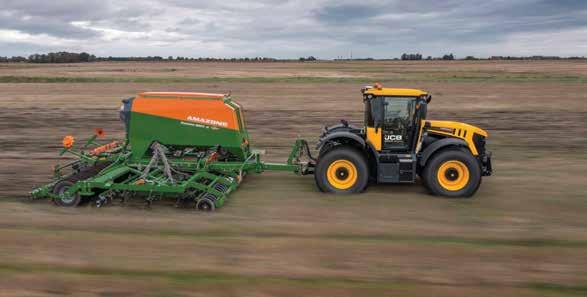
layout will be readily familiar to existing Fastrac operators.
Swiping right brings up a more detailed running screen with settings for up to six front/rear electric spool valves.
The next two screens display essential vehicle status information and it provides a remote camera view. Or it can be used as an ISOBUS 2 Universal Terminal screen for control of rear and front-mounted implements.
Finally, the fifth screen is dedicated to JCB’s new steering guidance and precision farming options.
The display can be positioned ahead of the controls for easy viewing or moved to one side to maximise visibility.
A 7” digital dashboard displays speed, engine rpm and essential vehicle status information.
JCB now offers a fully-integrated GPS guidance system based on a Novatel Smart-7 receiver,
steering controller and JCB user interface. Another option is to order your Fastrac iCon GPS Ready, so that your tractor can connect to a range of third-party guidance and precision farming systems.
Section control and variable rate control are available as unlock options.
The iCon models also incorporate JCB’s new Smart Transmission Control for improved powertrain efficiency and operator comfort.
“With Smart Transmission Control, the operator simply sets the required forward speed and the tractor will determine the correct gear ratio to maintain that speed under changing conditions,” Steve says.
“For added convenience, the joystick and pedal driving modes are automatically selected when either control is used.”
Operators have the choice of

using either the ‘classic’ and ‘pro’ joystick transmission control formats. With the Classic format, the operator selects the direction of travel by moving the joystick forwards or backwards, while speed is determined by moving the joystick left or right. Or the new Pro format transposes those functions – forwards and backwards to alter ground speed, left to operate the forward/reverse shuttle and right to engage the roller thumb switch for speed adjustments.
Another function that makes the operator’s work easier is JCB Headland Turn Assist, which can store up to 50 individual work sequences.
Other tools are JCB Rapid Steer, which reduces the number of steering wheel turns required, and JCB Twin Steer, which provides precise four-wheel steering on Fastrac 4000 Series tractors.
This on-board technology is complemented by a raft of cabin features designed to optimise operator comfort. The fully-automatic climate control air conditioning system rapidly and efficiently adjusts to any change.
Storage includes an under-seat drawer or cool box, armrest cubby, utility tray, cup holder and cargo nets. A USB port in the radio head, two charging USBs in the utility tray and a data transfer USB port in the armrest cubby assist with connectivity.
The Pro Line configuration includes a heated air suspension seat, front linkages, LED road and auxiliary headlights, twin beacons and a road performance package.
Kubota’s all-purpose, midrange M5-1 tractor is well tailored for New Zealand farmers seeking comfort, high-performance and agility.
All models in the M5-1 range have the renowned V3800, four-cylinder diesel engine that tops out at a hefty 110 hp. When paired with the Kubota X46 front end loader they are perfect to tackle all types of jobs on the farm.
The M5-1 Series covers four models – the M5091 and M5111 Standard and the M5091 and M5101 Narrow, with power ratings from 93 hp up to the M5111 with 110 hp.
M5-1 tractors are powerful, simple to operate, highly agile and have Kubota’s well-known reliability. They are designed to get every job done with maximum efficiency.
To do that, Kubota has packed the M5-1 with performance-driven technology. It includes the Kubota-built, 3.8-litre V3800 common rail engine that meets European Tier IV emission

standards and delivers clean, economic performance with minimal noise and low fuel consumption.
M5-1 Series engines feature a new electronic governor that gives you electronic control of engine rpm. The electronic speed control also allows you to optimise the efficiency of PTO-
driven implement operations.
Activating the system keeps engine revolutions constant, preventing drops in PTO speed and enabling stable operation. It makes working with PTO-driven implements much more efficient.
Whatever the task, there’s a gear that will get it done. The
M5-1 ROPS Ag tractors offer 18 forward and 18 reverse from six synchronised gears in three ranges with a smooth power shuttle. Dual Speed technology in the Narrow and Cabin Ag tractor models takes this to 36 forward and 36 reverse gears, ensuring that you are always working efficiently.
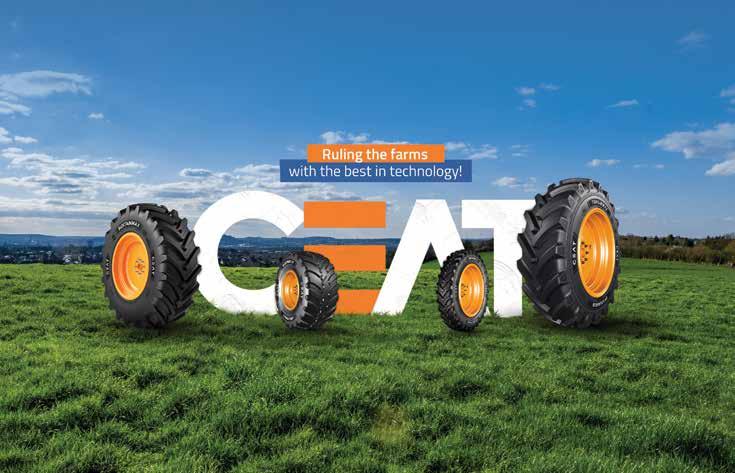
John Deere has unveiled the most powerful tractors it has ever developed, the all new 9RX Series.
The new range includes three new high-horsepower, fourtrack models. All models come standard ‘autonomous-ready’ so they can be easily converted to work autonomously without a human operator.
9RX Series tractors are powered by the JD18 engine from John Deere Power Systems. The range includes the 9RX 710 (710 hp), 9RX 770 (770 hp) and 9RX 830 (830 hp).
John Deere production systems manager Ben Kelly says the 9RX range puts out the high-power performance needed to meet the demands of modern farming.
“With shifting weather patterns, labour shortages and growing input costs, the ability to prepare, plant and harvest efficiently has never been more important,” Ben says.
“We are proud to bring the new 9RX Series to market. They feature a new engine and hydraulic options, new technology packages, a better cab and a suite of other Model-Year 25 updates that will optimise operating speeds and efficiency.”
The JD18 is a Stage V-compliant 18-litre engine that produces lower emissions using exhaustgas recirculation technology without the need for diesel exhaust fluid.
An optional 635 litre/min triple-pump hydraulic system gives farmers the confidence to pull wider and heavier air-seeding trains over rolling ground, while still maintaining tractor and fan speed.
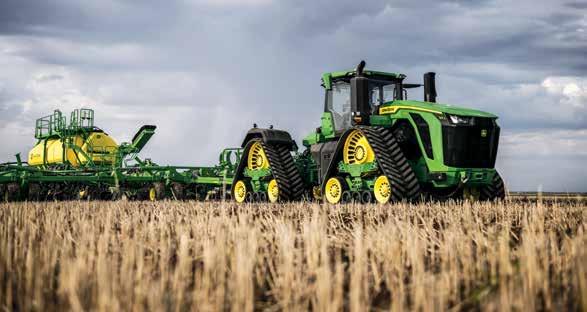
“These are not just incremental improvements. They are definitive changes in power and technology that will drive efficiency and profitability,” Ben says.
To help farmers prepare for autonomous operation, new 9RX Series tractors will be equipped with autonomous-ready capabilities. This will allow them to quickly and easily make the switch to fully autonomous operation.
“As fully autonomous farming moves closer, we know how important it is for the investment farmers make in equipment to have true longevity. We want the switch to autonomous operation to be as quick and simple as possible for our customers,” Ben says.
“The autonomous-ready package offers the hardware and safety features we know will be required for autonomous operations.”
Key features of the package include rear implement Ethernet, visibility features, a back-up
alarm, a 330-amp alternator, a brake controller and valve, and all the necessary connectors, controllers and harnesses.
9RX tractors feature a new CommandView 4 Plus cab, which gives 15 percent more floor space and 20 percent more visibility from the right-hand side. It gives operators more storage space and comfort, thanks to its full 3° of motion and isolated subframe that protect operators from uneven terrain and noise.
The new 9RX models feature industry-best technology, including the G5 Plus CommandCenter Display and integrated StarFire 7500 receiver. An optional G5 Advanced technology package with SF-RTK offers the ultimate in precision capabilities.
“The combination of the G5 Plus display and the optional G5 Advanced technology package gives farmers access to virtually the entire John Deere portfolio of intelligence and productivity features,” Ben says.
“This includes AutoTrac Turn
Automation for automated headland turns, as well as tools for more precise implement guidance and the automated creation of guidance lines.
“John Deere Operations Center and JDLink connectivity deliver a complete technology operating system that can collect, manage and analyse field and machine data anywhere and at any time.” Ben says 9RX Series tractors will help farmers meet critical windows in their production cycles.
“For small grain farmers, the higher engine and hydraulic power means they can pull fully-loaded air seeders over virtually any type of terrain without slowing down. The ability to pull wider implements will fast-track field preparation tasks, such as deep ripping and disc tillage,” he says.
The new MY25 high-horsepower 9RX models can now be ordered for delivery in early 2025. Additional model-year updates are also available for 7 and 8 Series tractors.
With superior traction, high ground clearance, and excellent driving stability, the M5-1 offers outstanding manoeuvrability, even in tight spaces. Add four-wheel drive and you have a tractor that is ready for all types of tasks under all kinds of conditions.
Standard on all M5-1 Ag cabin models, a large glass skylight provides more light in the cab
as well as a view of a fully raised front loader. This is ideal when stacking hay or balage onto a truck or in the shed. On blindingly bright days, the skylight’s retractable sunshade can be closed to keep the sun out and the operator cool.
Like all Kubota tractors, the M5-1 is perfect for a variety of uses on cattle and dairy operations, for field work, or in special-
ty crops, vineyards and orchards.
New Zealand farmers can trust their M5-1 to work hard for them thanks to its versatile hydraulics and tough Category II threepoint hitch that lifts 3200 kg at the rear in the Standard model and 1500 kg in the Narrow configuration.
The narrow cab M5091 and M5101 are perfectly suited to orchards and vineyards with
their narrow cab, horsepower ratings of 93 hp 105 hp respectively, 36/36 transmission, and flat floor.
At National Fieldays 2024, the Kubota M5-1 will be on display at site G42. They are available through the nationwide Kubota dealer network.
For more information and to find your nearest dealer, visit the website: Kubota.co.nz.

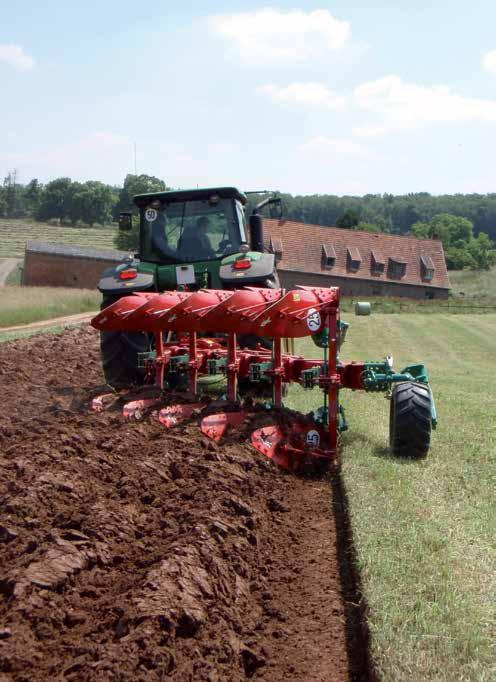
•
•
•
•
• 5-6 furrows
• Robust and reliable construction
• Variomat Vari-width® system for furrow width adjustments that save fuel and time
• Last chance to get these ploughs, run-out sale now on

• 300hp rated, up to 6 furrows
• Reduced lift requirements
• Hydraulic variwidth standard
• Unique steel and heat treatments a guarantee for durable high performance
• Does both on land or in furrow
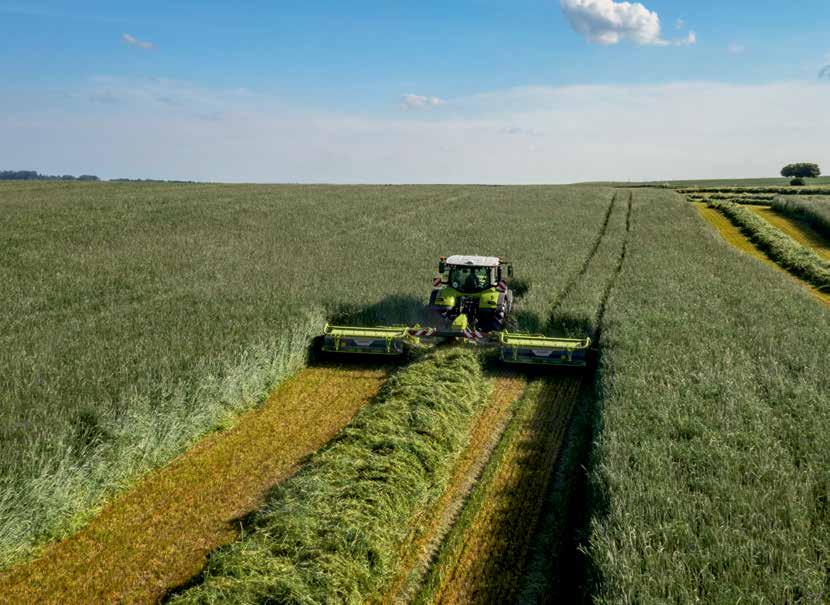
WITH A VARIABLE WORKING WIDTH OF 8.8M TO 9.5M, TRIED-AND-TESTED MAX CUT MOWER BEDS AND ACTIVE FLOAT SUSPENSION, AND A RANGE OF CONDITIONING AND AUTO SWATHING FUNCTIONS, CLAAS DISCO 9700 TRIPLECOMBINATION MOWERS SET NEW BENCHMARKS IN THROUGHPUT, EFFICIENCY AND FORAGE QUALITY.
Claas Harvest Centre product manager Luke Wheeler says each of the side units on the mowers feature hydraulically controlled swing arms that can be independently pivoted outwards by 30 cm and inwards by 5 cm whilst mowing.
This allows the working width to be adjusted up to 70 cm on-thego. For example, the driver can choose between maximum overlap on headlands to avoid strips or maximum working width on straight lines.
“It makes the 9700 ideal for mowing irregularly-shaped or undulating fields where a higher degree of flexibility is required to maintain cutting quality and protecting the pasture.”
This new 9700 Series expands the Claas product offer for largescale mowers and closes the gap between the Disco 9200/9300 and the Disco 1100.
CLAAS DISCO 9700 TRIPLE MOWERS OFFER WORKING WIDTHS UP TO 9.5M AND HYDRAULIC WIDTH ADJUSTMENT ON-THE-GO.
The new range has five models – Disco 9700 Comfort, 9700 C Business (tine conditioner), 9700 RC Business (roller conditioner), 9700 C Auto Swather (tine conditioner and swath grouping) and 9700 RC Auto Swather (roller conditioner and swath grouping).
On the Comfort model, Active Float ground pressure control, swing arm travel and protective cover folding are all controlled via ISOBUS and load-sensing. The arms are lifted and lowered with hydraulic spool valves.
This enables the driver to easily integrate lifting and lowering
AUTO SWATHER MODELS HAVE TWO KEVLARREINFORCED, 1.1M WIDE CONVEYOR BELTS THAT BRING THE HARVESTED CROP FROM THE REAR MOWERS TO THE CENTRE TO FORM A SINGLE, PERFECTLYSHAPED SWATH.
functions into the tractor’s headland management system.
With Business model mowers, all functions can be controlled using the continuous load-sensing hydraulic system via the ISO -

BUS terminal, function keys or the tractor’s headland management system.
RC models feature two counter-rotating polyurethane rollers that are actively driven and synchronised with a specially-developed scissor gearbox. It gives maximum throughput and processing quality.
The rollers on RC models extend across the full width of the mower bed. They gently crush the harvested crop and optimise crop flow.
RC models are developed to gently process large volumes of lucerne, forage crops and wholecrop silage.
Auto Swather models have two 1100 mm wide Kevlar-reinforced conveyor belts that bring the harvested crop in from the left and right hand mowers to form a single, perfectly-shaped swath, ready for processing by a silage harvester.
Claas claims the system can easily handle crop yields of up to 60 tonnes/ha.
Both Auto Swather belts can be independently disengaged and folded up if swath grouping is not required.
One or both of the belt units can be folded up hydraulically when working without swath grouping. Or you can use the ‘19 to 12’ method, where a working width of 19m is consolidated into 12m for the next pass with a 12.7m-wide standard quad-rotor swather.
The belt automatically switches on or off according to the working/ parking position.
Auto Swather models can also be ordered with an optional central lubrication system, on-board hydraulics or an oil cooler.
New Disco 9700 models feature award-winning Claas Max Cut mower beds that deliver exceptional cutting quality and efficiency.
In light crops the mower beds can be operated with PTO speeds down to 850 rpm to reduce fuel consumption by up to 20 percent.
Pressed from a single piece of 5-mm thick steel, they have
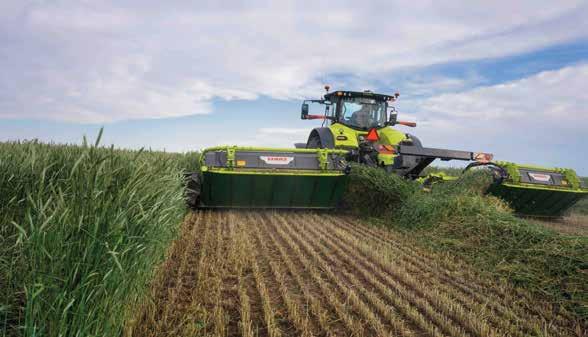
a unique wave-shaped design that enables the cutting discs to be set further forwards. This improves cutting quality in all conditions.
Claas has designed the shape of the skids and the large channel between the discs to provide a high degree of self-cleaning.
Optional new wear skids provide another 15 mm more cutting height. This reduces the amount of crude ash introduced into the swath and promotes faster pasture regrowth.
Safety Link ensures each cutting disc is protected by a pre-determined breaking point. This isolates it from the drivetrain if there is contact with a foreign body. An axial bolt holds the cutting disc firmly in place to prevent it flying off if it breaks.
Specially-hardened intermediate pieces are shaped differently for the mower discs that converge and diverge to give a clean cut and maximum overlap.
Luke says Max Cut mower beds also incorporate Claas’s rapid blade-change system. The caps and mower blades of the clockwise and anti-clockwise rotating mower discs are painted black and red, respectively.
“This means replacement blades can be immediately assigned to the appropriate mower discs. The new blade box is divided into three compartments for red and black replacement blades and used blades.”
Active Float Comfort regularly and automatically adjusts the ground pressure, so the mowers continually adapt to ground contours.
“This system has been tried and tested for almost two dec-

ades and has been proven to reduce forage contamination, fuel consumption and wear,” Luke says.
“Contact pressure can be independently adjusted on either side when mowing borders and slopes. It is displayed in the terminal or on two gauges on the headstock.”
Mower units are driven by new triple telescopic drive shafts with toughened large-diameter steel profiles that enable the enormous adjustment range of the mower arms.
“A new high capacity K-90 friction clutch is bolted directly to the universal joint shaft. This makes it quick and easy to service,” he says.
The innovative hitch frame with angled arms ensures optimum centre of gravity during operation, turning and road transport. The arms are equipped with individual non-stop collision protection.
“When the mower encounters an obstacle, the arm swings back
and over, moving the mower unit as far from the danger zone as possible,” Luke says.
For Disco mowers fitted with hydraulic collision protection, oil is pressed from the collision protection unit into the relief cylinder. This means that the mower bed is additionally relieved and the mower bed is protected from serious damage.
The mower bed then automatically swings back into its working position due to the oil pressure. When operating on slopes, an optional tilt sensor adjusts ground pressure, the telescopic travel of the arms to counteract drift, and the belt speed (on Auto Swather models) to reduce the driver’s workload and protect pastures.
Folded into transport position, the arms automatically retract to a height of less than 4 m.
Hydraulic hoses are fitted with Kennfixx couplers as standard. Electric cables are safely stowed in a new parking bracket when the mower is unhitched.
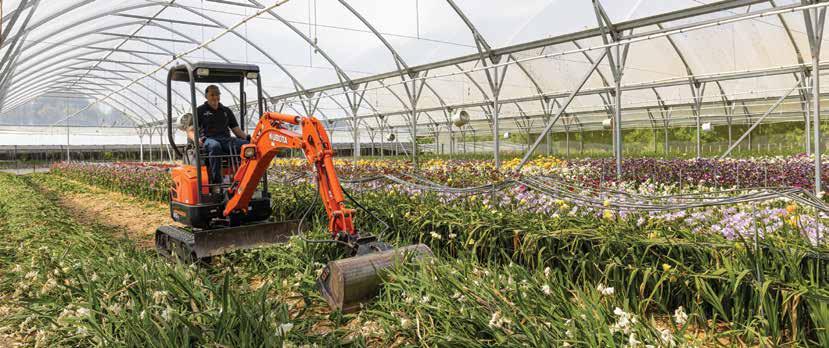
FOR WILFLORA FLOWER FARM’S MARTIN WILSON, THE JOY OF BUSINESS COMES FROM KNOWING HIS WORK WILL MAKE SOMEONE’S DAY.
The Palmerston North farm produces top quality freesias and mixed cut flowers year round. Martin’s parents originally launched the enterprise in 1973
and he says he is proud to continue the family business.
Martin’s mother was a florist, and he spent his childhood days lending a hand on the farm.

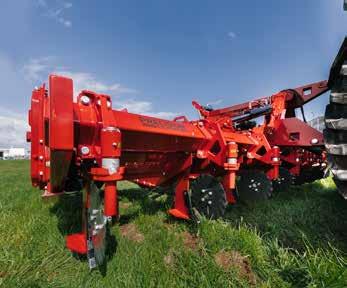
“Back then, the farm was very small. We only had two or three staff, so I always helped after school. We live and breathe the flower industry.
“I actually met the love of my life Jennifer, right here on the farm,” Martin says. “We now run the business together. I couldn’t do it without her support.”
The farm has expanded over the years. What began as 4500 m2 of greenhouses has now more than doubled. The greenhouses operate at an optimal temperature, warm in the winter and cool in the summer. More greenhouses are on the cards, as Martin eyes expanding the business.
Prices fluctuate and Martin says it is important to establish trust and good connections with partners to ensure the best sales.
“Our products are perishable, so you need to have trust from the buyers. Our partners see our products once we send out the boxes to auction, so we always make sure we have the best quality flowers in the market.
“My team just focuses on the growing side. If we can provide our partners with the best flowers, the sales just follow through.”
To ensure Martin produces the highest quality flowers, he relies on high-quality machines to assist his daily operations.
“We can’t afford to slow down. We are always on the go here at Wilfora and we need our machinery to keep up with our pace.”
To control the risk of soil diseases, Martin has established a deep soil steaming drainage system with a large network of drainage pipes. Building the network marked the start of Martin’s relationship with Kubota.
“We needed to build a huge network of drainage pipes under the flower beds. The area we had to trench to grade was 7000m long. This was no small task because we had to do the trenching in between the change of crops.”
Martin says Kubota’s easy-touse machines are the perfect fit for working indoors and they provide an exceptional powerto-weight ratio.
“We purchased the Kubota U17 excavator for trenching. Once the drainage had finished, I realised how handy it is to have the excavator around.
“If a crop comes out with too much residue, we just use the excavator to easily scrape it out and put it straight onto the trailer. It has also been really helpful levelling off the growing beds.
“We have now purchased our second excavator, a Kubota U-55 because it is perfect for the bigger jobs around the farm.”
Kubota ticks all the boxes when it comes to performance-wise, enabling him to innovate on-farm, he says.
“People initially questioned why we were purchasing an excavator for our farm, but farmers are now asking to hire it because it is so useful.”
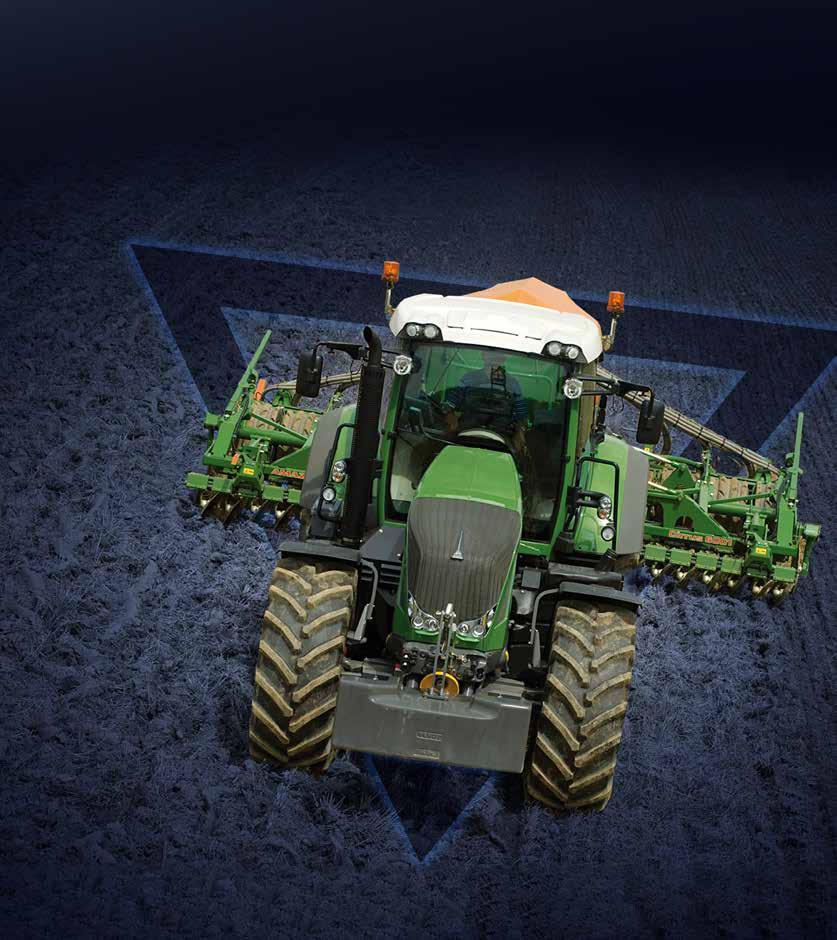

KUMARA GROWER EVAN PAXTON AND HIS FAMILY FARM AT RIVERVIEW FARMS NEAR DARGAVILLE. EACH YEAR THEY GROW AROUND 60 HA OF KUMARA AND FATTEN PRIME LAMBS AND BEEF CATTLE ON THEIR 200 HA FARM.
Delta Co-Op packs, markets and transports the Paxton family’s kumara throughout the North and South Islands, so it is critical that they keep their machines humming.
“If we do have a breakdown, especially on a key tractor like our John Deere 7230 or 7290, which we use for ground work, or our moulding tractor or spray tractor, it pretty much puts a halt to the whole day. Until we get that fixed, we are under the pump,” Evan says.
“Breakdowns are rare, but if you are working towards a weather window or trying to fill orders from the packhouse, they can have a huge financial bearing on our company.”
Riverview Farms is a family business established in 2001, when Evan and his partner Tanya, who had been in business on
their own, joined forces with his mother Judy and brother-in-law Graham and his wife Twane.
Since then, the business has gone from strength-to-strength.
The Paxtons are staunch fans of green and yellow; they run a fleet of 12 John Deeres ranging in power from 70 to 290 hp.
In March, Riverview Farms took delivery of their 13th John Deere tractor from their dealer, Brandt Machinery in Whangarei.
“The new 6120M utility tractor with AutoTracTM replaced our very first John Deere, which was a 6400 that we bought back in 1994,” Evan says.
“A small compact tractor like the 6210M with 120 hp is ideal. We can still use it to pull a 3m harvesting machine without any problems, and it is absolutely perfect for day-to-day crop maintenance, whether it’s spraying and dry cultivating or top chopping.”
Evan considers lubricants a key factor in maintaining his fleet.
“The old 6400 has been amazing. It did more than 13,000 hours and we have had absolutely no issues with the engine. Just a few little bits and pieces, as you would expect. It will probably end up being a boat tractor,” Evan says.
“Over the past 10 years, we’ve
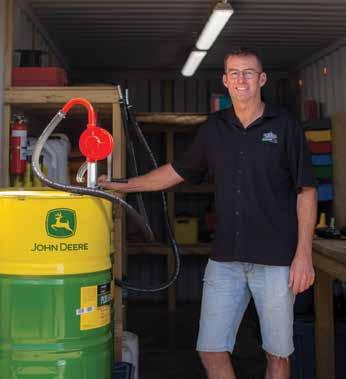
exclusively used John Deere transmission, hydraulic and engine oils and grease. We have noticed a big difference in the running of the machines, especially using the grease on our harvesters and tractors as well.
“If you are spending all that money on machines, you definitely want to look after them.”
Evan uses Plus-50 II engine oil, Hy-Gard hydraulic oil and SD
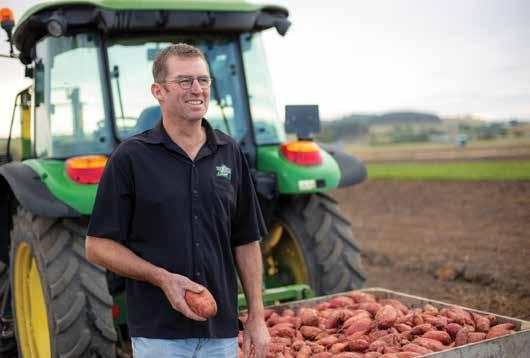
BREAKDOWNS ARE A MAJOR HEADACHE FOR KUMARA GROWERS, SO EVAN PAXTON USES JOHN DEERE OILS AND GREASE.
EVAN PAXTON USES JOHN DEERE PLUS-50 II ENGINE OIL, HY-GARD HYDRAULIC OIL AND SD POLYUREA GREASE ON HIS FLEET OF JOHN DEERE UTILITY TRACTORS.
polyurea grease.
“It is the lack of breakdowns that we have really noticed over the years. The products speak for themselves in that regard,” he says.
“The 500-hour service interval is also a game changer. We have actually had some tractors go over 500 hours when we have been busy but with the quality John Deere products that we use, we have had no issues to date.
“I personally wouldn’t recommend using a cheap oil if you want to achieve a 500-hour service. At the end of the day, quality pays, and the upshot is when we are out there in the paddock, the machines are working and not sitting in the shed.
“I think when times are tough, people might stop buying quality and look for a cheaper product, but for us, it is more about peace of mind. You know your tractor is in safe hands.”

The Steiger 715 Quadtrac has an engine rated for 715 continuous horsepower (527 kilowatts) and 778 peak hp.
Case IH ANZ Steiger product manager Justin Bryant says the Steiger 715 delivers “power with purpose”. It puts more power to the ground so contractors and farmers can do more in a day, but it is still agile and versatile enough to navigate a single lane of traffic.
“With the arrival of the Steiger 715 Quadtrac, combined with the new Steigers we launched to the local market last year, the range offers one of Case IH’s most flexible offerings. This is a very exciting announcement for our brand and we are extremely proud to finally have it here and available for New Zealand customers to order,” Justin says.
Among the Steiger 715 Quadtrac’s notable features is a new heavy-duty undercarriage with a longer track. It delivers better traction and flotation to match the tractor’s high horsepower, while it still reduces soil compaction and delivers more power to the ground.
Powering the big Steiger is a new FPT 16-litre TST twin-stage turbo Tier 2 engine with 23 percent increase in displacement over the earlier 13-litre version. It delivers more power and more torque.
Working the engine is a 16-speed PowerDrive powershift transmission. It delivers faster road speeds and there is more fuel capacity to allow longer stints in the paddock.
Justin says the 715 Quadtrac delivers higher three-point linkage capacity and full engine power through the whole working range of the three-point linkage.
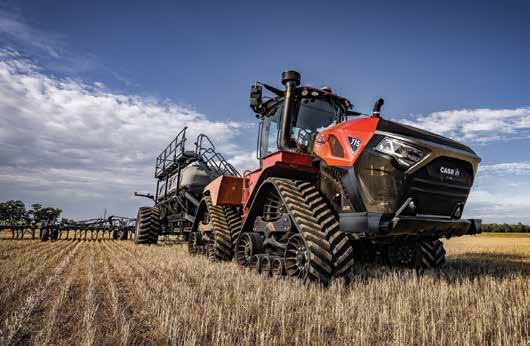
Operators enjoy better visibility during work thanks to a re-styled cab interior, redesigned bonnet and exhaust, and more LED lighting.
Case IH has made design changes that provide easier access to carry out daily service and maintenance. These include a new engine bonnet and debris shields that can be easily removed without tools to provide greater access around the engine.
The state-of-the-art cab can be specified with dual Pro 1200 displays for better control of more functions. The cab also has a ventilated and heated leather seat, a telescoping steering wheel with memory lock, and a leather MultiControl armrest.
“This is the largest, most powerful tractor Case IH has produced. It further complements the proud history of the Quadtrac family,
which has been a leader in tractor power and efficiency since 1996,” Justin says.
“The large-scale arable sector has been demanding more power. Now we have delivered with the Steiger 715 Quadtrac, which is ideally suited to deliver what these farmers need, in our demanding and challenging conditions.”
In Australia and New Zealand, the Steiger 715 Quadtrac joins the AFS Connect Steiger range announced in August 2023. These include rowcrop wheeled models of 425-525 hp, wide-frame wheeled models of 555-645 hp, 555-645 hp scraper models, 475-645 hp Quadtrac models and 425-525 hp Rowtrac models.
For more information or order inquiries, contact your local Case IH dealer.


FOR NEARLY 25 YEARS THE MAIN TRACTOR AT WOODLEIGH DOWNS FARM HAS BEEN A VALTRA.
Andrew and Nicole Ewen farm the 600 ha-property near Huntly with Andrew’s parents, Nick and Sue. It was Nick’s decision to buy their first Valtra back in 2000.
The Ewens are now onto their sixth Valtra, a T175 Direct with a CVT transmission. It has front linkage, front PTO and a Valtra front loader.
They do all their own work on the farm, where they run sheep, cattle and deer. Their main crop is maize for grain or silage and they grow various brassicas. They also do some contracting, on their own and subcontracting to another local contractor, Kelvin Babington.
Contracting work is for dry stock farmers on the rolling country northwest of Huntly. Services include ground work, fertiliser-spreading, under-sowing and spraying.
With a road speed of 53 kph the Valtra T175 is a good option for a contractor moving between jobs.
Also important for someone sitting in a tractor most of the day is a comfortable seat.
“I went for the Premium trim because I wanted the flashiest seat. It is more comfortable with more adjustments. It is also better when you are looking behind,” Nick says.
For who really need to look behind, Valtra provides the TwinTrac option. The seat swivels 180° and there is a separate set of controls and steering wheel at the back. Andrew did not need this option.
The T175’s engine is a six-cylinder AGCO Power Stage V with low revs and high torque.
“Fuel efficiency is why we went to a six-cylinder from a four-cylinder. There is a massive difference in fuel savings.”
Andrew says you can never have enough horsepower and the T175 boosts up from 175 hp to 190 hp. This is useful for heavy jobs such as carting 20 tonnes of rock or pulling a 4.6m power harrow on slopes.
Hydraulics are standard with 115 litres/min flow and there are
options of 160 or 200. Andrew has 160 litres/min and he says it is ample.
The cab has a narrow dashboard making it a room with a view.
“Visibility is outstanding and good at all angles. The side window wipers are also outstanding. You can keep visibility on the right-hand side.”
For a tractor so stuffed with technology, it is simple to drive.
“It has a very well-designed cab, with a lot more space. Everything is accessible, well-labelled and easy to use. It has been well thought out. It is very easy to operate.
“The SmartTouch monitor is very user-friendly. You point at what part of the tractor you are trying to change and it comes up.”
It has programmable buttons and each operator can put in their favourite settings to customise it to their own requirements at the push of a button.
“Each implement also has its own settings available on the menu. We set up a programme for each implement, like the hydraulic flow needed, and just highlight it when we need it,” Andrew says.
The Valtra T175 is very well connected. It is set up for GPS and it has auto-steer. It also has TaskDock Pro, which receives jobs and also automatically generates information when the tractor is working. This can then be wire-
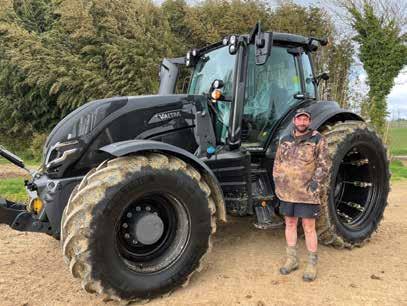
lessly sent back to the home computer.
Valtra Connect means the dealer keeps track of service intervals and if there had been any faults would be up with the play before Andrew even called them.
It also allows Nicole to know where the tractor is. This is a vital health and safety feature, especially when Andrew works at night using the super-effective lighting package
“The lights are bloody good. I wish they weren’t. Then I wouldn’t have to work at night,” he says.
The Ewens’ dealer is Waikato Tractors and Andrew says they have been absolutely brilliant.
“Parts are always in stock. I have never had to wait for parts or a mechanic. Over the years they
ANDREW EWEN SAYS HIS FAMILY HAS STUCK WITH VALTRA TRACTORS FOR 25 YEARS BECAUSE EVERY NEW MODEL IN AN IMPROVEMENT OVER THE PREVIOUS ONE.
have sorted issues quickly.”
The long service interval is 600 hours. “It all helps, as it is another cost.”
Andrew tends to update tractors after 4500 hours. It keeps resale high and keeps him up-todate with the latest technology.
“Valtra improves every new model. It is one of the reasons why we stick with them. We have been happy with the service and how well the tractors have worked for us over the years,” he concludes.
THE VALTRA T175’S SIX-CYLINDER AGCO POWER LOW REV/HIGH TORQUE ENGINE HAS IMPROVED THE EWENS’ FUEL EFFICIENCY SIGNIFICANTLY.
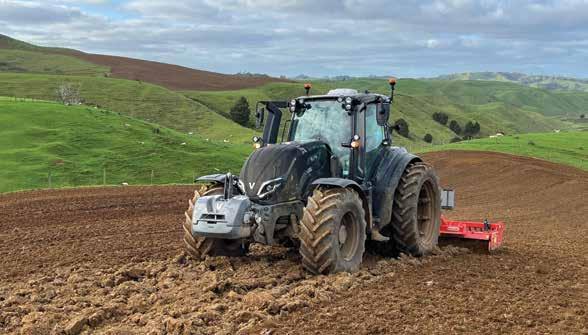
NZ Rural Contractor is available free of charge to readers who qualify under the publisher’s criteria and who supply proof of occupation (printed letterhead, business card, invoice etc) and to others via subscription and payment of the $68.00 inc GST annual NZ Subscription. Australian Subscription $130, Rest of World $270.
If you are not a registered reader, but would like to receive a regular bi-monthly copy, fill in the details of your contracting or farming business below.
Subscription criteria for owners/sharefarmers:
Dairy milk over 600 cows
Sheep & Beef 12,000+ stock units
Cropping over 250 ha in arable
Main contracting services offered:
Equipment operated


Total farm Ha.:

No. of sheep: No. of dairy cows: No. of beef cattle: Area in arable crop:
Make, Year, Model
To subscribe to NZ Rural Contractor & Large Scale farmer, please complete the credit card form below: $68.00 (NZ), $130 (Australia), $270 (Rest of World).
Name:
Company:
Address:
Email:
Rapid No.
Phone:
Post Code:
Please sign here if you wish to receive a regular copy of this publication and send the form to AgriMedia Ltd, P.O. Box 37151, Halswell, Christchurch 8245. Freepost No. 114059.
Sign: Date:
PAYMENT:
Credit Card: Mastercard Visa
Card Number:
Name on Card:
Expiry Date: / CSC:
Signature:
If you have moved, please write clearly your name and new address above and your old address (including post code) below.
Name:
Company:
Address:
Email: Rapid No.
Phone: Post Code:
NEW HOLLAND TRACTORS PROVIDE THE HORSEPOWER FOR WAIAU ENTERPRISES, A MACHINERY SYNDICATE THAT HAS BEEN WORKING FOR FARMERS AROUND NORTH CANTERBURY FOR 50 YEARS.
Six farmers currently own Waiau Enterprises. It does their work and that of neighbouring properties. It is based in Waiau, a small community north of Culverden and its main services are cultivation, drilling and baling.
James Green is Waiau Enterprises’ operations manager. James reckons New Holland is the best deal when it comes to cost per horsepower.
“They are high-spec tractors, they have a good power-toweight ratio, and they are fuel efficient,” he says.
Waiau Enterprises runs three New Holland T7.245 row-crop tractors that arrived from 2020 to 2023. They also have a 2017 T7.250 that they are about to trade in for the latest T7.245.
James says the T7.245 is a goodsized contracting tractor for North Canterbury.
“We do a lot of hill work and couldn’t get bigger tractors with the extra weight around the hills. These are nimble tractors.”
Their six-cylinder FPT engine provides enough grunt even for their biggest job – working up fodder beet paddocks in spring with a 4m deep ripper. “Our 5.5m speed discs also take some pulling.”
All of the T7.245 tractors in Waiau Enterprises’ fleet have constantly variable transmissions.
“You wouldn’t go away from CVT in the contracting world. It is so easy because you are not changing gear every second. The CVTs are getting better and better. We have never had anything go wrong.”
They are also all optioned with front PTO and linkage and 650 tyres on the rear.
“Most have 710 tyres on the back but we put on 650s for duals. There are a lot of one-way bridges and small gateways and big duals wouldn’t get through. The duals have snap fastenings and it takes less than five minutes to take them on and off.”
New Holland T7.245s provide both power and glory with their happy work environment. James says his favourite feature is the comfort they provide.
“The seat is the main thing, but it also has good cab and front suspension. And it is sealed, so you can’t hear a thing going on outside.
“Visibility is excellent with a wrap-around windscreen and the layout also makes life simple. It’s an operator-friendly cab. I have
ALL OF WAIAU ENTERPRISES NH T7245 TRACTORS HAVE FRONT PTO AND FRONT LINKAGE AND DUAL 650 TYRES ON THE REAR.

never tried a person off the street in it, but it is easy for an operator to learn.”
All of their T.7245 tractors are ISOBUS-compatible for plugand-go with any ISOBUS implements.
“It is so much easier. You don’t need a dedicated baler tractor. When a driver is finished, he can go back to the yard for a different implement and just carry on.”
The tractors are all guidance-ready with IntelliSteer automatic steering. James uses IntelliSteer and says it is necessary on all of the tractors for drilling and cultivation.
Each new T7.245 model has come with some new features. The telematics package in the 2023 version allows the dealer to receive fault codes, and it has increased service intervals (from 600 to 750 hours). James says this saves time and money.
For night work he opted for the full LED light package. “It is 100 percent worth it.”
They also optioned for a hydraulic oil rate of 170 litres/min.
New Holland has also provided a big square baler for Waiau

Enterprises. It is a BigBaler 1290 and it is used for silage, hay and straw.
The bales are 4x3 and James makes silage at 1.5m, hay at 1.8 to 2m and straw up to 2.2m, depending on what the client wants. The silage bales are around 800 kg.
Mostly they bale grass, but also lucerne, oats, pea straw and linseed straw.
It is not the high-density (HD) version of the 1290, which has a longer chamber and is heavier. James says they wanted the smaller version for hill country. Manoeuvrability on hills, through gateways and into row corners is helped with back-axle steer.
The BigBaler 1290 has a
2.35m pick-up and an adjustable pre-compression chamber, where the crop is held until it reaches the correct density.
“Every aspect has been tried and tested. The knotting system works really well. If there’s a problem then it’s operator error, for example baling straw when it’s too dry,” James says.
How many bales they pump out in a day depends entirely on the crop.
“Some dairy farms mow at low covers and over 10 ha we get 10 bales in a couple of hours. Then you get paddocks with heaps and we make 200 bales in 3 ha in the same amount of time. The machine will tell you if you need to slow down: it’s all about crop
JAMES GREEN SAYS NEW HOLLAND T7245S ARE IDEAL CONTRACTING TRACTORS FOR NORTH CANTERBURY BECAUSE THEY ARE BOTH NIMBLE ENOUGH AND POWERFUL ENOUGH TO PERFORM IN HILL COUNTRY. Without predator control, these habitats and the native wildlife that depends on them will continue to decline — even with stock exclusion. Our toolbox will guide you through how to manage pests in these unique spaces.
flow. We are always learning.”
The baler carries 14 rolls of twine on each side which is more than enough for a day’s baling.
James runs it through the tractor’s monitor. He can set the number of slices he wants in a bale, for example. “The optimum-shaped bale is 27 to 30 slices.”
Waiau Enterprises’ tractors and baler are provided by Cochranes in Amberley.
“They are a good team and will do anything for you,” James says. “They are really efficient and if there is an issue, they will be there.
“They are really friendly too. We don’t just ring up and talk about tractors. They are mates as well.”
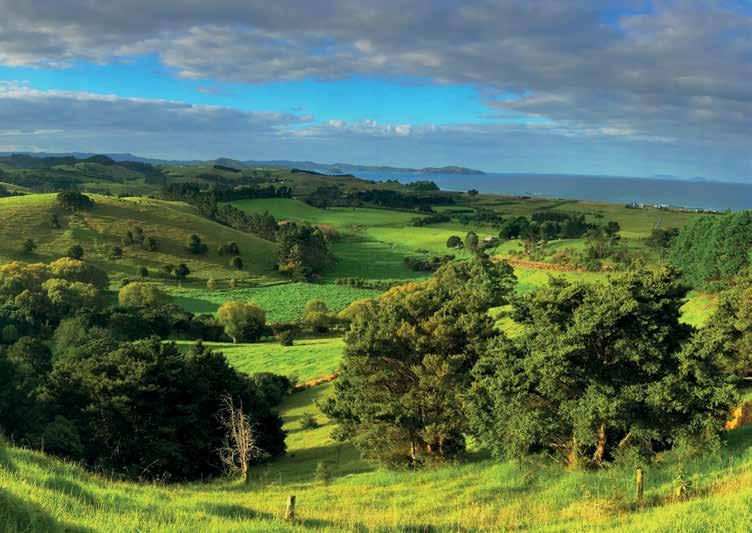
IN APRIL, STAFF FROM LEVIN-BASED DAVIS CONTRACTING ARRIVED AT POWER FARMING MANAWATU TO PICK UP THEIR FIVE NEW DEUTZ-FAHR TRACTORS.
Davis Contracting’s main services are baling, pit silage, cultivation and drilling. It is a well-rounded business that keeps 11 staff busy all year.
Gary Davis and his wife Lindsey own the company, and Gary explains why they made the big outlay to buy that number of tractors in one go.
With last year’s high machinery prices and interest rates and the low dairy pay-out, they held off updating gear. This season they decided to catch up and the result was an excellent deal from Power Farming for the five new tractors.
Davis Contracting actually got their first Deutz-Fahr, an M650 model, 12 years ago. Power Farming Manawatu dealer principal Stephen Alford was the driving factor.
“Stephen talked us into it. Once we had one, we kept buying more and we have now owned 12 Deutz-Fahrs.
“The back-up has been really good and they are good on fuel. They have been well priced and hold a good trade-in value so overall cost of ownership has been great.”
All of the new Deutz-Fahrs are in the 6 Series. Two are 185Gs (one with GPS and auto-steer), one is a 165G with a loader, and two are 145Gs, both with loaders.
“The more we looked at it, the more it made sense. They are all the same model line and have the same controls. We need one set of filters, one set of everything. Even the tyres are the same. It makes things easy,” Gary says.
Five at once has also eased driver friction. “With one new tractor, everyone wants to drive it. With five at once, everyone gets one.”
The trade-ins were a different brand and initially there were some questions among the staff about the move.
“We heard some moans about trading them in, but now the Deutz-Fahrs are here, they like them. They have been really positive.”
All have front suspension, a 50 kph road speed and an RC shift transmission. The RC transmission works in three modes – manual, with five ranges each with six speeds, semi-automatic, and fully automatic.
Gary says semi-automatic and fully automatic have a stop/go function that is awesome for loader work and round baling. He and the team usually work in auto mode, especially with the loader.
“We don’t use a clutch, just the brake pedals.”
The biggest tractor is the 185, which does the main ground work such as pulling a 4.6m pow-
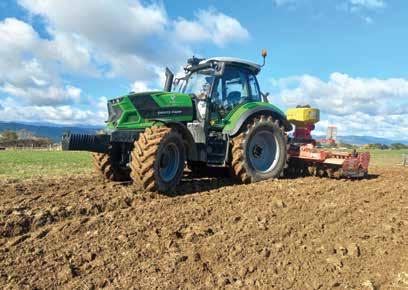
ALONG WITH A COMFORTABLE CAB, ALL OF DAVIS CONTRACTING’S FIVE NEW DEUTZ-FAHR TRACTORS HAVE FRONT SUSPENSION, 50 KPH ROAD SPEEDS AND AN RC SHIFT TRANSMISSION.
er harrow or 4.5m discs. It has a six-cylinder Deutz TCD engine with heaps of power, and a low demand for fuel. Gary optioned the highest hydraulic oil flow of 125 litres/min and the rear linkage lifts just over 9.7-tonnes.
Deutz-Fahr invests in research and development and continual improvement. Gary has noticed this with the front suspension.
“It is a step forward. The front suspension is a lot easier to grease and service, and it gives a nicer ride for people and machines.”
He also likes the new air-conditioning. “They have come a long way with the AC. There are a lot more air vents and colder air. The unit is up in the roof and more efficient.”
Cab layout has also improved. “It is more comfortable. It is nice and quiet and everything is well laid out. A new tractor always feels different, but it hasn’t taken long to get used to.”
He optioned extra LED lights on the front and back, which he says are phenomenal.
Service intervals are out to 500 hours and maintenance is straightforward. “The bonnet goes high and there is plenty of access around the engine.”
The best part of the deal is the peace of mind. Gary has five new,
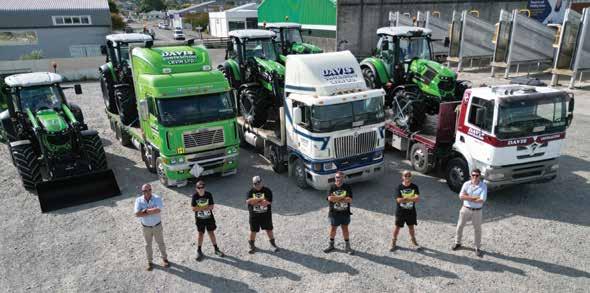
reliable tractors for a good price.
“As contractors we think we have to have particular brands, but there are lots of options that can make us better off financially and still get the job done as well and as comfortably.
“There are a lot of factors pushing our margins. We have got to take the blinkers off and be prudent with financials and get something that will work for us and our business.”
He says other brands he looked at would have cost significantly more for similar specs.
Another comfort is the back-up service. “Scott Drysdale in the workshop is a good knowledgeable guy. Power Farming gives an awesome back-up service. They stood behind our previous Deutz tractors, even when they were out of warranty. They went above and beyond to get us back out working,” Gary says.
Yet another comfort is Power Farming’s Deutz-Fahr Buy Back Guarantee.
“You know in advance what they will pay for the hours worked if you trade back in. I thought that was a good backstop. If a tractor didn’t quite fit what we wanted – maybe we needed something bigger or with higher specs – then we can trade it back.”
And there is always comfort in good relationships.
“We carry on the relationship with Power Farming. They are a good company with good values.”
GARY DAVIS SAYS ONE REASON HE WAS COMFORTABLE BUYING FIVE DEUTZ-FAHRS AT ONCE IS POWER FARMING’S BUY BACK GUARANTEE, WHICH MEANS HE KNOWS IN ADVANCE WHAT THE TRADEIN VALUE WILL BE.
There’s never been a better time to jump the fence. When you get into a new relationship with us, we’ll guarantee the future resale value of your Deutz-Fahr.
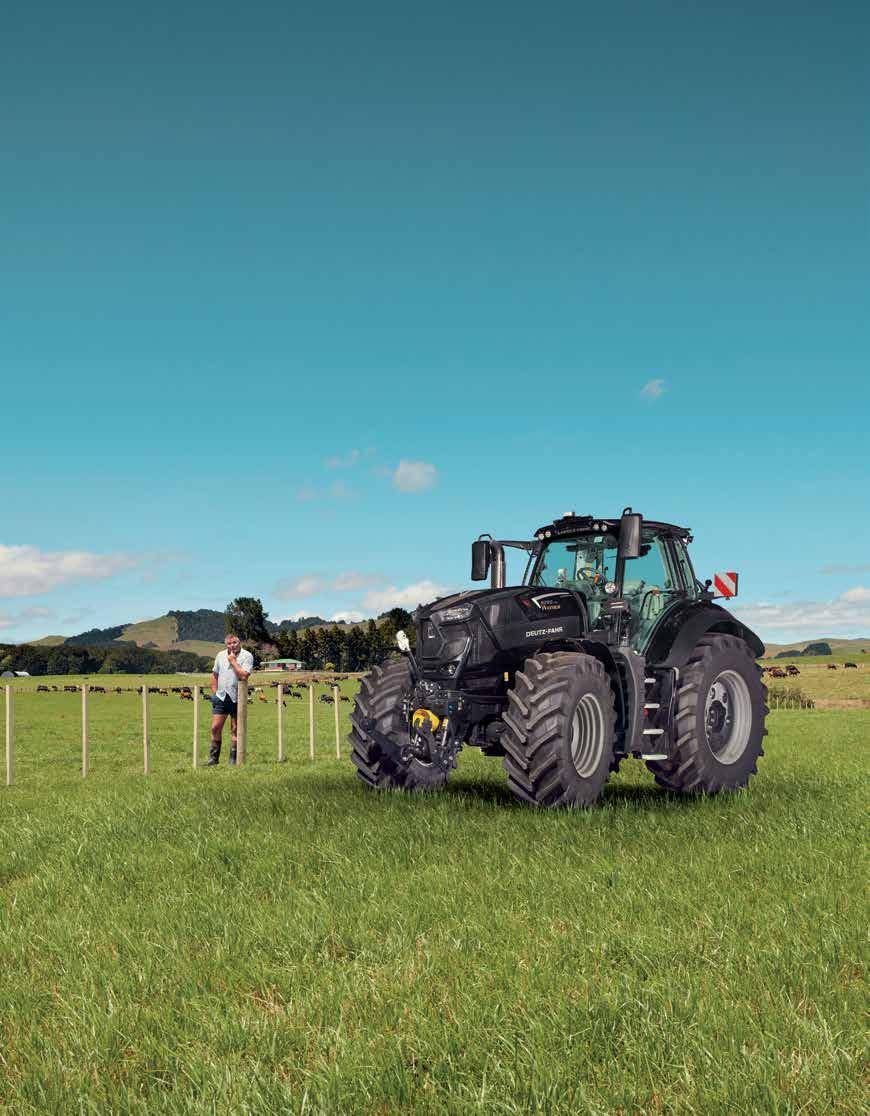
Tempted? Get in touch with your local Power Farming dealer today.
* Terms and conditions apply.
deutz nz
The JCB Series lll has taken telehandling to a new level. Redesigned and re-engineered from the ground up, the JCB Series lll has raised the bar - literally.
f All new CommandPlus cab provides the ultimate operator experience
f JCB EcoMAX engine provides fuel-efficient matching of transmission and hydraulics
f Smart Hydraulics package improves cycle times and reduces fuel consumption
f Designed to be productive, without compromising safety or comfort
f New Zealand’s #1 telehandler
*Standard CLAAS Financial Services lending criteria, terms, and conditions apply. 0.99% p.a requires a minimum 30% deposit followed by monthly repayments over 36 months, GST back in month 3. Offer applies to in-stock new JCB SERIES III LOADALL telehandlers only. If finance base rates move by more than 0.25%, CLAAS Financial Services reserve the right to re-quote. Offer valid until 31/07/2024 or while stocks last. Images illustrative only.